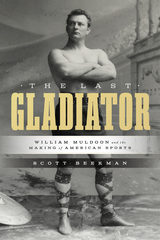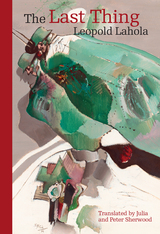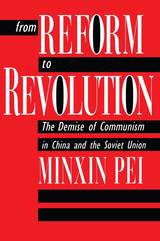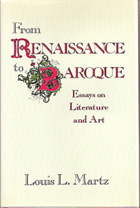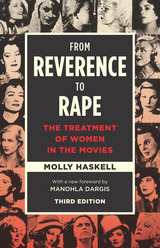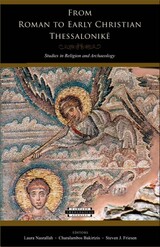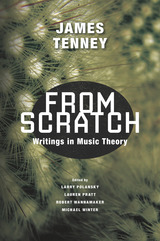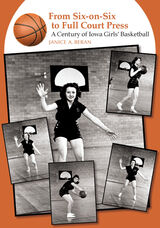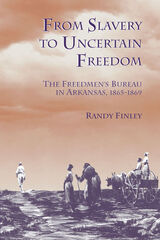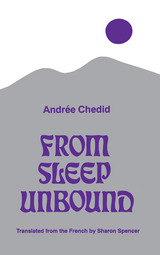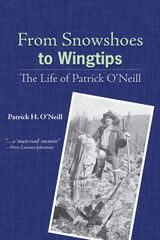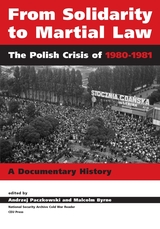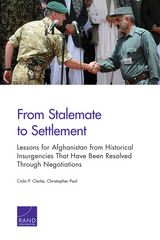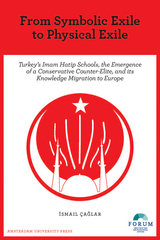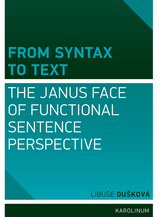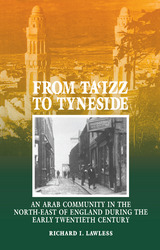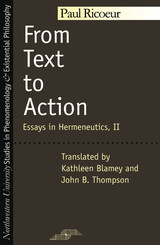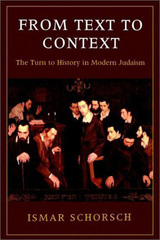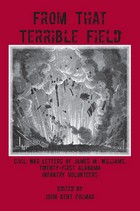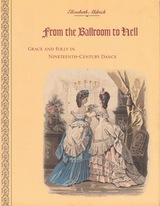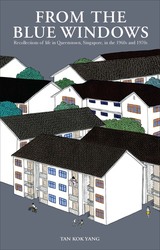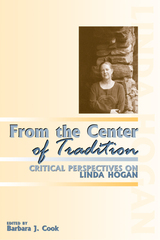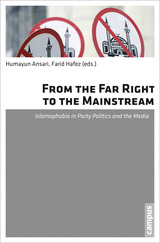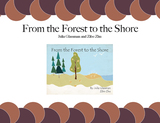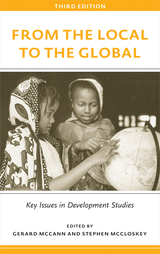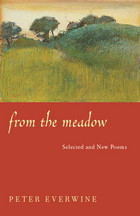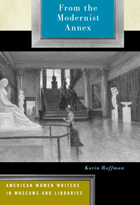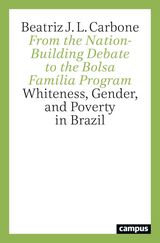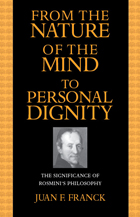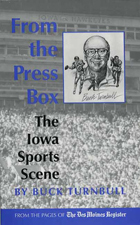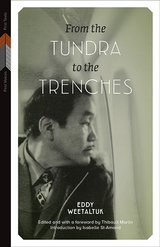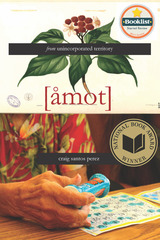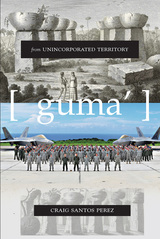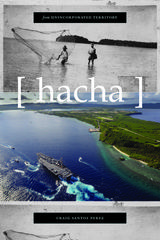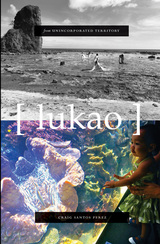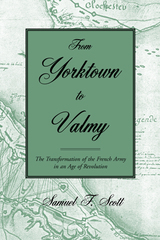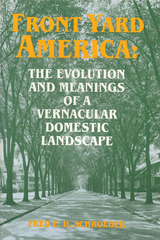From Quirky Case to Representing Space: Papers in Honor of Annie Zaenen
Edited by Tracy Holloway King and Valeria de Paiva
CSLI Annie Zaenen’s research has broadly influenced the field of linguistics from the underlying architecture of formal theories to the minute details of lexical representation. This volume assembles a wide range of essays from linguists who have been profoundly influenced by Zaenen’s work. Taking Zaenen as a model, the contributors explore a variety of topics, including the mapping of syntax onto argument and the relationship between syntax and semantics. From Quirky Case to Representing Space presents new research in linguistics, but also reasserts Zaenen’s crucial role in the evolution of linguistic theory.
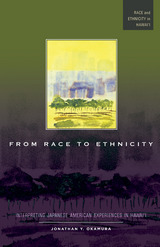 From Race to Ethnicity: Interpreting Japanese American Experiences in Hawai'i
Jonathan Y. Okamura
University of Hawaii Press, 2014 This is the first book in more than thirty years to discuss critically both the historical and contemporary experiences of Hawaii’s Japanese Americans. Given that race was the foremost organizing principle of social relations in Hawai‘i and was followed by ethnicity beginning in the 1970s, the book interprets these experiences from racial and ethnic perspectives. The transition from race to ethnicity is cogently demonstrated in the transformation of Japanese Americans from a highly racialized minority of immigrant laborers to one of the most politically and socioeconomically powerful ethnic groups in the islands.
To illuminate this process, the author has produced a racial history of Japanese Americans from their early struggles against oppressive working and living conditions on the sugar plantations to labor organizing and the rise to power of the Democratic Party following World War II. He goes on to analyze how Japanese Americans have maintained their political power into the twenty-first century and discusses the recent advocacy and activism of individual yonsei (fourth-generation Japanese Americans) working on behalf of ethnic communities other than their own.
From Race to Ethnicity resonates with scholars currently debating the relative analytical significance of race and ethnicity. Its novel analysis convincingly elucidates the differential functioning of race and ethnicity over time insofar as race worked against Japanese Americans and other non-Haoles (Whites) by restricting them from full and equal participation in society, but by the 1970s ethnicity would work fully in their favor as they gained greater political and economic power. The author reminds readers, however, that ethnicity has continued to work against Native Hawaiians, Filipino Americans, and other minorities—although not to the same extent as race previously—and thus is responsible for maintaining ethnic inequality in Hawai‘i.
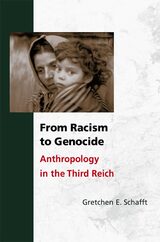 From Racism to Genocide: Anthropology in the Third Reich
Gretchen E. Schafft
University of Illinois Press, 2007 In paperback for the first time, From Racism to Genocide is an explosive, richly detailed account of how Nazi anthropologists justified racism, developed practical applications of racist theory, and eventually participated in every phase of the Holocaust. Using original sources and previously unpublished documentation, Gretchen E. Schafft shows the total range of anti-human activity from within the confines of a particular discipline. Based on seven years of archival research in the United States and abroad, the work includes many original photos and documents, most of which have never before been published. It uses primary data and original texts whenever possible, including correspondence written by perpetrators. The book also reveals that the United States was not merely a bystander in this research, but instead contributed professional and financial support to early racial research that continued through the first five years of Hitler’s regime.
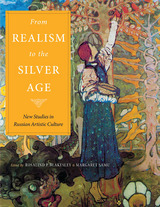 From Realism to the Silver Age: New Studies in Russian Artistic Culture
Rosalind P. Blakesley
Northern Illinois University Press, 2014 This volume of 13 essays presents rigorous new research by western and Russian scholars on Russian art of the 19th and early-20th centuries. Over More than three decades after the publication of Elizabeth Valkenier’s pioneering monograph, Russian Realist Art, this impressive collection showcases the latest methodology and subjects of inquiry, expanding the parameters of what has become an area of enormous intellectual and popular appeal. Major artists including Ilia Repin, Valentin Serov, and Wassily Kandinsky are considered afresh, as are the Peredvizhnik and Mir iskusstva movements and the Abramtsevo community. The book also breaks new ground to embrace subjects such as Russian graphic satire and children’s book illustration, as well as stimulating aspects of patronage and display.
Collectively, the essays include a range of approaches, from close textual readings to institutional critique. They also develop major themes inspired by Valkenier’s work, among them: the emergence and evolution of cultural institutions, the development of aesthetic discourse and artistic terminology, debates between the Academy of Arts and its challengers, art criticism and the Russian press, and the resonance of various forms of nationalism within the art world. These and other questions engage multiple disciplines—those of art history, Slavic Russian studies, and cultural history, among others—and promise to fuel a vibrant and ascendant field.
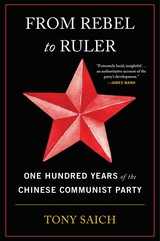 From Rebel to Ruler: One Hundred Years of the Chinese Communist Party
Tony Saich
Harvard University Press, 2021 A Project Syndicate Best Read of the Year
On the centennial of the founding of the Chinese Communist Party, the definitive history of how Mao and his successors overcame incredible odds to gain and keep power.
Mao Zedong and the twelve other young men who founded the Chinese Communist Party in 1921 could hardly have imagined that less than thirty years later they would be rulers. On its hundredth anniversary, the party remains in command, leading a nation primed for global dominance.
Tony Saich tells the authoritative, comprehensive story of the Chinese Communist Party—its rise to power against incredible odds, its struggle to consolidate rule and overcome self-inflicted disasters, and its thriving amid other communist parties’ collapse. Saich argues that the brutal Japanese invasion in the 1930s actually helped the party. As the Communists retreated into the countryside, they established themselves as the populist, grassroots alternative to the Nationalists, gaining the support they would need to triumph in the civil war. Once in power, however, the Communists faced the difficult task of learning how to rule. Saich examines the devastating economic consequences of Mao’s Great Leap Forward and the political chaos of the Cultural Revolution, as well as the party’s rebound under Deng Xiaoping’s reforms.
Leninist systems are thought to be rigid, yet the Chinese Communist Party has proved adaptable. From Rebel to Ruler shows that the party owes its endurance to its flexibility. But is it nimble enough to realize Xi Jinping’s “China Dream”? Challenges are multiplying, as the growing middle class makes new demands on the state and the ideological retreat from communism draws the party further from its revolutionary roots. The legacy of the party may be secure, but its future is anything but guaranteed.
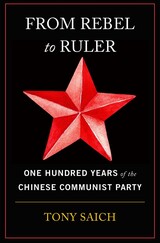 From Rebel to Ruler: One Hundred Years of the Chinese Communist Party
Tony Saich
Harvard University Press “The definitive, candid, and absorbing history of a political organization…A vital account, based on magnificent research, that shows the party as a colossal, relentless, and enduring machine.”—Jane Perlez, former Beijing Bureau Chief, New York Times
“If you were to travel back in time to 1921 and predict that the Communist Party of China would rule over the world’s second-largest economy 100 years later, no one would believe you. In this definitive primer, Tony Saich explains how the impossible came true.”—Yuen Yuen Ang, Project Syndicate
“An extremely lucid, insightful history of the Chinese Communist Party. Saich’s readable narrative takes the CCP from its origins as a tiny group of revolutionaries…to the powerful, repressive rulers of a world power today.”—James Mann, author of The China Fantasy
Mao Zedong and the twelve young men who founded the Chinese Communist Party in 1921 could hardly have imagined that less than thirty years later, they would rule China. Over a century later the party remains in command, leading a nation primed for global dominance.
From Rebel to Ruler is a landmark history of the Chinese Communist Party—its rise against incredible odds, its struggle to consolidate power and overcome self-inflicted disasters, and its ability to thrive long after the collapse of the Soviet Union and dissolution of other communist parties. Leninist systems are thought to be rigid, yet the Chinese Communist Party has proved adaptable. Tony Saich shows that the party owes its endurance to its flexibility. But is it nimble enough to realize Xi Jinping’s “China Dream”? Challenges are multiplying, as a restless middle class makes new demands and the party strays ever further from its revolutionary roots.
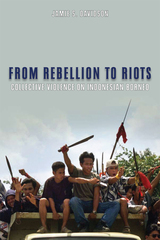 From Rebellion to Riots: Collective Violence on Indonesian Borneo
Jamie S. Davidson
University of Wisconsin Press, 2008 From Rebellion to Riots is a critical analysis of the roots of contemporary violence in one of Indonesia’s most ethnically heterogeneous provinces, West Kalimantan. Since the late 1960s, this province has suffered periodic outbreaks of ethnic violence among its Dayak, Malay, Madurese, and ethnic Chinese populations. Citing evidence from his research, internal military documents, and ethnographic accounts, Jamie S. Davidson refutes popular explanations for these flare-ups. The recurrent violence has less to do with a clash of cultures, the ills of New Order-led development, or indigenous marginalization than with the ongoing politicization of ethnic and indigenous identity in the region. Looking at key historical moments, markedly different in their particulars, Davidson reveals the important links between ethnic violence and subnational politics. In one case, army officers in Soeharto’s recently established New Order regime encouraged anti-Chinese sentiments. To move against communist-inspired rebellion, they recruited indigenous Dayaks to expunge tens of thousands of ethnic Chinese from interior towns and villages. This counter-insurgent bloodshed inadvertently initiated a series of clashes between Dayaks and Madurese, another migrant community. Driven by an indigenous empowerment movement and efforts by local elites to control benefits provided by decentralization and democratization, these low-intensity riots rose to immense proportions in the late 1990s. From Rebellion to Riots demonstrates that the endemic violence in this vast region is not the inevitable outcome of its ethnic diversity, and reveals that the initial impetus for collective bloodshed is not necessarily the same as the forces that sustain it.
“A comprehensive case study . . . . Essential reading for students of the West Kalimantan violence.”—Dave McRae, Indonesia
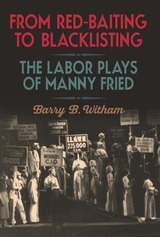 From Red-Baiting to Blacklisting: The Labor Plays of Manny Fried
Barry B. Witham
Southern Illinois University Press, 2020
Author Barry B. Witham reclaims the work of Manny Fried, an essential American playwright so thoroughly blacklisted after he defied the House Committee on Un-American Activities in 1954, and again in 1964, that his work all but completely disappeared from the canon. Witham details Manny Fried’s work inside and outside the theatre and examines his three major labor plays and the political climate that both nurtured and disparaged their productions. Drawing on never-before-published interview materials, Witham reveals the details of how the United States government worked to ruin Fried’s career.
From Red-Baiting to Blacklisting includes the complete text of Fried’s major labor plays, all long out of print. In Elegy for Stanley Gorski, Fried depicts one of the many red-baiting campaigns that threatened countless unions in the wake of the Taft-Hartley Act and the collusion of the Catholic Church with these activities. In Drop Hammer, Fried tackles the issues of union dues, misappropriation, and potential criminal activities. In the third play, The Dodo Bird, perhaps his most popular, Fried achieves a remarkable character study of a man outsourced from his job by technology and plant closures.
Manny Fried’s plays portray the hard edges of capitalism and government power and illuminate present-day struggles with hostility to labor unions and the passage in several states of right-to-work laws. Fried had no illusions about the government’s determination to destroy communism and unionism—causes to which he was deeply committed.
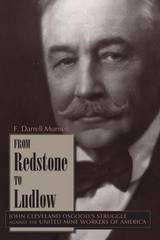 From Redstone to Ludlow: John Cleveland Osgood's Struggle against the United Mine Workers of America
F. Darrell Munsell
University Press of Colorado, 2009 The most comprehensive study of John Cleveland Osgood to date, From Redstone to Ludlow covers events from 1892, when Osgood and his associates organized the Colorado Fuel and Iron Company, to 1917, when Osgood signed a contract with the United Mine Workers of America, marking the end of his long history of battling the union. Called the Fuel King of the West, Osgood was the leading coal baron in the western mountain region and the most prominent spokesperson for the coal industry for over three decades. During this time, his anti-union policies made him the UMWA's most formidable foe in its effort to organize the Colorado coalfields.
From Redstone to Ludlow depicts the bipolarity of his approach to the threat of unionism. The "Redstone experiment," a model industrial village designed to improve the lives of workers through social programs, showed Osgood's efforts to attain his anti-union goals through compassion. Conversely, the Ludlow tent colony and the events that transpired there, marked by armed gunmen and machine guns paid for by Osgood, illustrate his willingness to resort to violence and intimidation for the same purpose. A leading participant in the transformation of the West, Osgood helped to shape the character of the Gilded Age. Today, the beautiful village of Redstone and a granite memorial at Ludlow are reminders of Osgood's complex role in the clash between labor and management during the most violent industrial struggle in American history.
From Reform to Revolution: The Demise of Communism in China and the Soviet Union
Minxin Pei
Harvard University Press, 1994 The demise of communism in the former Soviet Union and the massive political and economic changes in China are the stunning transformations of our century. Two central questions are emerging: Why did different communist systems experience different patterns of transition? Why did partial reforms in the Soviet Union and China turn into revolutions?
From Renaissance to Baroque: Essays on Literature and Art
Louis L. Martz
University of Missouri Press, 1991
Distinguished critic and scholar Louis L. Martz refreshingly addresses some of the central concerns in current studies of English poetry from the sixteenth and seventeenth centuries, exploring the context of religious controversy within which this poetry developed and the relationship of poetry to the visual arts.
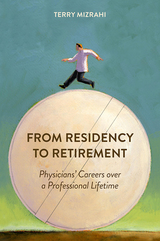 From Residency to Retirement: Physicians' Careers over a Professional Lifetime
Terry Mizrahi
Rutgers University Press, 2021 From Residency to Retirement tells the stories of twenty American doctors over the last half century, which saw a period of continuous, turbulent, and transformative changes to the U.S. health care system. The cohort’s experiences are reflective of the generation of physicians who came of age as presidents Carter and Reagan began to focus on costs and benefits of health services.
Mizrahi observed and interviewed these physicians in six timeframes ending in 2016. Beginning with medical school in the mid-1970s, these physicians reveal the myriad fluctuations and uncertainties in their professional practice, working conditions, collegial relationships, and patient interactions. In their own words, they provide a “view from the front lines” both in academic and community settings. They disclose the satisfactions and strains in coping with macro policies enacted by government and insurance companies over their career trajectory.
They describe their residency in internal medicine in a large southern urban medical center as a “siege mentality” which lessened as they began their careers, in Getting Rid of Patients, the title of Mizrahi’s first book (1986). As these doctors moved on in their professional lives more of their experiences were discussed in terms of dissatisfaction with financial remuneration, emotional gratification, and intellectual fulfillment. Such moments of career frustration, however, were also interspersed with moments of satisfaction at different stages of their medical careers. Particularly revealing was whether they were optimistic about the future at each stage of their career and whether they would recommend a medical career to their children. Mizrahi's subjects also divulge their private feelings of disillusionment and fear of failure given the malpractice epidemic and lawsuits threatened or actually brought against so many doctors. Mizrahi’s work, covering almost fifty years, provides rarely viewed insights into the lives of physicians over a professional life span.
From Revenue Sharing to Deficit Sharing: General Revenue Sharing and Cities
Bruce A. Wallin
Georgetown University Press, 1998 Once hailed as a revolutionary change in U.S. federal aid policy that would return power to state and local governments, General Revenue Sharing was politically dead a decade later. Bruce A. Wallin now offers the only complete history of the General Revenue Sharing program — why it passed, why state and local governments used it the way they did, and why it died. He examines its unique role in the history of U.S. federalism and explores its relevance to intergovernmental aid policy at the turn of a new century. This book is crucial to understanding the changed environment of U.S. intergovernmental relations in the 1990’s and makes a strong case for reconsidering a program of federal unrestricted aid.
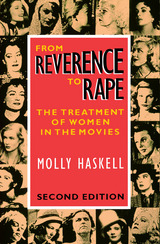 From Reverence to Rape: The Treatment of Women in the Movies
Molly Haskell
University of Chicago Press, 1987 For this edition of her classic study of the feminine role in film, Molly Haskell has written a new chapter addressing recent developments in the appearance and perception of women in the movies.
"An incisive, exceedingly thoughtful look at the distorted lens through which Hollywood has historically viewed women. It is a valuable contribution not just of film criticism but to a society in which the vital role of women is just beginning to emerge."—Christian Science Monitor
"Haskell is interested in women—how they are used in movies, how they use movies, and how the parts they play function as projections and verifications of our myths about women's lot and woman's psyche and even, lately, women's lib."—Jane Kramer, Village Voice
"In examining the goddesses worshipped by an entire nation, Molly Haskell reveals a good deal about our national character and our most cherished sexual myths. . . . Concerned with the deeply ingrained belief of women's inferiority, she analyzes movies as a social product as well as a social arbiter, and she effectively demonstrates how women are encouraged to impose limitations on themselves by fashioning those selves after flickering shadows in a darkened auditorium—sexual creatures who possess neither ability nor ambition beyond their bodies. . . . Both as an examination of film and as sociology, From Reverence to Rape is excellent."—Harriet Kriegel, The Nation
From Reverence to Rape: The Treatment of Women in the Movies, Third Edition
Molly Haskell
University of Chicago Press, 2016 A revolutionary classic of feminist cinema criticism, Molly Haskell’s From Reverence to Rape remains as insightful, searing, and relevant as it was the day it was first published. Ranging across time and genres from the golden age of Hollywood to films of the late twentieth century, Haskell analyzes images of women in movies, the relationship between these images and the status of women in society, the stars who fit these images or defied them, and the attitudes of their directors. This new edition features both a new foreword by New York Times film critic Manohla Dargis and a new introduction from the author that discusses the book’s reception and the evolution of her views.
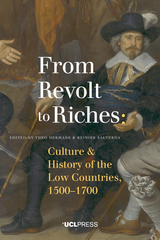 From Revolt to Riches: Culture and History of the Low Countries, 1500–1700
Edited by Theo Hermans, Reinier Salverda, and Ulrich Tiedau
University College London, 2017 This collection investigates the culture and history of the Low Countries in the 16th and 17th centuries from both international and interdisciplinary perspectives. The period was one of extraordinary upheaval and change, as the combined impact of Renaissance, Reformation and Revolt resulted in the radically new conditions – political, economic and intellectual – of the Dutch Republic in its Golden Age. While many aspects of this rich and nuanced era have been studied before, the emphasis of this volume is on a series of interactions and interrelations: between communities and their varying but often cognate languages; between different but overlapping spheres of human activity; between culture and history. The chapters are written by historians, linguists, bibliographers, art historians and literary scholars based in the Netherlands, Belgium, Great Britain and the United States. In continually crossing disciplinary, linguistic and national boundaries, while keeping the culture and history of the Low Countries in the Renaissance and Golden Age in focus, this book opens up new and often surprising perspectives on a region all the more intriguing for the very complexity of its entanglements.
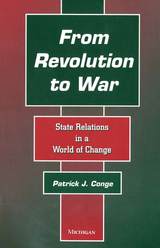 From Revolution to War: State Relations in a World of Change
Patrick J. Conge
University of Michigan Press, 2000 In the history of international relations, few events command as much attention as revolution and war. Over the centuries, revolutionary transformations have produced some of the most ruinous and bloody wars. Nevertheless, the breakdown of peace in time of revolution is poorly understood. Patrick Conge offers a groundbreaking study of the relationship between war and revolution.
How can we best understand the effect of revolutionary transformations on the politics of war and peace? Conge argues that it is only by bringing in, first, the organizational capacity of revolutionary regimes to extract resources and convert them into military strength and, second, the power of transformative ideas to transcend national boundaries and undermine the ability of opposing regimes to compromise that we are best able to understand the effect of revolution on the origins and persistence of war. By incorporating such key elements, this book provides a new, more comprehensive explanation of the relationship between revolution, war, and peace.
Conditions that lead to and sustain wars in general are identified and placed in the light of revolutionary transformations. Once the argument is presented, historical case studies are used to test its plausibility. Conge demonstrates the importance of the effect of revolutionary organization and ideas on the outcome of conflicts.
Political scientists, historians, sociologists, and the general reader interested in the politics of war and peace in revolutionary times are given new perspectives on the relationship between revolution and war as well as on the implications of political organization for military power and the process of consolidation of new regimes.
Patrick J. Conge is Assistant Professor of Political Science, University of Arkansas.
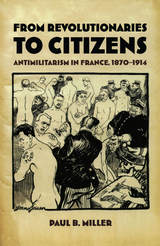 From Revolutionaries to Citizens: Antimilitarism in France, 1870–1914
Paul B. Miller
Duke University Press, 2002 From Revolutionaries to Citizens is the first comprehensive account of the most important antiwar campaign prior to World War I: the antimilitarism of the French Left. Covering the views and actions of socialists, trade unionists, and anarchists from the time of France’s defeat by Prussia in 1870 to the outbreak of hostilities with Germany in 1914, Paul B. Miller tackles a fundamental question of prewar historiography: how did the most antimilitarist culture and society in Europe come to accept and even support war in 1914? Although more general accounts of the Left’s “failure” to halt international war in August 1914 focus on its lack of unity or the decline of trade unionism, Miller contends that these explanations barely scratch the surface when it comes to interpreting the Left’s overwhelming acceptance of the war. By embedding his cultural analysis of antimilitarist propaganda into the larger political and diplomatic history of prewar Europe, he reveals the Left’s seemingly sudden transformation “from revolutionaries to citizens” as less a failure of resolve than a confession of commonality with the broader ideals of republican France. Examining sources ranging from police files and court records to German and British foreign office memos, Miller emphasizes the success of antimilitarism as a rallying cry against social and political inequities on behalf of ordinary citizens. Despite their keen awareness of the bloodletting that awaited Europe, he claims, antimilitarists ultimately accepted the war with Germany for the same reason they had pursued their own struggle within France: to address injustices and defend the rights of citizens in a democratic society.
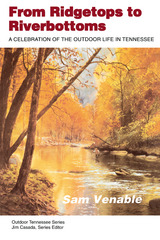 From Ridgetops To Riverbottoms: A Celebration of Outdoor Life in Tennessee
Sam Venable
University of Tennessee Press, 1995 From Ridgetops to Riverbottoms takes the reader on a journey down the many winding roads of the outdoor experience in Tennessee. Such a journey requires a seasoned guide, and there can be no better one than journalist Sam Venable, who has written about the woods and waters of his native state for the past twenty-five years.
For Venable, the outdoor world is meant to be enjoyed. Whether he is casting popping bugs to bluegills during the frenzy of a willow fly hatch, lying motionless on his back in muddy corn stubble as mallards warily circle his decoys, savoring the sounds and scents of a moonlit summer night when smallmouth bass are on the prowl, or issuing plaintive love calls to an amorous wild turkey gobbler, the author's fascination with outdoor recreation never diminishes. And, as the reader quickly finds, this fascination is contagious.
Along with the lightheartedness and rich humor in these pages, there is an unmistakable love of the land and a deep concern for the endangered bond between nature and humankind. Like the trout in the stream or the deer in the forest, Venable suggests, we are as much a product of the land as any living creature. And what affects one—for better or worse—ultimately affects all.
 From Rights to Lives: The Evolution of the Black Freedom Struggle
Edited by Françoise N. Hamlin and Charles W. McKinney Jr.
Vanderbilt University Press, 2024 Broadly speaking, the traditionally conceptualized mid-twentieth-century Civil Rights Movement and the newer #BlackLivesMatter Movement possess some similar qualities. They both represent dynamic, complex moments of possibility and progress. They also share mass-based movement activities, policy/legislative advocacy, grassroots organizing, and targeted media campaigns. Innovation, growth, and dissension—core aspects of movement work—mark them both. Crucially, these moments also engender aggressive, repressive, multilevel responses to these assertions of Black humanity.
From Rights to Lives critically engages the dynamic relationship between these two moments of liberatory possibility on the Black Freedom Struggle timeline. The book’s contributors explore what we can learn when we place these moments of struggle in dialogue with each other. They grapple with how our understanding of the postwar moment shapes our analysis of #BLM and wherein lie the discontinuities, in order to glean lessons for future moments of insurgency.
From Roman to Early Christian Thessalonikē: Studies in Religion and Archaeology
Laura Nasrallah
Harvard University Press, 2010 This volume brings together international scholars of religion, archaeologists, and scholars of art and architectural history to investigate social, political, and religious life in Roman and early Christian Thessalonikē, an important metropolis in the Hellenistic, Roman, and early Christian periods and beyond. This volume is the first broadly interdisciplinary investigation of Roman and early Christian Thessalonikē in English and offers new data and new interpretations by scholars of ancient religion and archaeology. The book covers materials usually treated by a broad range of disciplines: New Testament and early Christian literature, art historical materials, urban planning in antiquity, material culture and daily life, and archaeological artifacts from the Roman to the late antique period.
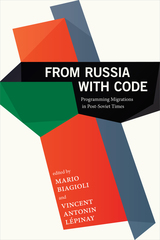 From Russia with Code: Programming Migrations in Post-Soviet Times
Mario Biagioli and Vincent Antonin Lepinay, editors
Duke University Press, 2019 While Russian computer scientists are notorious for their interference in the 2016 US presidential election, they are ubiquitous on Wall Street and coveted by international IT firms and often perceive themselves as the present manifestation of the past glory of Soviet scientific prowess. Drawing on over three hundred in-depth interviews, the contributors to From Russia with Code trace the practices, education, careers, networks, migrations, and lives of Russian IT professionals at home and abroad, showing how they function as key figures in the tense political and ideological environment of technological innovation in post-Soviet Russia. Among other topics, they analyze coders' creation of both transnational communities and local networks of political activists; Moscow's use of IT funding to control peripheral regions; brain drain and the experiences of coders living abroad in the United Kingdom, United States, Israel, and Finland; and the possible meanings of Russian computing systems in a heterogeneous nation and industry. Highlighting the centrality of computer scientists to post-Soviet economic mobilization in Russia, the contributors offer new insights into the difficulties through which a new entrepreneurial culture emerges in a rapidly changing world.
Contributors. Irina Antoschyuk, Mario Biagioli, Ksenia Ermoshina, Marina Fedorova, Andrey Indukaev, Alina Kontareva, Diana Kurkovsky, Vincent Lépinay, Alexandra Masalskaya, Daria Savchenko, Liubava Shatokhina, Alexandra Simonova, Ksenia Tatarchenko, Zinaida Vasilyeva, Dimitrii Zhikharevich
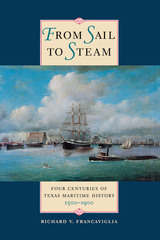 From Sail to Steam: Four Centuries of Texas Maritime History, 1500-1900
By Richard V. Francaviglia
University of Texas Press, 1998 Second Place, Presidio La Bahia Award, Sons of the Republic of Texas The Gulf Coast has been a principal place of entry into Texas ever since Alonso Alvarez de Pineda explored these shores in 1519. Yet, nearly five hundred years later, the maritime history of Texas remains largely untold. In this book, Richard V. Francaviglia offers a comprehensive overview of Texas' merchant and military marine history, drawn from his own extensive collection of maritime history materials, as well as from research in libraries and museums around the country. Based on recent discoveries in nautical archaeology, Francaviglia tells the stories of the Spanish flotilla that wrecked off Padre Island in 1554 and of La Salle's flagship Belle, which sank in 1687. He explores the role of the Texas Navy in the Texas Revolution of 1835-1836 and during the years of the Texas Republic and also describes the Civil War battles at Galveston and Sabine Pass. Finally, he recounts major developments of the nineteenth century, concluding with the disastrous Galveston Hurricane in 1900. More than one hundred illustrations, many never before published, complement the text.
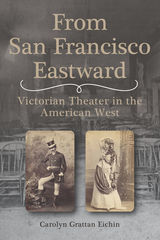 From San Francisco Eastward: Victorian Theater in the American West
Carolyn Grattan Eichin
University of Nevada Press, 2020 Finalist for the 2021 Willa Literary Award in Scholarly Non-Fiction
Finalist for the 2021 Will Rogers Medallion Award in Western Non-Fiction
Carolyn Grattan Eichin’s From San Francisco Eastward explores the dynamics and influence of theater in the West during the Victorian era. San Francisco, Eichin argues, served as the nucleus of the western theatrical world, having attained prominence behind only New York and Boston as the nation’s most important theatrical center by 1870. By focusing on the West’s hinterland communities, theater as a capitalist venture driven by the sale of cultural forms is illuminated against the backdrop of urbanization.
Using the vagaries of the West’s notorious boom-bust economic cycles, Eichin traces the fiscal, demographic, and geographic influences that shaped western theater. With an emphasis on the 1860s and 70s, this thoroughly researched work uses distinct notions of ethnicity, class, and gender to examine a cultural institution driven by a market economy. From San Francisco Eastward is a thorough analysis of the ever-changing theatrical personalities and strategies that shaped Victorian theater in the West, and the ways in which theater as a business transformed the values of a region.
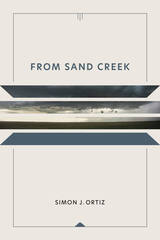 from Sand Creek
Simon J. Ortiz
University of Arizona Press, 2000 The massacre of Cheyenne and Arapaho women and children by U.S. soldiers at Sand Creek in 1864 was a shameful episode in American history, and its battlefield was proposed as a National Historic Site in 1998 to pay homage to those innocent victims. Poet Simon Ortiz had honored those people seventeen years earlier in his own way. That book, from Sand Creek, is now back in print.
Originally published in a small-press edition, from Sand Creek makes a large statement about injustices done to Native peoples in the name of Manifest Destiny. It also makes poignant reference to the spread of that ambition in other parts of the world—notably in Vietnam—as Ortiz asks himself what it is to be an American, a U.S. citizen, and an Indian. Indian people have often felt they have had no part in history, Ortiz observes, and through his work he shows how they can come to terms with this feeling. He invites Indian people to examine the process they have experienced as victims, subjects, and expendable resources—and asks people of European heritage to consider the motives that drive their own history and create their own form of victimization.
Through the pages of this sobering work, Ortiz offers a new perspective on history and on America. Perhaps more important, he offers a breath of hope that our peoples might learn from each other:
This America
has been a burden
of steel and mad
death,
but, look now,
there are flowers
and new grass
and a spring wind
rising
from Sand Creek.
 From Sand to Circuits: And Other Inquiries
John J. Simon, Jr.
Harvard University Press, 1986 The Harvard University Information Technology Quarterly (formerly Newsletter), from which this collection of articles has been drawn, is highly regarded both for its wide range of exploration and for the depth of its discussion of new and emerging computer-related technologies. Included in this book are articles covering the origin and development of semiconductor technology, the microprocessor, telephony, xerography, electronic typesetting, videodisc technology, computer graphics, artificial intelligence, and robotics.
This book also discusses the impact of information technology on the university and the university library and continues an examination of information technology's role in the educational process. Each of the articles provides historical background and attractive illustrations that enrich the reader's understanding. From Sand to Circuits is both a fascinating compendium of models for understanding information technology and a lucid, highly enjoyable collection of essays.
 From Sandlots to the Super Bowl: The National Football League, 1920-1967
Craig R. Coenen
University of Tennessee Press, 2005 The National Football League that celebrated its first Super Bowl in 1967 bore scant resemblance to the league of its obscure origins. In its earliest years, the league was a ragtag collection of locally supported small-town teams that generated attention only in the locales in which they played, if they were lucky. Many teams received no support at all. Only after enduring a slow, often treacherous, journey did the enterprise of professional football reach its position as the king of the sports world by the late 1960s. In From Sandlots to the Super Bowl, Craig R. Coenen recounts the NFL’s ascension from a cash-strapped laughingstock to a perennial autumn obsession for millions of sports fans. It offers an in-depth summary of the NFL’s early years and its struggles to build an identity. This book shows how the fledgling NFL of the 1920s and 1930s attempted to build support both on a local and national scale. Considered a sport of hooligans and lower-class athletes, professional football paled in comparison to the reputations of competing sports such as college football and professional baseball. Even more difficult for the league, developing civic support for franchises proved an almost impossible task. Teams would spring up and disappear overnight, generating hardly any notice among sports fans.Coenen shows how the league’s survival depended on small town franchises being able to tap into the civic pride and larger economic interests of nearby, growing urban centers. This book also details how the league faced challenges from rival leagues, the government, and at times, itself. Finally, it documents how the NFL mastered the use of new technologies like television to market itself, generate new revenue, and secure its financial future.This book approaches the history of the National Football League not only with stats and scores but with what happened beyond the gridiron. Starting in Canton and Massillon and ending in Los Angeles with Super Bowl I, From Sandlots to the Super Bowl offers an entertaining and absorbing look at the first five decades of America’s most popular professional sport.
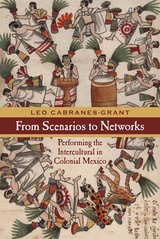 From Scenarios to Networks: Performing the Intercultural in Colonial Mexico
Leo Cabranes-Grant
Northwestern University Press, 2016 In this innovative study, Leo Cabranes-Grant analyzes four intercultural events in the Viceroyalty of New Spain that took place between 1566 and 1690. Rather than relying on racial labels to describe alterations of identity, Cabranes-Grant focuses on experimentation, rehearsal, and the interaction between bodies and objects. His analysis shows how scenarios are invested with affective qualities, which in turn enable cultural and semiotic change. Central to his argument is Bruno Latour’s Actor-Network Theory, which figures society as a constantly evolving web of relationships among objects, people, and spaces. In examining these scenarios, Cabranes-Grant attempts to discern the reasons why the conditions of an intensified moment within this ceaseless flow take on a particular value and inspire their re-creation. Cabranes-Grant offers a fresh perspective on Latour’s theory and reorients debates concerning history and historiography in the field of performance studies.
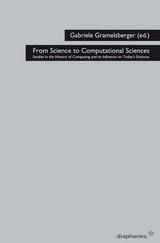 From Science to Computational Sciences: Studies in the History of Computing and its Influence on Today‘s Sciences
Edited by Gabriele Gramelsberger
Diaphanes, 2011 In 1946 John von Neumann stated that science is stagnant along the entire front of complex problems, proposing the use of largescale computing machines to overcome this stagnation. In other words, Neumann advocated replacing analytical methods with numerical ones. The invention of the computer in the 1940s allowed scientists to realise numerical simulations of increasingly complex problems like weather forecasting, and climate and molecular modelling. Today, computers are widely used as computational laboratories, shifting science toward the computational sciences. By replacing analytical methods with numerical ones, they have expanded theory and experimentation by simulation.
During the last decades hundreds of computational departments have been established all over the world and countless computer-based simulations have been conducted. This volume explores the epoch-making influence of automatic computing machines on science, in particular as simulation tools.
From Scratch: Writings in Music Theory
James TenneyEdited by Larry Polansky, Lauren Pratt, Robert Wannamaker, and Michael Winter
University of Illinois Press, 2019 One of the twentieth century's most important musical thinkers, James Tenney did pioneering work in multiple fields, including computer music, tuning theory, and algorithmic and computer-assisted composition. From Scratch arranges, edits, and revises Tenney's hard-to-find writings into one indispensable collection. Selections focus on his fundamental concerns—"what the ear hears"—and include thoughts and ideas on perception and form, tuning systems and especially just intonation, information theory, theories of harmonic space, and stochastic (chance) procedures of composition.
 From Sea Charts to Satellite Images: Interpreting North American History through Maps
Edited by David Buisseret
University of Chicago Press, 1990 "The authors write authoritatively and crisply . . . . How to use maps in teaching is spelled out carefully, but the authors also manage to sketch in the background of American mapping so the book is both a manual and a history. Commentaries are sprinkled with stimulating new ideas, for instance on how to use bird's-eye views and country atlases in the classroom, and there are didactic discussions on maps showing the walking city and the impact of the street car.
"An extraordinarily wide range of maps is depicted, which makes for good browsing, pondering and close study. . . . This is a very good, highly attractive, and worthwhile book; it will have great impact on the use of old (and new!) maps in teaching. As well, this is a tantalizing survey of mapping the United States and will whet the appetites of students and encourage them to learn more about maps and their origins."—John Warketin, Cartographica
 From Shakespeare to Autofiction: Approaches to Authorship after Barthes and Foucault
Edited by Martin Procházka
University College London, 2024 A critical examination of authorship that traces its historical evolution and asserts its significance from early to late modernity.
From Shakespeare to Autofiction focuses on salient features of authorship throughout modernity, ranging from transformations of oral tradition and the roles of empirical authors, through collaborative authorship and authorship as cultural capital, to the shifting roles of authors in recent autobiographical and biographical fiction. In response to Roland Barthes’s “removal of the Author” and its substitution by Michel Foucault’s “author function,” different historical forms of modern authorship are approached as multiplicities integrated by agency, performativity, and intensity in the theories of Pierre Bourdieu, Wolfgang Iser, Gilles Deleuze, and Félix Guattari.
The book offers a critical reassessment of recent debates on authorship in European and Latin American literature. It demonstrates that the outcomes of these debates need wider theoretical and methodological reflections, ones that take into account the historical development of authorship and shifting understandings of fiction, performativity, and new media. Individual chapters trace significant moments in the history of authorship from early modernity to the present (from Shakespeare’s First Folio to Latin American experimental autobiographical fiction), and discuss the methodologies that reinstate the author and authorship as the irreducible aspects of the literary process. It is essential reading for scholars and enthusiasts of literature seeking a deeper understanding of how authorship has evolved and continues to shape literary landscapes.
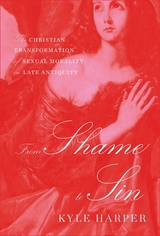 From Shame to Sin: The Christian Transformation of Sexual Morality in Late Antiquity
Kyle Harper
Harvard University Press, 2013 When Rome was at its height, an emperor’s male beloved, victim of an untimely death, would be worshipped around the empire as a god. In this same society, the routine sexual exploitation of poor and enslaved women was abetted by public institutions. Four centuries later, a Roman emperor commanded the mutilation of men caught in same-sex affairs, even as he affirmed the moral dignity of women without any civic claim to honor. The gradual transformation of the Roman world from polytheistic to Christian marks one of the most sweeping ideological changes of premodern history. At the center of it all was sex. Exploring sources in literature, philosophy, and art, Kyle Harper examines the rise of Christianity as a turning point in the history of sexuality and helps us see how the roots of modern sexuality are grounded in an ancient religious revolution.
While Roman sexual culture was frankly and freely erotic, it was not completely unmoored from constraint. Offending against sexual morality was cause for shame, experienced through social condemnation. The rise of Christianity fundamentally changed the ethics of sexual behavior. In matters of morality, divine judgment transcended that of mere mortals, and shame—a social concept—gave way to the theological notion of sin. This transformed understanding led to Christianity’s explicit prohibitions of homosexuality, extramarital love, and prostitution. Most profound, however, was the emergence of the idea of free will in Christian dogma, which made all human action, including sexual behavior, accountable to the spiritual, not the physical, world.
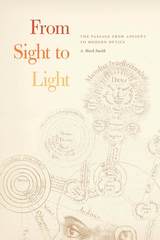 From Sight to Light: The Passage from Ancient to Modern Optics
A. Mark Smith
University of Chicago Press, 2014 From its inception in Greek antiquity, the science of optics was aimed primarily at explaining sight and accounting for why things look as they do. By the end of the seventeenth century, however, the analytic focus of optics had shifted to light: its fundamental properties and such physical behaviors as reflection, refraction, and diffraction. This dramatic shift—which A. Mark Smith characterizes as the “Keplerian turn”—lies at the heart of this fascinating and pioneering study.
Breaking from previous scholarship that sees Johannes Kepler as the culmination of a long-evolving optical tradition that traced back to Greek antiquity via the Muslim Middle Ages, Smith presents Kepler instead as marking a rupture with this tradition, arguing that his theory of retinal imaging, which was published in 1604, was instrumental in prompting the turn from sight to light. Kepler’s new theory of sight, Smith reveals, thus takes on true historical significance: by treating the eye as a mere light-focusing device rather than an image-producing instrument—as traditionally understood—Kepler’s account of retinal imaging helped spur the shift in analytic focus that eventually led to modern optics.
A sweeping survey, From Sight to Light is poised to become the standard reference for historians of optics as well as those interested more broadly in the history of science, the history of art, and cultural and intellectual history.
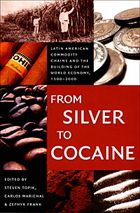 From Silver to Cocaine: Latin American Commodity Chains and the Building of the World Economy, 1500–2000
Steven Topik, Carlos Marichal, and Zephyr Frank, eds.
Duke University Press, 2006 Demonstrating that globalization is a centuries-old phenomenon, From Silver to Cocaine examines the commodity chains that have connected producers in Latin America with consumers around the world for five hundred years. In clear, accessible essays, historians from Latin America, England, and the United States trace the paths of many of Latin America’s most important exports: coffee, bananas, rubber, sugar, tobacco, silver, henequen (fiber), fertilizers, cacao, cocaine, indigo, and cochineal (insects used to make dye). Each contributor follows a specific commodity from its inception, through its development and transport, to its final destination in the hands of consumers. The essays are arranged in chronological order, according to when the production of a particular commodity became significant to Latin America’s economy. Some—such as silver, sugar, and tobacco—were actively produced and traded in the sixteenth century; others—such as bananas and rubber—only at the end of the nineteenth century; and cocaine only in the twentieth. By focusing on changing patterns of production and consumption over time, the contributors reconstruct complex webs of relationships and economic processes, highlighting Latin America’s central and interactive place in the world economy. They show how changes in coffee consumption habits, clothing fashions, drug usage, or tire technologies in Europe, Asia, and the Americas reverberate through Latin American commodity chains in profound ways. The social and economic outcomes of the continent’s export experience have been mixed. By analyzing the dynamics of a wide range of commodities over a five-hundred-year period, From Silver to Cocaine highlights this diversity at the same time that it provides a basis for comparison and points to new ways of doing global history. Contributors. Marcelo Bucheli, Horacio Crespo, Zephyr Frank, Paul Gootenberg, Robert Greenhill, Mary Ann Mahony, Carlos Marichal, David McCreery, Rory Miller, Aldo Musacchio, Laura Nater, Ian Read, Mario Samper, Steven Topik, Allen Wells
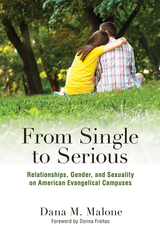 From Single to Serious: Relationships, Gender, and Sexuality on American Evangelical Campuses
Malone, Dana M.
Rutgers University Press, 2018 College students hook up and have sex. That is what many students expect to happen during their time at university—it is part of growing up and navigating the relationship scene on most American campuses today. But what do you do when you’re a student at an evangelical university? Students at these schools must negotiate a barrage of religiously imbued undercurrents that impact how they think about relationships, in addition to how they experience and evaluate them. As they work to form successful unions, students at evangelical colleges balance sacred ideologies of purity, holiness, and godliness, while also dealing with more mainstream notions of popularity, the online world, and the appeal of sexual intimacy.
In From Single to Serious, Dana M. Malone shines a light on friendship, dating, and, sexuality, in both the ideals and the practical experiences of heterosexual students at U. S. evangelical colleges. She examines the struggles they have in balancing their gendered and religious presentations of self, the expectations of their campus community, and their desire to find meaningful romantic relationships.
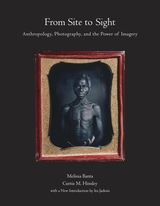 From Site to Sight: Anthropology, Photography, and the Power of Imagery, Thirtieth Anniversary Edition
Melissa Banta and Curtis M. HinsleyWith a New Introduction by Ira Jackins
Harvard University Press In 1986 the Peabody Museum of Archaeology and Ethnology at Harvard mounted From Site to Sight, a groundbreaking traveling exhibition on the historic and contemporary uses of photography in anthropology. Using visual materials from the vast photographic archives of the Peabody Museum and the work of members of Harvard’s anthropology department, the accompanying catalog investigates how anthropologists have employed the camera as a recording and analytic tool and as an aesthetic medium. Photographs ranging from daguerreotypes to satellite images are presented in an examination of the possibilities and limitations of using the camera as a fact-gathering and interpretive tool. The authors also explore the broader implications of the uses—and misuses—of visual imagery within the human sciences.
From Site to Sight has been a foundational text for scholars and students in the developing field of visual anthropology, illustrating the role of photographic imagery in anthropology and archaeology from the disciplines’ formative years to the 1980s. Long out of print, this classic publication is now available in an enhanced thirtieth anniversary edition with a new introductory essay by Ira Jacknis.
From Six-on-Six to Full Court Press: A Century of Iowa Girls' Basketball
Janice A. Beran
University of Iowa Press, 1993 “From Six-on-Six to Full Court Press is a complete history of Iowa women’s high school, college, and recreational basketball. Beran’s exhaustive research . . . covers legendary players and coaches, changes in rules, stats on Iowa girls’ high school records, alterations in playing styles and uniforms, along with the heart-stopping excitement of the state tournament.”—Hoop Source
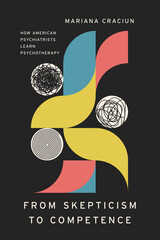 From Skepticism to Competence: How American Psychiatrists Learn Psychotherapy
Mariana Craciun
University of Chicago Press, 2024 An examination of how novice psychiatrists come to understand the workings of the mind—and the nature of medical expertise—as they are trained in psychotherapy.
While many medical professionals can physically examine the body to identify and understand its troubles—a cardiologist can take a scan of the heart, an endocrinologist can measure hormone levels, an oncologist can locate a tumor—psychiatrists have a much harder time unlocking the inner workings of the brain or its metaphysical counterpart, the mind.
In From Skepticism to Competence, sociologist Mariana Craciun delves into the radical uncertainty of psychiatric work by following medical residents in the field as they learn about psychotherapeutic methods. Most are skeptical at the start. While they are well equipped to treat brain diseases through prescription drugs, they must set their expectations aside and learn how to navigate their patients’ minds. Their instructors, experienced psychotherapists, help the budding psychiatrists navigate this new professional terrain by revealing the inner workings of talk and behavioral interventions and stressing their utility in a world dominated by pharmaceutical treatments. In the process, the residents examine their own doctoring assumptions and develop new competencies in psychotherapy. Exploring the world of contemporary psychiatric training, Craciun illuminates novice physicians’ struggles to understand the nature and meaning of mental illness and, with it, their own growing medical expertise.
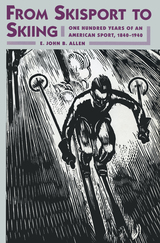 From Skisport to Skiing: One Hundred Years of an American Sport, 1840-1940
E. John B. Allen
University of Massachusetts Press, 1993 The first full-length study of skiing in the United States, this book traces the history of the sport from its utilitarian origins to its advent as a purely recreational and competitive activity.
During the mid-1800s, inhabitants of frontier mining communities in the Sierra and Rocky mountains used skis for many practical reasons, including mail and supply delivery, hunting, and railroad repair. In some towns skis were so common that, according to one California newspaper, "the ladies do nearly all their shopping and visiting on them."
But it was Norwegian immigrants in the Midwest, clinging to their homeland traditions, who first organized the skisport. Through the founding of local clubs and the National Ski Association, this ethnic group dominated American skiing until the 1930s.
At this time, a wave of German immigrants infused America with the ethos of what we today call Alpine skiing. This type of skiing became increasingly popular, especially in the East among wealthy collegians committed to the romantic pursuit of the "strenuous life." Ski clubs proliferated in towns and on college campuses and specialized resorts cropped up from New England to California. At the same time, skiing became mechanized with tows and lifts, and the blossoming equipment and fashion industries made a business of the sport.
On the eve of World War II, as the book concludes its story, all the elements were in place for the explosion in recreational and competitive skiing that erupted after 1945.
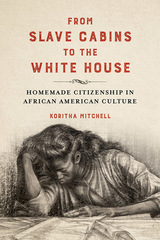 From Slave Cabins to the White House: Homemade Citizenship in African American Culture
Koritha Mitchell
University of Illinois Press, 2021 Koritha Mitchell analyzes canonical texts by and about African American women to lay bare the hostility these women face as they invest in traditional domesticity. Instead of the respectability and safety granted white homemakers, black women endure pejorative labels, racist governmental policies, attacks on their citizenship, and aggression meant to keep them in "their place." Tracing how African Americans define and redefine success in a nation determined to deprive them of it, Mitchell plumbs the works of Frances Harper, Zora Neale Hurston, Lorraine Hansberry, Toni Morrison, Michelle Obama, and others. These artists honor black homes from slavery and post-emancipation through the Civil Rights era to "post-racial" America. Mitchell follows black families asserting their citizenship in domestic settings while the larger society and culture marginalize and attack them, not because they are deviants or failures but because they meet American standards. Powerful and provocative, From Slave Cabins to the White House illuminates the links between African American women's homemaking and citizenship in history and across literature.
 From Slave Ship to Supermax: Mass Incarceration, Prisoner Abuse, and the New Neo-Slave Novel
Patrick Elliot Alexander
Temple University Press, 2017 In his cogent and groundbreaking book, From Slave Ship to Supermax, Patrick Elliot Alexander argues that the disciplinary logic and violence of slavery haunt depictions of the contemporary U.S. prison in late twentieth-century Black fiction. Alexander links representations of prison life in James Baldwin’s novel If Beale Street Could Talk to his engagements with imprisoned intellectuals like George Jackson, who exposed historical continuities between slavery and mass incarceration. Likewise, Alexander reveals how Toni Morrison’s Beloved was informed by Angela Y. Davis’s jail writings on slavery-reminiscent practices in contemporary women’s facilities. Alexander also examines recurring associations between slave ships and prisons in Charles Johnson’s Middle Passage, and connects slavery’s logic of racialized premature death to scenes of death row imprisonment in Ernest Gaines’ A Lesson Before Dying. Alexander ultimately makes the case that contemporary Black novelists depict racial terror as a centuries-spanning social control practice that structured carceral life on slave ships and slave plantations—and that mass-produces prisoners and prisoner abuse in post–Civil Rights America. These authors expand free society’s view of torment confronted and combated in the prison industrial complex, where discriminatory laws and the institutionalization of secrecy have reinstated slavery’s system of dehumanization.
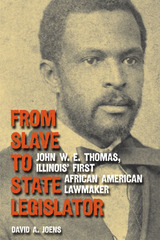 From Slave to State Legislator: John W. E. Thomas, Illinois' First African American Lawmaker
David A. Joens
Southern Illinois University Press, 2012 Illinois State Historical Society Superior Achievement Award, 2013
As the first African American elected to the Illinois General Assembly, John W. E. Thomas was the recognized leader of the state’s African American community for nearly twenty years and laid the groundwork for the success of future Black leaders in Chicago politics. Despite his key role in the passage of Illinois’ first civil rights act and his commitment to improving his community against steep personal and political barriers, Thomas’s life and career have been long forgotten by historians and the public alike. This fascinating full-length biography—the first to address the full influence of Thomas or any Black politician from Illinois during the Reconstruction Era—is also a pioneering effort to explain the dynamics of African American politics and divisions within the Black community in post–Civil War Chicago. In From Slave to State Legislator, David A. Joens traces Thomas’s trajectory from a slave owned by a doctor’s family in Alabama to a prominent attorney believed to be the wealthiest African American man in Chicago at the time of his death in 1899. Providing one of the few comprehensive looks at African Americans in Chicago during this period, Joens reveals how Thomas’s career represents both the opportunities available to African Americans in the postwar period and the limits still placed on them. When Thomas moved to Chicago in 1869, he started a grocery store, invested in real estate, and founded the first private school for African Americans before becoming involved in politics. From Slave to State Legislator provides detailed coverage of Thomas’s three terms in the legislature during the 1870s and 1880s, his multiple failures to be nominated for reelection, and his loyalty to the Republican Party at great political cost, calling attention to the political differences within a Black community often considered small and homogenous. Even after achieving his legislative legacy—the passage of the first state civil rights law—Thomas was plagued by patronage issues and an increasingly bitter split with the African American community frustrated with slow progress toward true equality. Drawing on newspapers and an array of government documents, Joens provides the most thorough review to date of the first civil rights legislation and the two controversial “colored conventions” chaired by Thomas. Joens cements Thomas’s legacy as a committed and conscientious lawmaker amid political and personal struggles. In revealing the complicated rivalries and competing ambitions that shaped Black northern politics during the Reconstruction Era, Joens shows the long-term impact of Thomas’s friendship with other burgeoning African American political stars and his work to get more black representatives elected. The volume is enhanced by short biographies of other key Chicago African American politicians of the era.
From Slavery to Uncertain Freedom: The Freedman's Bureau in Arkansas 1865-1869
Randy Finley
University of Arkansas Press, 1996 As African Americans in Arkansas emerged from slavery in the aftermath of the Civil War and the Emancipation Proclamation, it was the job o the Federal Freedmen's Bureau to help them build bridges to freedom. The bureau supported former slaves as they assumed new names, searched for lost family members, moved to new homes, worked to provide for their families, learned to read and write, formed and attended their own churches, created their own histories and myths, and struggled to obtain land.
In this account of hte gains made by Arkansas freedman during this period, Randy Finley describes the ways that blacks, whites, and bureau officials undertook their foles in a new society and began to live the complex reality of freedom.
1996 Certificate of Commendation American Association for State and Local History
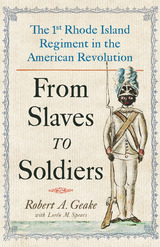 From Slaves to Soldiers: The 1st Rhode Island Regiment in the American Revolution
Robert Geake
Westholme Publishing, 2024 Known as the “Black” Regiment, the Story of the First Continental Army Unit Composed of African American and Native American Enlisted Men
In December 1777, the Continental army was encamped at Valley Forge and faced weeks of cold and hunger, as well as the prospect of many troops leaving as their terms expired in the coming months. If the winter were especially cruel, large numbers of soldiers would face death or contemplate desertion. Plans were made to enlist more men, but as the states struggled to fill quotas for enlistment, Rhode Island general James Mitchell Varnum proposed the historic plan that a regiment of slaves might be recruited from his own state, the smallest in the union, but holding the largest population of slaves in New England. The commander-in-chief’s approval of the plan would set in motion the forming of the 1st Rhode Island Regiment. The “black regiment,” as it came to be known, was composed of indentured servants, Narragansett Indians, and former slaves. This was not without controversy. While some in the Rhode Island Assembly and in other states railed that enlisting slaves would give the enemy the impression that not enough white men could be raised to fight the British, owners of large estates gladly offered their slaves and servants, both black and white, in lieu of a son or family member enlisting. The regiment fought with distinction at the battle of Rhode Island, and once joined with the 2nd Rhode Island before the siege of Yorktown in 1781, it became the first integrated battalion in the nation’s history. In From Slaves to Soldiers: The 1st Rhode Island Regiment in the American Revolution, historian Robert A. Geake tells the important story of the “black regiment” from the causes that led to its formation, its acts of heroism and misfortune, as well as the legacy left by those men who enlisted to earn their freedom.
From Sleep Unbound
Andrée Chedid
Ohio University Press, 1983 From Sleep Unbound portrays the life of Samya, an Egyptian woman who is taken at age 15 from her Catholic boarding school and forced into a loveless and humiliating marriage. Eventually sundered from every human attachment, Samya lapses into despair and despondence, and finally an emotionally caused paralysis. But when she shakes off the torpor of sleep, the sleep of avoidance, she awakens to action with the explosive energy of one who has been reborn.
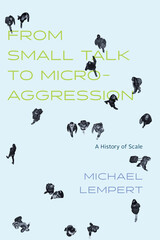 From Small Talk to Microaggression: A History of Scale
Michael Lempert
University of Chicago Press, 2024 A provocative and eye-opening history of how we have studied and theorized social interaction.
In this ambitious, wide-ranging book, anthropologist Michael Lempert offers a conceptual history that explores how, why, and with what effects we have come to think of interactions as “scaled.” Focusing on the sciences of interaction in midcentury America, Lempert traces how they harnessed diverse tools and media technologies, from dictation machines to 16mm film, to study communication “microscopically.” In looking closely, many hoped to transform interaction: to improve efficiency, grow democracy, curb racism, and much else. Yet their descent into a microworld created troubles, with some critics charging that these scientists couldn’t see the proverbial forest for the trees. Exploring talk therapy and group dynamics studies, social psychology and management science, conversation analysis, “micropolitics,” and more, Lempert shows how scale became a defining problem across the behavioral sciences.
Ultimately, he argues, if we learn how our objects of study have been scaled in advance, we can better understand how we think and interact with them—and with each other—across disciplinary and ideological divides. Even as once-fierce debates over micro and macro have largely subsided, Lempert shows how scale lives on and continues to affect the ethics and politics of language and communication today.
From Snowshoes to Wingtips: The Life of Patrick O'Neill
Patrick H. O'Neill
University of Alaska Press, 2007 Patrick O'Neill grew up in Alaska in the 1920s and 1930s. He lied about his age to get his first job in mining and later became president of International Mining Corporation. He served in the Army Air Corps in World War II and operated mining companies in South America. There he saw the challenges faced by the local workers, and he provided schools for their children and improved wages and medical care.
O'Neill shares his story in this homespun tale full of anecdotes about mining and life in Alaska.
Published by the University of Alaska Foundation; distributed by the University of Alaska Press.
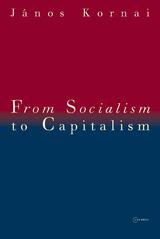 From Socialism to Capitalism: Eight Essays
Janos Kornai
Central European University Press, 2008 Eight essays connected by various common strands. The most important one is the community of the main subject-matter: socialism, capitalism, democracy, change of system. These four expressions cover four phenomena of great and comprehensive importance. Each piece in the book deals with these and the connections between them.
One of the Leitmotifs is the “capitalism/socialism” pair of opposites. Capitalism has a history of several hundred years, while the socialist regime existed only for a few decades. But this pair of opposites was central to the history of the twentieth century. This antagonism put its stamp on political thinking, on the foreign policy and military preparedness of every country, and on some appallingly destructive armed conflicts. All these had great secondary influence on each country’s economic development and the standard of living and disposition of its inhabitants.
None of the studies is confined to one country—not to Hungary or to any other. Each tries to embrace the problems common to greater units. However, the greater unit comprehended is not the same in each study. One may deal with the capitalist or socialist system in general, another will all the post-socialist countries, and a third the Central East European region. But all extend the analysis beyond the borders of one country.
From Solidarity to Martial Law: The Polish Crisis of 1980–1981
The National Security Archive Paczkowski
Central European University Press, 2007 95 documents on the events that represent a pivotal moment in modern Polish and world history: 16 months between August 1980 when the Solidarity trade union was founded and December 1981 when Polish authorities declared martial law and crushed the nationwide opposition movement that had grown up around the union. Transcripts of Soviet and Polish Politburo meetings give a detailed picture of the goals, motivations and deliberations of the leaders of these countries. Records of Warsaw Pact gatherings, notes of bilateral sessions of the communist camp provide additional pieces to the puzzle of what Moscow and its allies had in mind. Materials are included from Solidarity, too.
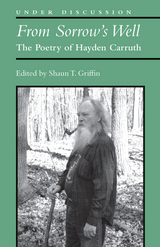 From Sorrow's Well: The Poetry of Hayden Carruth
Shaun T. Griffin
University of Michigan Press, 2015 Hayden Carruth survived isolation, mental health problems, and long struggle with drink and smoke to produce a vision of modern poetry rooted in the New England tradition but entirely his own. Many feel his best poems emerged from the isolation of rural Vermont, and his poems often are concerned with rural images and metaphors reflecting the land and hardscrabble people around him. Together with his second love, jazz, Carruth’s rural experiences infuse his poems with engaging and provocative ideas even as they present sometimes stark topics. This volume collects essays and poems from such notable contributors as Donald Hall, Marilyn Hacker, Adrienne Rich, Philip Booth, Matthew Miller, and Sascha Feinstein, among many others. The book’s sections concern the kinds of writings, and the values expressed in his writings, for which Carruth was most famous, including what editor Shaun T. Griffin calls “social utility,” jazz, his impoverished rural environment, and “innovation” in poetic form.
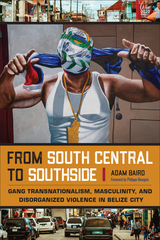 From South Central to Southside: Gang Transnationalism, Masculinity, and Disorganized Violence in Belize City
Adam Baird
Temple University Press, 2024 When he visited in 2011, sociologist Adam Baird wondered what the Bloods and Crips were doing in Southside Belize City. He soon discovered that migrant Belizean members of colors gangs from South Central Los Angeles were deported there in the 1980s. Once established “back home,” membership in the Bloods and Crips was seen as an aspirational pathway to manhood for the urban underclass.
From South Central to Southside charts the genesis and evolution of a transnational gang culture. Baird provides firsthand interviews with gang members and “narco” families and explains the surprising source of Belize City’s severe violence and skyrocketing homicide rates. He identifies gang violence in the U.S. and Belize as stemming from populations blighted by historical, brutal inequality and marginalization. Analyzing the gendered dynamics as young men and women face the temptations, risks, and dangers of gang life, Baird shines a light on “chronic vulnerability" in Belize City.
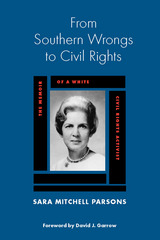 From Southern Wrongs to Civil Rights: The Memoir of a White Civil Rights Activist
Sara Mitchell Parsons
University of Alabama Press, 2009 This first-hand account tells the story of turbulent civil rights era Atlanta through the eyes of a white upper-class woman who became an outspoken advocate for integration and racial equality As a privileged white woman who grew up in segregated Atlanta, Sara Mitchell Parsons was an unlikely candidate to become a civil rights agitator. After all, her only contacts with blacks were with those who helped raise her and those who later helped raise her children. As a young woman, she followed the conventional path expected of her, becoming the dutiful wife of a conservative husband, going to the country club, and playing bridge. But unlike many of her peers, Parsons harbored an increasing uneasiness about racial segregation. In a memoir that includes candid diary excerpts, Parsons chronicles her moral awakening. With little support from her husband, she runs for the Atlanta Board of Education on a quietly integrationist platform and, once elected, becomes increasingly outspoken about inequitable school conditions and the slow pace of integration. Her activities bring her into contact with such civil rights leaders as Martin Luther King, Jr., and his wife, Coretta Scott King. For a time, she leads a dual existence, sometimes traveling the great psychic distance from an NAACP meeting on Auburn Avenue to an all-white party in upscale Buckhead. She eventually drops her ladies' clubs, and her deepening involvement in the civil rights movement costs Parsons many friends as well as her first marriage.
From Space to Earth: The Story of Solar Electricity
John Perlin
Harvard University Press, 2002 From Space to Earth tracks the evolution of the technology of photovoltaics, the use of solar cells to convert the sun's energy into electricity. John Perlin's painstaking research results in a fascinating account of the development of this technology, from its shaky nineteenth-century beginnings mired in scientific controversy to its high-visibility success in the space program, to its current position as a versatile and promising power source.
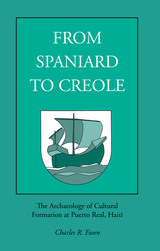 From Spaniard to Creole: The Archaeology of Cultural Formation at Puerto Real, Haiti
Charles Robin Ewen
University of Alabama Press, 1991 While most studies of intercultural contact focus on the impact of the intrusive power on the native culture, this book examines the effects of the colonization process on the Spaniards in the New World during the 16th century. The site of Puerto Real on the north coast of Haiti serves as a case study. Based on the results of excavations at both Puerto Real and St. Augustine, Florida, this study suggests that the introduction of New World and African cultural elements into Spanish colonial culture began almost at contact. The model of acculturative processes, developed in St. Augustine and tested at Puerto Real, can serve to guide future Spanish colonial research. It can also be applied to non-Hispanic colonial sites in the New World. Did the French and British adapt to their new environments in a manner similar to the Spanish? Work done at Puerto Real demonstrates the utility of archaeology in the study of the effects of culture contact.
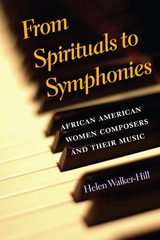 From Spirituals to Symphonies: African-American Women Composers and Their Music
Helen Walker-Hill
University of Illinois Press, 2006 Exploding the assumption that black women's only important musical contributions have been in folk, jazz, and pop Helen Walker-Hill's unique study provides a carefully researched examination of the history and scope of musical composition by African American women composers from the nineteenth and twentieth centuries. Focusing on the effect of race, gender, and class, From Spirituals to Symphonies notes the important role played by individual personalities and circumstances in shaping this underappreciated category of American art. The study also provides in-depth exploration of the backgrounds, experiences, and musical compositions of eight African American women including Margaret Bonds, Undine Smith Moore, and Julia Perry, who combined the techniques of Western art music with their own cultural traditions and individual gifts. Despite having gained national and international recognition during their lifetimes, the contributions of many of these women are today forgotten.
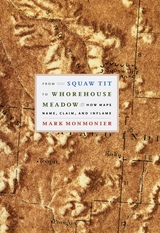 From Squaw Tit to Whorehouse Meadow: How Maps Name, Claim, and Inflame
Mark Monmonier
University of Chicago Press, 2006 Brassiere Hills, Alaska. Mollys Nipple, Utah. Outhouse Draw, Nevada. In the early twentieth century, it was common for towns and geographical features to have salacious, bawdy, and even derogatory names. In the age before political correctness, mapmakers readily accepted any local preference for place names, prizing accurate representation over standards of decorum. Thus, summits such as Squaw Tit—which towered above valleys in Arizona, New Mexico, Nevada, and California—found their way into the cartographic annals. Later, when sanctions prohibited local use of racially, ethnically, and scatalogically offensive toponyms, town names like Jap Valley, California, were erased from the national and cultural map forever.
From Squaw Tit to Whorehouse Meadow probes this little-known chapter in American cartographic history by considering the intersecting efforts to computerize mapmaking, standardize geographic names, and respond to public concern over ethnically offensive appellations. Interweaving cartographic history with tales of politics and power, celebrated geographer Mark Monmonier locates his story within the past and present struggles of mapmakers to create an orderly process for naming that avoids confusion, preserves history, and serves different political aims. Anchored by a diverse selection of naming controversies—in the United States, Canada, Cyprus, Israel, Palestine, and Antarctica; on the ocean floor and the surface of the moon; and in other parts of our solar system—From Squaw Tit to Whorehouse Meadow richly reveals the map’s role as a mediated portrait of the cultural landscape. And unlike other books that consider place names, this is the first to reflect on both the real cartographic and political imbroglios they engender.
From Squaw Tit to Whorehouse Meadow is Mark Monmonier at his finest: a learned analysis of a timely and controversial subject rendered accessible—and even entertaining—to the general reader.
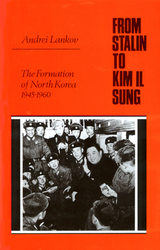 From Stalin to Kim Il Sung: The Formation of North Korea, 1945-1960
Lankov, Andrei
Rutgers University Press, 2002 To understand how North Korea has survived as the worlds last Stalinist regime despite international isolationand at enormous human costs to its peopleone must look at how its political system was created. The countrys foundations were laid in the late 1940s and 1950s as a result of interaction between the Soviet Stalinist model, imposed from outside, and local traditions. Andrei Lankov traces the formation of the North Korean state and the early years of Kim Il Sungs rule, when the future "Great Leader" and his entourage were consolidating their power base. Surveying the situation in North Korea after 1945, Lankov explores the internal composition of the ruling elite, the role of the Soviets, and the uneasy relations between various political groups. He also focuses on how in 1956 Kim Il Sung defeated the only known attempt to oust him and thereby established absolute personal rule beyond either Soviet or Chinese control. The book is based on previously secret Soviet documents from Russian archives, as well as interviews with Russian and Korean participants.
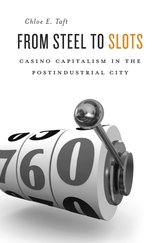 From Steel to Slots: Casino Capitalism in the Postindustrial City
Chloe E. Taft
Harvard University Press, 2016 Bethlehem, Pennsylvania, was once synonymous with steel. But after the factories closed, the city bet its future on a new industry: casino gambling. On the site of the former Bethlehem Steel plant, thousands of flashing slot machines and digital bells replaced the fires in the blast furnaces and the shift change whistles of the industrial workplace. From Steel to Slots tells the story of a city struggling to make sense of the ways in which local jobs, landscapes, and identities are transformed by global capitalism.
Postindustrial redevelopment often makes a clean break with a city’s rusted past. In Bethlehem, where the new casino is industrial-themed, the city’s heritage continues to dominate the built environment and infuse everyday experiences. Through the voices of steelworkers, casino dealers, preservationists, immigrants, and executives, Chloe Taft examines the ongoing legacies of corporate presence and urban development in a small city—and their uneven effects.
Today, multinational casino corporations increasingly act as urban planners, promising jobs and new tax revenues to ailing communities. Yet in an industry premised on risk and capital liquidity, short-term gains do not necessarily mean long-term commitments to local needs. While residents often have few cards to play in the face of global capital and private development, Taft argues that the shape economic progress takes is not inevitable, nor must it always look forward. Memories of corporations’ accountability to communities persist, and citizens see alternatives for more equitable futures in the layered landscapes all around them.
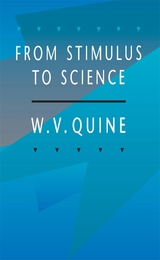 From Stimulus to Science
W. V. Quine
Harvard University Press, 1995 W. V. Quine is one of the most eminent philosophers alive today. Now in his mid-eighties he has produced a sharp, sprightly book that encapsulates the whole of his philosophical enterprise, including his thinking on all the key components of his epistemological stance--especially the value of logic and mathematics. New readers of Quine may have to go slowly, fathoming for themselves the richness that past readers already know lies between these elegant lines. For the faithful there is much to ponder.
In this short book, based on lectures delivered in Spain in 1990, Quine begins by locating his work historically. He provides a lightning tour of the history of philosophy (particularly the history of epistemology), beginning with Plato and culminating in an appreciative sketch of Carnap's philosophical ambitions and achievements. This leads, in the second chapter, to an introduction to Quine's attempt to naturalize epistemology, which emphasizes his continuities with Carnap rather than the differences between them. The next chapters develop the naturalistic story of the development of science to take account of how our conceptual apparatus is enhanced so that we can view the world as containing re-identifiable objects. Having explained the role of observation sentences in providing a checkpoint for assessing scientific theories, and having despaired of constructing an empirical criterion to determine which sentences are meaningful, Quine in the remaining chapters takes up a variety of important issues about knowledge. He concludes with an extended treatment of his views about reference and meaning and his attitudes toward psychological and modal notions.
The presentation is distinctive, and the many small refinements of detail and formulation will fascinate all who know Quine's philosophy.
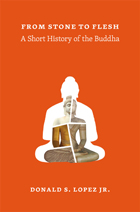 From Stone to Flesh: A Short History of the Buddha
Donald S. Lopez Jr.
University of Chicago Press, 2013 We have come to admire Buddhism for being profound but accessible, as much a lifestyle as a religion. The credit for creating Buddhism goes to the Buddha, a figure widely respected across the Western world for his philosophical insight, his teachings of nonviolence, and his practice of meditation. But who was this Buddha, and how did he become the Buddha we know and love today? Leading historian of Buddhism Donald S. Lopez Jr. tells the story of how various idols carved in stone—variously named Beddou, Codam, Xaca, and Fo—became the man of flesh and blood that we know simply as the Buddha. He reveals that the positive view of the Buddha in Europe and America is rather recent, originating a little more than a hundred and fifty years ago. For centuries, the Buddha was condemned by Western writers as the most dangerous idol of the Orient. He was a demon, the murderer of his mother, a purveyor of idolatry. Lopez provides an engaging history of depictions of the Buddha from classical accounts and medieval stories to the testimonies of European travelers, diplomats, soldiers, and missionaries. He shows that centuries of hostility toward the Buddha changed dramatically in the nineteenth century, when the teachings of the Buddha, having disappeared from India by the fourteenth century, were read by European scholars newly proficient in Asian languages. At the same time, the traditional view of the Buddha persisted in Asia, where he was revered as much for his supernatural powers as for his philosophical insights. From Stone to Flesh follows the twists and turns of these Eastern and Western notions of the Buddha, leading finally to his triumph as the founder of a world religion.
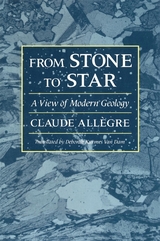 From Stone to Star: A View of Modern Geology
Claude Allègre
Harvard University Press, 1992 From Stone to Star chronicles one of the great scientific adventures of our time. Written by the eminent geochemist Claude Allègre, it offers a fascinating glimpse into the sophisticated isotopic detective work that has established a geologic chronology of the earth and transformed our understanding of its genesis and history. In eighteenth- and nineteenth-century Europe geologists exploring the earth's surface collected fossils and hotly debated the origin of the layered and folded rocks in which they were embedded.
The development of seismology, the study of earthquakes, in this century shifted the focus from the terrestrial crust to the earth's deep interior. But our knowledge of the chemistry of the earth and of the solar system has been revolutionized by advances in modern laboratory technology and analysis of meteorites and lunar rocks. High resolution mass spectrometry has allowed scientists to explore the very hearts of atoms. The Apollo mission brought back our first samples of the lunar surface, and unmanned space probes have gathered detailed photographs of distant planets.
From Stone to Star provides an engaging account of this exciting new chapter in scientific discovery. Scientists can now measure the isotopic composition of atoms with extreme precision. As miraculous as it may seem, a minute quantity of meteorite yields more information about the structure of the earth and the primitive history of the solar system than years of fieldwork on the earth's surface. Allègre, who was a project scientist during the interplanetary space missions, scrupulously avoids technical jargon. His lucid prose and abiding passion for his subject succeed in creating a superbly readable introduction to the history, methods, and theories of modern geology.
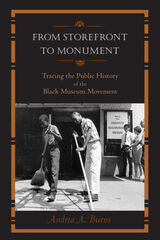 From Storefront to Monument: Tracing the Public History of the Black Museum Movement
Andrea A. Burns
University of Massachusetts Press, 2013 Winner of the 2015 National Council on Public History Book Award
Today well over two hundred museums focusing on African American history and culture can be found throughout the United States and Canada. Many of these institutions trace their roots to the 1960s and 1970s, when the struggle for racial equality inspired a movement within the black community to make the history and culture of African America more "public."
This book tells the story of four of these groundbreaking museums: the DuSable Museum of African American History in Chicago (founded in 1961); the International Afro-American Museum in Detroit (1965); the Anacostia Neighborhood Museum in Washington, D.C. (1967); and the African American Museum of Philadelphia (1976). Andrea A. Burns shows how the founders of these institutions, many of whom had ties to the Black Power movement, sought to provide African Americans with a meaningful alternative to the misrepresentation or utter neglect of black history found in standard textbooks and most public history sites. Through the recovery and interpretation of artifacts, documents, and stories drawn from African American experience, they encouraged the embrace of a distinctly black identity and promoted new methods of interaction between the museum and the local community.
Over time, the black museum movement induced mainstream institutions to integrate African American history and culture into their own exhibits and educational programs. This often controversial process has culminated in the creation of a National Museum of African American History and Culture, now scheduled to open in the nation's capital in 2015.
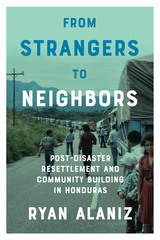 From Strangers to Neighbors: Post-Disaster Resettlement and Community Building in Honduras
By Ryan Alaniz
University of Texas Press, 2017 Natural disasters, the effects of climate change, and political upheavals and war have driven tens of millions of people from their homes and spurred intense debates about how governments and nongovernmental organizations (NGOs) should respond with long-term resettlement strategies. Many resettlement efforts have focused primarily on providing infrastructure and have done little to help displaced people and communities rebuild social structure, which has led to resettlement failures throughout the world. So what does it take to transform a resettlement into a successful community? This book offers the first long-term comparative study of social outcomes through a case study of two Honduran resettlements built for survivors of Hurricane Mitch (1998) by two different NGOs. Although residents of each arrived from the same affected neighborhoods and have similar demographics, twelve years later one resettlement wrestles with high crime, low participation, and low social capital, while the other maintains low crime, a high degree of social cohesion, participation, and general social health. Using a multi-method approach of household surveys, interviews, ethnography, and analysis of NGO and community documents, Ryan Alaniz demonstrates that these divergent resettlement trajectories can be traced back to the type and quality of support provided by external organizations and the creation of a healthy, cohesive community culture. His findings offer important lessons and strategies that can be utilized in other places and in future resettlement policy to achieve the most effective and positive results.
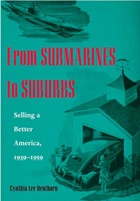 From Submarines to Suburbs: Selling a Better America, 1939–1959
Cynthia Lee Henthorn
Ohio University Press, 2006 During World War II, U.S. businesses devised marketing strategies that encouraged consumers to believe their country’s wartime experience would launch a better America. Advertisements and promotional articles celebrated the immense industrial output that corporations achieved during the war. These commercial messages positioned wartime technologies and corporate expertise as the means to streamline America and invent a socially hygienic future free from poverty, slums, drudgery, filth, and—for some businessmen—the New Deal administration.
From Submarines to Suburbs surveys the development, strategy, and effect of these campaigns over a span of twenty pivotal years. Cynthia Lee Henthorn takes a close look at how pre-fabricated suburban houses, high-tech kitchens, and miracle products developed from war-related industries were promoted as the hygienic solutions for establishing this better America, one led by the captains of free enterprise.
As Henthorn demonstrates, wartime advertising and marketing strategies tying consumer prosperity to war were easily adapted in the Cold War era, when a symbiotic relationship between military standing and standards of living intensified in a culture dependent on defense spending. Were the efforts to engineer a better America successful? Using documentary evidence in the form of numerous advertisements, From Submarines to Suburbs stands as a significant contribution to understanding how today’s “better” America evolved.
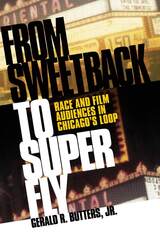 From SWEETBACK to SUPER FLY: Race and Film Audiences in Chicago's Loop
Gerald R. Butters, Jr.
University of Missouri Press, 2014 Racial politics and capitalism found a way to blend together in 1970s Chicago in the form of movie theaters targeted specifically toward African Americans. In From Sweetback to Super Fly, Gerald Butters examines the movie theaters in Chicago’s Loop that became, as he describes them, “black spaces” during the early 1970s with theater managers making an effort to gear their showings toward the African American community by using black-themed and blaxploitation films. Butters covers the wide range of issues that influenced the theaters, from changing racial patterns to the increasingly decrepit state of Chicago’s inner city and the pressure on businesses and politicians alike to breathe life into the dying area. Through his extensive research, Butters provides an in-depth look at this phenomenon, delving into an area that has not previously been explored. His close examination of how black-themed films were marketed and how theaters showing these films tried to draw in crowds sheds light on race issues both from an industrial standpoint on the side of the theaters and movie producers, as well as from a cultural standpoint on the side of the moviegoers and the city of Chicago as a whole. Butters provides a wealth of information on a very interesting yet underexamined part of history, making From Sweetback to Super Fly a supremely enjoyable and informative book.
From Symbolic Exile to Physical Exile: Turkey's Imam Hatip Schools, the Emergence of a Conservative Counter-Elite, and Its Knowledge Migration to Europe
Ismail Çaglar
Amsterdam University Press, 2013 Turkey’s Imam Hatip schools, which offer a combination of Islamic and secular subjects, operate in a country ostensibly committed to secular education. This thoughtful study examines the routes of these schools’ graduates to various European universities. Against the backdrop of the largely secular Turkish academic establishment, the Imam Hatip students frequently choose Europe for their university education because they are excluded and banned from native universities. This important volume contributes to the discussion of the role these schools play in the social mobility of religious conservatives in Turkey, as well as offering new research in the study of Turkish transnational religious movements.
From Syntax to Text: The Janus Face of Functional Sentence Perspective
Libuse Dusková
Karolinum Press, 2015 The volume deals with the interaction between syntax, informational structure (or functional sentence perspective), and text in present-day English and Czech. Libuše Dušková focuses on the two facets of functional sentence perspective: syntactic structures as carriers of informational structure functions and the connection of functional sentence perspective within the level of text. Functional sentence perspective is investigated as a potential factor of syntactic divergence between English and Czech, and the role of functional sentence perspective is examined with respect to theme development, text build-up, and style. Other topics include the hierarchical relationship between syntax and functional sentence perspective and general and specific questions of word order, with major attention paid to the role of semantics.
From Ta'izz To Tyneside: An Arab Community In The North-East Of England During The Early Twentieth Century
Richard I. Lawless
University of Exeter Press, 1995
This book is the first in-depth study of early Arab immigrants to Britain and provides a unique insight into their everyday lives. During the First World War, several thousand Arab seafarers arrived in a number of British ports; most came from Yemen and the neighbouring parts of Britain's Aden Protectorate. They represent the first significant Muslim communities to settle in Britain.
The book focuses on Tyneside because this is the only area for which there are extensive local archival sources.
Events on Tyneside are set in their national and international contexts. Throughout the interwar period, declining employment opportunities in shipping brought intense competition for jobs, and the Arab seamen found themselves unwanted guests; discrimination, abuse, regulation and control intensified.
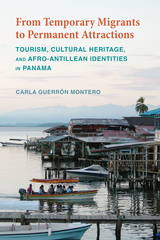 From Temporary Migrants to Permanent Attractions: Tourism, Cultural Heritage, and Afro-Antillean Identities in Panama
Carla Guerrón Montero
University of Alabama Press, 2020 A new reading of Panama’s nation-building process, interpreted through a lens of transnational tourism
Based on long-term ethnographic and archival research, From Temporary Migrants to Permanent Attractions: Tourism, Cultural Heritage, and Afro-Antillean Identities in Panama considers the intersection of tourism, multiculturalism, and nation building. Carla Guerrón Montero analyzes the ways in which tourism becomes a vehicle for the development of specific kinds of institutional multiculturalism and nation-building projects in a country that prides itself on being multiethnic and racially democratic.
The narrative centers on Panamanian Afro-Antilleans who arrived in Panama in the nineteenth century from the Greater and Leeward Antilles as a labor force for infrastructural projects and settled in Panama City, Colón, and the Bocas del Toro Archipelago. The volume discusses how Afro-Antilleans, particularly in Bocas del Toro, have struggled since their arrival to become part of Panama’s narrative of nationhood and traces their evolution from plantation workers for the United Fruit Company to tourism workers. Guerrón Montero notes that in the current climate of official tolerance, they have seized the moment to improve their status within Panamanian society, while also continuing to identify with their Caribbean heritage in ways that conflict with their national identity.
From Text to Action: Essays in Hermeneutics, II
Paul Ricoeur
Northwestern University Press, 1991 With his writings on phenomenology, psychoanalysis, Marxism, ideology, and religion, Paul Ricoeur has single-handedly redefined and revitalized the hermeneutic tradition. From Text to Action is an essential companion to the now classic The Conflict of Interpretations. Here, Ricoeur continues and extends his project of constructing a general theory of interpretation, positioning his work in relation to its own philosophical background: Hegel, Husserl, Gadamer, and Weber. He also responds to contemporary figures like K.O. Apel and Jürgen Habermas, connecting his own theorization of ideology to their version of ideology critique.
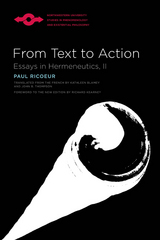 From Text to Action: Essays in Hermeneutics, II
Paul Ricoeur, Translated from the French by Kathleen Blamey and John B. Thompson, Foreword to the new edition by Richard Kearney
Northwestern University Press, 2007 Incredible originality of thought in areas as vast as phenomenology, religion, hermeneutics, psychoanalysis, intersubjectivity, language, Marxism, and structuralism has made Paul Ricoeur one of the philosophical giants of the twentieth century. The way in which Ricoeur approaches these themes makes his works relevant to the reader today: he writes with honesty and depth of insight into the core of a problem, and his ability to mark for future thought the very path of philosophical inquiry is nearly unmatched.
From Text to Action is an essential companion to the classic The Conflict of Interpretations. Here, Ricoeur continues and extends his project of constructing a general theory of interpretation, positioning his work in relation to its philosophical background: Hegel, Husserl, Gadamer, and Weber. He also responds to contemporary figures like K. O. Apel and Jürgen Habermas, connecting his own theorization of ideology to their critique of ideology.
This new edition includes a foreword by Richard Kearney. It and other new editions of Ricoeur's texts published by Northwestern University Press have joined the canon of contemporary continental philosophy and continue to contribute to emergent discussions in the twenty-first century.
 From that Place and Time: A Memoir, 1938-1947
Dawidowicz, Lucy
Rutgers University Press, 2008 From that Place and Time is the memoir of Lucy S. Dawidowicz, an American-Jewish historian who set out to study Yiddish language and Jewish history at YIVO, the Jewish Scientific Institute in Vilna, Poland, in 1938. Escaping Poland only days before the Nazi onslaught, she worked in the New York YIVO during the war, and returned to Europe from 1946 to 1947 to aid Jewish displaced persons in Munich and Belsen with the American Jewish Joint Distribution Committee. Dawidowicz's memoir not only describes her pre-war year in Jewish Eastern Europe, but also treats the ghostly post-war period, and her role in salvaging what remained of Vilna's scorched Jewish archives and libraries. Nancy Sinkoff's new introduction explores the historical forces, particularly the dynamic world of secular Yiddish culture, which shaped Dawidowicz's decision to journey to Poland and her reassessment of those forces in the last years of her life.
From That Terrible Field: Civil War Letters of James M. Williams, 21st Alabama Infantry Volunteers
James M. Williams
University of Alabama Press, 1981 “The well-written and candid letters of a reasonably articulate Southern officer, who paints a lucid picture of everyday life in the Confederate army in a little-known theater… Williams’s letters, personally written and shot through with his sharp sense of humor and folksy artwork, provide an excellent account of a long neglected theater of the American Civil War.” – Western Pennsylvania History
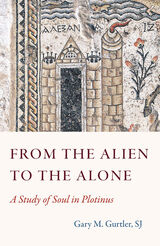 From the Alien to the Alone: A Study of Soul in Plotinus
Gary M. Gurtler, SJ
Catholic University of America Press, 2022 Plotinus is often accused of writing haphazardly, with little concern for the integral unity of a treatise. By analyzing each treatise as a whole, From the Alien to the Alone finds much evidence that he constructed them skillfully, with the parts working together in subtle ways. This insight was also key in translating several central passages by considering the flow of the argument as a whole to shed light on the difficulties in these passages as well as reveal the structure often latent in particular treatise. The volume also serves to clarify Plotinus’ rich use of images. Commentators, for instance, tend to take the images of light and warmth to explain the relation of soul and body as in conflict, with light casting out warmth. A close look at the text, however, reveals that Plotinus uses each image to correct the limitations of the other. Thus, since the soul is incorporeal, it is actually more transcendent than light and as activating the body is more completely present than warmth. Similarly, recent commentators are quick to take the related impassibility of the soul as implying a Cartesian gap between body and soul. The problem Plotinus faces, however, is that his description of the soul’s pervasive presence in the body jeopardizes its impassibility as in the intelligible. His effort then is actually to introduce a gap that preserves the soul’s nature, rather than overcome a gap that would make the very existence of the body problematic.
While this work confirms much recent scholarly consensus on Plotinus, many of Gurtler's interpretations and general conclusions give constructive challenges to some existing modes of understanding Plotinus’ thought. The arguments and their textual evidence, with the accompanying Greek, provide the reader with direct evidence for testing these conclusions as well as appreciating the nature of Plotinus’ philosophizing.
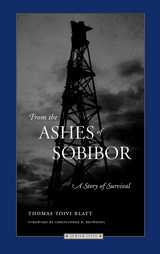 From the Ashes of Sobibor: A Story of Survival
Thomas Toivi Blatt, Foreward by Christopher R. Browning
Northwestern University Press, 1997 From the Ashes of Sobibor: A Story of Survival is an invaluable, firsthand account of a child's survival in a Nazi concentration camp in Poland during World War II. When the Germans invaded Poland on September 1, 1939, Thomas Toivi Blatt was twelve years old. He and his family lived in the largely Jewish town of Izbica in the Lublin district of Poland—the district that was to become the site of three major Nazi extermination camps: Belzec, Sobibor, and Majdanek. Blatt tells of the chilling events that led to his deportation to Sobibor, and of the six months he spent there before taking part in the now-famous uprising and mass breakout. Blatt's tale of escape, and of the five harrowing years spent eluding both the Nazis and anti-Semitic Polish nationalists, is gripping account of resilience and survival.
This edition also includes the author's interview with Karl Frenzel, a former Nazi commandant at Sobibor.
From the Ballroom to Hell: Grace and Folly in Nineteenth-Century Dance
Elizabeth Aldrich
Northwestern University Press, 1991 During the 1800s, dance and etiquette manuals provided ordinary men and women with the keys to becoming gentlemen and ladies—and thus advancing in society. Why dance? To the insecure and status-oriented upper middle class, the ballroom embodied the perfect setting in which to demonstrate one's fitness for membership in genteel society.
From the Ballroom to Hell collects over 100 little-known excerpts from dance, etiquette, beauty, and fashion manuals from the nineteenth century. Included are instructions for performing various dances, as well as musical scores, costume patterns, and the proper way to hold one's posture, fork, gloves, and fan. While of particular interest to dancers, dance historians, and choreographers, anyone fascinated by the ways and mores of the period will find From the Ballroom to Hell an endearing and informative glimpse of America's past.
 From the Battlefront to the Bridal Suite: Media Coverage of British War Brides, 1942-1946
Barbara G. Friedman
University of Missouri Press, 2007
With their gregarious natures and casual styles, American GIs in wartime England were instantly attractive to British women—especially in the absence of their fighting men. As a result, some seventy thousand British war brides returned to the United States—with many on the home front at first suspecting that the GIs were somehow being exploited.
The war brides’ stories have been told in memoirs, romantic novels, and immigration history. Barbara Friedman sheds new light on their experiences by focusing on media representations of sexuality and marriage in wartime, showing how mass media interpretations turned from public suspicion of war brides to popular acceptance.
Friedman tells how British media first insisted that GIs had come to fight, not to woo the locals, and shrugged off the first brides as an “American problem.” Yet, as Friedman shows, the British media were complicit in encouraging the relationships in the first place: the British press promoted a hospitality program that deemed the entertainment of American troops “patriotic duty,” while women’s magazines hailed American men as ideal husbands and the United States as a promised land.
From the American perspective, Friedman reveals, despite rules against foreign marriages, the U.S. Army encouraged GI-civilian fraternization through armed service publications, attitudes toward GI sexuality, and participation in the hospitality program. Armed service publications went from depicting British women as “frowsy dames” to honoring them as models of domesticity, while newspapers back home eventually legitimized the marriages by casting the brides as welcome additions to American society. Meanwhile, American women’s magazines viewed them as more similar to than different from their American counterparts and called on readers to help British brides master American homemaking.
By combining letters and diaries of brides with published accounts, Friedman identifies accuracies and inaccuracies in the media record as well as gaps in coverage. She considers how the brides saw themselves compared to their media images and shows how the media co-opted brides as symbols of the Anglo-American “special friendship,” postwar power imbalance, and gendered ideals of marriage and domestication.
From the Battlefront to the Bridal Suite is the untold story of overlooked participants in the most celebrated drama of the twentieth century—women whose lives were shaped profoundly by a war that was more than just a male enterprise. It shows the power of the press in the most unlikely matters and suggests a broader definition of the wartime experience.
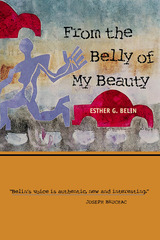 From the Belly of My Beauty
Esther G. Belin
University of Arizona Press, 1999 If it can be said that Native culture is hidden behind the facade of mainstream America, there is a facet of that culture hidden even to many Native Americans. One of today's generation of outstanding Native writers, Esther Belin is an urban Indian. Raised in the city, she speaks with an entirely different voice from that of her reservation kindred as she expresses herself on subjects of urban alienation, racism, sexism, substance abuse, and cultural estrangement.
In this bold new collection of poems, Belin presents a startling vision of urban California—particularly Los Angeles—contrasted with Navajo life in the Four Corners region. She presents aspects of Diné life and history not normally seen by readers accustomed to accounts written by Navajos brought up on the reservation.
Her work reveals a difference in experience but a similarity in outlook. Belin's poems put familiar cultural forms in a new context, as Coyote "struts down east 14th / feeling good / looking good / feeling the brown." Her character Ruby dramatizes the gritty reality of a Native woman's life ("I laugh / sit / smoke a Virginia Slim / and talk to the spirits"). Her use of Diné language and poignant descriptions of family life will remind some of Joy Harjo's work, but with every turn of the page, readers will know that Belin is making her own mark on Native American literature.
From the Belly of My Beauty is also a ceremony of affirmation and renewal for those Native Americans affected by the Federal Indian Relocation Program of the 1950s and '60s, with its attempts to "assimilate" them into the American mainstream. They have survived by remembering who they were and where they came from. And they have survived so that they might bear witness, as Esther Belin so powerfully does. Belin holds American culture accountable for failing to treat its indigenous peoples with respect, but speaks for the ability of Native culture to survive and provide hope, even for mixed-blood or urban Indians. She is living proof that Native culture thrives wherever its people are found.
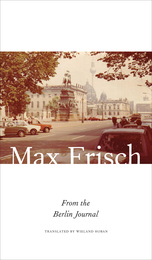 From the Berlin Journal
Max Frisch
Seagull Books, 2017 The daily journal of a giant of German literature, touching subjects ranging from everyday life to the political and social conditions in East Germany as viewed from West Berlin.
Max Frisch (1911–91) was a giant of twentieth-century German literature. When Frisch moved into a new apartment in Berlin’s Sarrazinstrasse, he began keeping a journal, which he came to call the Berlin Journal. A few years later, he emphasized in an interview that this was by no means a “scribbling book,” but rather a book “fully composed.” The journal is one of the great treasures of Frisch’s literary estate, but the author imposed a retention period of twenty years from the date of his death because of the “private things” he noted in it. From the Berlin Journal now marks the first publication of excerpts from Frisch’s journal. Here, the unmistakable Frisch is back, full of doubt, with no illusions, and with a playfully sharp eye for the world.
From the Berlin Journal pulls from the years 1946–49 and 1966–71. Observations about the writer’s everyday life stand alongside narrative and essayistic texts, as well as finely-drawn portraits of colleagues like Günter Grass, Uwe Johnson, Wolf Biermann, and Christa Wolf, among others. Its foremost quality, though, is the extraordinary acuity with which Frisch observed political and social conditions in East Germany while living in West Berlin.
From the Blue Windows: Recollections of Life in Queenstown, Singapore, in the 1960s and 1970s
Tan Kok Yang
National University of Singapore Press, 2013 Imagine a Singapore in which flat rental was S$50 a month, a plate of noodles cost as little as 20 cents, and television broadcasts ended at 10pm every night.
From the Blue Windows is a collection of Tan Kok Yang's memories of growing up in Queenstown back when the tallest residential building there was fourteen storeys, the Alexandra Canal flooded regularly, and wayang shows were a regular feature on Mei Ling Street. He stayed in Princess Estate, an area that was colloquially known as "the Blue Windows" because of its unique blue glass louvred windows.
With nostalgia and a sense of loss, this memoir is a personal tribute to and celebration of Queenstown and a simple but fulfilling way of life that has all but vanished from modern Singapore.
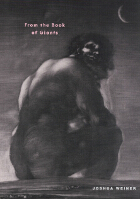 From the Book of Giants
Joshua Weiner
University of Chicago Press, 2006 Song for Thom Gunn There is no east or west in the wood you fear and seek, stumbling past a gate of moss and what you would not take. And what you thought you had (the Here that is no rest) you make from it an aid to form no east, no west. No east. No west. No need for given map or bell, vehicle, screen, or speed. Forget the house, forget the hill. Taking its title from a set of writings found in the Dead Sea Scrolls, From the Book of Giants retunes the signal broadcast from these ancient fragments, transmitting a new sound in the shape of a Roman drain cover, in imitations of Dante and Martial, in the voice of a cricket and the hard-boiled American photographer Weegee, in elegies both public and personal, and in poems that range from the social speech of letters to the gnomic language of riddles. Out of poetry’s “complex of complaint and praise,” Joshua Weiner discovers, in one poem, his own complicity in Empire during his son’s baseball game at the White House. In another, an embroidered parrot sings a hermetic nursery rhyme to an infant after 9/11.
From the Capitol to the Classroom: Standards-Based Reform in the States
Edited by Susan Fuhrman
University of Chicago Press, 2001 NSSE's second centennial volume focuses on standards-based reform in the U.S.: its overall theory, means of implementation and assessing impact, the ways in which schools and teachers have responded to policy changes, and the progress and future direction of reforms.
From the Center of Tradition: Critical Perspective on Linda Hogan
Barbara J. Cook
University Press of Colorado, 2003 Linda Hogan, a Chickasaw poet, novelist, essayist, playwright, and activist, is widely considered to be one of the most influential and provocative Native American figures on the contemporary literary landscape. Although her work has been the focus of num
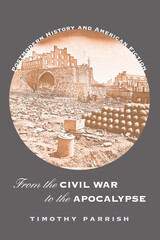 From the Civil War to the Apocalypse: Postmodern History and American Fiction
Timothy Parrish
University of Massachusetts Press, 2008 Why don't we read novels as if they were histories and histories as if they were novels? Recent postmodern theorists such as Hayden White and Linda Hutcheon have argued that since history is a narrative art, it must be understood as a form of narrative representation analogous to fiction. Yet, contrary to the fears of some historians, such arguments have not undermined the practice of history as a meaningful enterprise so much as they have highlighted the appeal history has as a narrative craft.
In addressing the postmodernist claim that history works no differently than fiction, Timothy Parrish rejects the implication that history is dead or hopelessly relativistic. Rather, he shows how the best postmodern novelists compel their readers to accept their narratives as true in the same way that historians expect their readers to accept their narratives as true. These novelists write history as a form of fiction.
If the great pre-modernist American historians are Francis Parkman, George Bancroft, and Henry Adams, who are the great modernist or postmodernist historians? In the twentieth century, Parrish argues, the most powerful works of American history were written by William Faulkner, Toni Morrison, Thomas Pynchon, Don DeLillo, Joan Didion, and Cormac McCarthy. What survives a reading of these novels is the sense that writers otherwise identified as multicultural or postmodern share the view that nothing matters more than history and what one believes its possibilities to be. In other words, Parrish concludes, history, not identity, is the ground of postmodern American fiction.
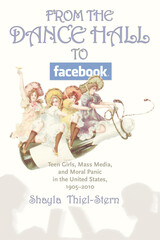 From the Dance Hall to Facebook: Teen Girls, Mass Media, and Moral Panic in the United States, 1905-2010
Shayla Thiel-Stern
University of Massachusetts Press, 2014 From the days of the penny press to the contemporary world of social media, journalistic accounts of teen girls in trouble have been a mainstay of the U.S. news media. Often the stories represent these girls as either victims or whores (and sometimes both), using journalistic storytelling devices and news-gathering practices that question girls' ability to perform femininity properly, especially as they act in public recreational space. These media accounts of supposed misbehavior can lead to moral panics that then further silence the voices of teenagers and young women.
In From the Dance Hall to Facebook, Shayla Thiel-Stern takes a close look at several historical snapshots, including working-class girls in dance halls of the early 1900s; girls' track and field teams in the 1920s to 1940s; Elvis Presley fans in the mid-1950s; punk rockers in the late 1970s and early 1980s; and girls using the Internet in the early twenty-first century. In each case, issues of gender, socioeconomic status, and race are explored within their historical context. The book argues that by marginalizing and stereotyping teen girls over the past century, mass media have perpetuated a pattern of gendered crisis that ultimately limits the cultural and political power of the young women it covers.
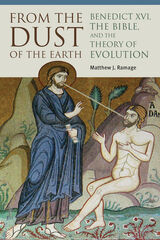 From the Dust of the Earth: Benedict XVI, the Bible , and the Theory of Evolution
Matthew J. Ramage
Catholic University of America Press, 2022 The claim that evolution undermines Christianity is standard fare in our culture. Indeed, many today have the impression that the two are mutually exclusive and that a choice must be made between faith and reason—rejecting Christianity on the one hand or evolutionary theory on the other. Is there a way to square advances in this field of study with the Bible and Church teaching?
In this book—his fourth dedicated to applying Joseph Ratzinger/Benedict XVI’s wisdom to pressing theological difficulties—Matthew Ramage answers this question decidedly in the affirmative. Distinguishing between evolutionary theory properly speaking and the materialist attitude that is often conflated with it, Ramage’s work meets the challenge of evolutionary science to Catholic teaching on human origins, guided by Ratzinger’s conviction that faith and evolutionary theory mutually enrich one another.
Pope Benedict gifted the Church with many pivotal yet often-overlooked resources for engaging evolution in the light of faith, especially in those instances where he addressed the topic in connection with the Book of Genesis. Ramage highlights these contributions and also makes his own by applying Ratzinger’s principles to such issues as the meaning of man’s special creation, the relationship between sin and death, and the implications of evolution for eschatology. Notably, Ramage shows that many apparent conflicts between Christianity and evolutionary theory lose their force when we interpret creation in light of the Paschal Mystery and fix our gaze on Jesus, the New Adam who reveals man to himself.
Readers of this text will find that it does more than merely help to resolve apparent contradictions between faith and modern science. Ramage’s work shows that discoveries in evolutionary biology are not merely difficulties to be overcome but indeed gifts that yield precious insight into the mystery of God’s saving plan in Christ.
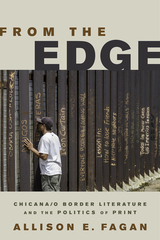 From the Edge: Chicana/o Border Literature and the Politics of Print
Fagan, Allison E
Rutgers University Press, 2016 Chicana/o literature frequently depicts characters who exist in a vulnerable liminal space, living on the border between Mexican and American identities, and sometimes pushed to the edge by authorities who seek to restrict their freedom. As this groundbreaking new study reveals, the books themselves have occupied similarly precarious positions, as Chicana/o literature has struggled for economic viability and visibility on the margins of the American publishing industry, while Chicana/o writers have grappled with editorial practices that compromise their creative autonomy. From the Edge reveals the tangled textual histories behind some of the most cherished works in the Chicana/o literary canon, tracing the negotiations between authors, editors, and publishers that determined how these books appeared in print. Allison Fagan demonstrates how the texts surrounding the authors’ words—from editorial prefaces to Spanish-language glossaries, from cover illustrations to reviewers’ blurbs—have crucially shaped the reception of Chicana/o literature. To gain an even richer perspective on the politics of print, she ultimately explores one more border space, studying the marks and remarks that readers have left in the margins of these books. From the Edge vividly demonstrates that to comprehend fully the roles that ethnicity, language, class, and gender play within Chicana/o literature, we must understand the material conditions that governed the production, publication, and reception of these works. By teaching us how to read the borders of the text, it demonstrates how we might perceive and preserve the faint traces of those on the margins.
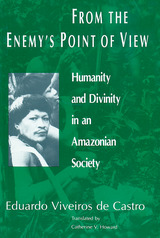 From the Enemy's Point of View: Humanity and Divinity in an Amazonian Society
Eduardo Viveiros de Castro
University of Chicago Press, 1992 The Araweté are one of the few Amazonian peoples who have maintained their cultural integrity in the face of the destructive forces of European imperialism. In this landmark study, anthropologist Eduardo Viveiros de Castro explains this phenomenon in terms of Araweté social cosmology and ritual order. His analysis of the social and religious life of the Araweté—a Tupi-Guarani people of Eastern Amazonia—focuses on their concepts of personhood, death, and divinity.
Building upon ethnographic description and interpretation, Viveiros de Castro addresses the central aspect of the Arawete's concept of divinity—consumption—showing how its cannibalistic expression differs radically from traditional representations of other Amazonian societies. He situates the Araweté in contemporary anthropology as a people whose vision of the world is complex, tragic, and dynamic, and whose society commands our attention for its extraordinary openness to exteriority and transformation. For the Araweté the person is always in transition, an outlook expressed in the mythology of their gods, whose cannibalistic ways they imitate. From the Enemy's Point of View argues that current concepts of society as a discrete, bounded entity which maintains a difference between "interior" and "exterior" are wholly inappropriate in this and in many other Amazonian societies.
From the Far Right to the Mainstream: Islamophobia in Party Politics and the Media
Edited by Humayun Ansari and Farid Hafez
Campus Verlag, 2012 This volume focuses on how the far right’s views of Islam have been increasingly co-opted by both liberal and conservative parties and woven into the policies of Western governments over the past two decades. The unprecedented influence of xenophobic and Islamophobic parties, whether in coalition with governments or recipients of the popular vote, reflects a major realignment of forces and a danger to the Western core values of human rights and equality. From the Far Right to the Mainstream explores how Islamophobia has moved to the mainstream of Western policy making, and the role that the media has played.
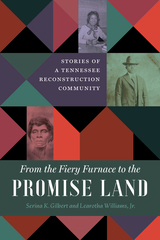 From the Fiery Furnace to the Promise Land: Stories of a Tennessee Reconstruction Community
Serina K. Gilbert and Learotha Williams, Jr.; Foreword by Frederick Murphy
Vanderbilt University Press, 2025 The Promise Land community, a small village west of Nashville, Tennessee was founded after the Civil War by people who had been enslaved at the Cumberland Iron Furnace. These early settlers, who included United States Colored Troops veterans, were able to purchase land and establish Black‑owned businesses. This afforded the community a level of stability that defies conventional wisdom about the post‑Reconstruction‑era South.
In time the community encompassed approximately 1,000 acres with more than 50 homes, several stores, three churches, and an elementary school. But by the mid‑twentieth century, the community had dwindled to just a handful of families. Now all that remains physically is a church and the old school building. But in the hearts of the descendants of those families, Promise Land remains a vital and thriving community of friends, family, and, albeit virtual, neighbors who continue to support each other.
This is the story of this town told through the memories of the people who lived there. Serina Gilbert grew up in the community and is now one of the revered storytellers and story‑keepers of Promise Land. Along with historian Learotha Williams, she is sharing the history of a community that thrived and continues to thrive in the face of almost insurmountable obstacles.
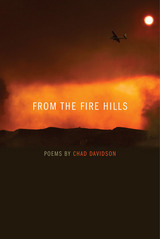 From the Fire Hills
Chad Davidson
Southern Illinois University Press, 2014 In From the Fire Hills, poet Chad Davidson shows us an Italy that is far from the romanticized notions of sun-drenched fields and self-discovery. Instead we see a maelstrom of chaos and contradiction, a place where the frenetic pace of modernity is locked in a daily struggle with recalcitrant history.
This autobiographical collection explores the myriad ways in which Italian culture survives its own parodies and evokes a modern ferocity that harkens back to Italy’s barbarian past. As the narrator, rendered vulnerable by language, embarks on his journey, lines of location, time, and perception blur. From the siren song of Dante’s grave to the heights of San Luca, from streets where policemen with Uzis tread a hair’s breadth away from the macabre remains of Capuchin monks, Davidson’s Italy is a study in contrast between the contemporary and the classical, the sacred and the profane. Within these poems sensual and savage revelations unfold, exposing new, uncanny, and often uncomfortable spaces to explore in this well-traveled realm of Western imagination.
Throughout the volume loom “the fire hills”: the scorched mountains of Sicily in summer; the memories of Italians living near the Gothic Line outside Bologna, where the Germans dug in and received heavy bombing at the close of World War II; even the wildfires igniting the San Gabriel foothills in southern California; all the way back to the burning city of Carthage in Virgil’s Aeneid. As the ash settles and the smoke clears, we realize that what we remember is often just remains, shells, and burned out wreckage, as if there were another type of memory.
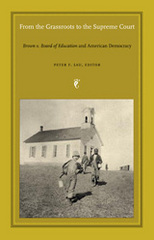 From the Grassroots to the Supreme Court: Brown v. Board of Education and American Democracy
Peter F. Lau, ed.
Duke University Press, 2004 Perhaps more than any other Supreme Court ruling, Brown v. Board of Education, the 1954 decision declaring the segregation of public schools unconstitutional, highlighted both the possibilities and the limitations of American democracy. This collection of sixteen original essays by historians and legal scholars takes the occasion of the fiftieth anniversary of Brown to reconsider the history and legacy of that landmark decision. From the Grassroots to the Supreme Court juxtaposes oral histories and legal analysis to provide a nuanced look at how men and women understood Brown and sought to make the decision meaningful in their own lives. The contributors illuminate the breadth of developments that led to Brown, from the parallel struggles for social justice among African Americans in the South and Mexican, Asian, and Native Americans in the West during the late nineteenth century to the political and legal strategies implemented by the National Association for the Advancement of Colored People (naacp) in the twentieth century. Describing the decision’s impact on local communities, essayists explore the conflict among African Americans over the implementation of Brown in Atlanta’s public schools as well as understandings of the ruling and its relevance among Puerto Rican migrants in New York City. Assessing the legacy of Brown today, contributors analyze its influence on contemporary law, African American thought, and educational opportunities for minority children. Contributors
Tomiko Brown-Nagin
Davison M. Douglas
Raymond Gavins
Laurie B. Green
Christina Greene
Blair L. M. Kelley
Michael J. Klarman
Peter F. Lau
Madeleine E. Lopez
Waldo E. Martin Jr.
Vicki L. Ruiz
Christopher Schmidt
Larissa M. Smith
Patricia Sullivan
Kara Miles Turner
Mark V. Tushnet
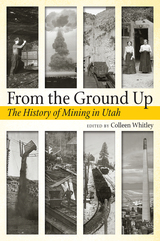 From the Ground Up: A History of Mining in Utah
edited by Colleen K. Whitley
Utah State University Press, 2025 Mining had an enormous role, only partly measurable, in the history of Utah. Its multidimensional impact continues today. Economically, it made a major long-term contribution to the wealth, employment, and tax base of the state and stimulated a seemingly endless range of secondary businesses and enterprises. It helped shape the state's social history, determining the location, distribution, and composition of many communities and bringing transportation systems and a wide variety of institutions to them. It developed cultural diversity by drawing to Utah miners and families from otherwise underrepresented ethnic and national backgrounds. It ignited strife, particularly between labor and management, but those issues often spread into or connected with other conflicts in and between communities, classes, and factions. It influenced political platforms, generated candidates, and helped decide elections. Throughout the state, mining dramatically transformed the landscape, most obviously at what has been called the world's largest open-pit mine, which removed much of a mountain on the west side of Salt Lake Valley, but at innumerable other places too. Despite all mining has done and meant, there has not been, until now, a book that surveyed its history in Utah. From the Ground Up fills that gap in a collection of essays by leading experts, among them historians Thomas G. Alexander, Martha Sonntag Bradley-Evans, James E. Fell Jr., Laurence P. James, Brigham D. Madsen, Philip F. Notarianni, Allen Kent Powell, W. Paul Reeve, Raye C. Ringholz, and Janet Burton Seegmiller and geologists J. Wallace Gwynn and William T. Parry. The book is divided into three comprehensive parts. The first looks at "The Ground of Utah Mining": the geology that has produced extractable minerals, the economic history of the industry, "father of Utah mining" Patrick E. Connor, and the lore of mines and miners. Part II reviews the history of a handful of particularly significant mineral industries: salines, coal, uranium, and beryllium. The last part takes a region-by-region approach to survey the important, primarily for hard-rock mining, areas of the state, including places from Silver Reef to Alta, the East Tintic Range to the Uinta Basin, and Park City to Frisco.
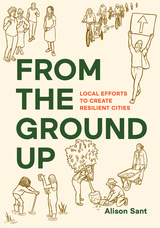 From the Ground Up: Local Efforts to Create Resilient Cities
Alison Sant
Island Press, 2022 For decades, American cities have experimented with ways to remake themselves in response to climate change. These efforts, often driven by grassroots activism, offer valuable lessons for transforming the places we live. In From the Ground Up: Local Efforts to Create Resilient Cities, design expert Alison Sant focuses on the unique ways in which US cities are working to mitigate and adapt to climate change while creating equitable and livable communities. She shows how, from the ground up, we are raising the bar to make cities places in which we don’t just survive, but where all people have the opportunity to thrive.
The efforts discussed in the book demonstrate how urban experimentation and community-based development are informing long-term solutions. Sant shows how US cities are reclaiming their streets from cars, restoring watersheds, growing forests, and adapting shorelines to improve people’s lives while addressing our changing climate. The best examples of this work bring together the energy of community activists, the organization of advocacy groups, the power of city government, and the reach of federal environmental policy.
Sant presents 12 case studies, drawn from research and over 90 interviews with people who are working in these communities to make a difference. For example, advocacy groups in Washington, DC are expanding the urban tree canopy and offering job training in the growing sector of urban forestry. In New York, transit agencies are working to make streets safer for cyclists and pedestrians while shortening commutes. In San Francisco, community activists are creating shoreline parks while addressing historic environmental injustice.
From the Ground Up is a call to action. When we make the places we live more climate resilient, we need to acknowledge and address the history of social and racial injustice. Advocates, non-profit organizations, community-based groups, and government officials will find examples of how to build alliances to support and embolden this vision together. Together we can build cities that will be resilient to the challenges ahead.
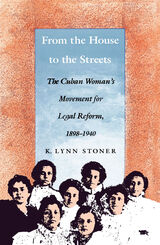 From the House to the Streets: The Cuban Woman's Movement for Legal Reform, 1898-1940
K. Lynn Stoner
Duke University Press, 1991 From the House to the Streets is the first study on feminists and the feminist movement in Cuba between 1902 and 1940. In the four decades following its independence form Spain in 1898, Cuba adopted the most progressive legislation for women in the western hemisphere. K. Lynn Stoner explains how a small group of women and men helped to shape broad legal reforms: she describes their campaigns, the version of feminism they adopted with all its contradictions, and contrasts it to the model of feminism North Americans were transporting to Cuba.
Stoner draws on rich primary sources—texts, personal letters, journal essays, radio broadcasts, memoirs from women’s congresses—which allow these women to speak in their own voices. In reconstructing the mentalité of Cuban feminists, who came primarily from a privileged social status, Stoner shows how feminism drew from traditional notions of femininity and a rejection of gender equality to advance a cause that assumed women’s expanded roles were necessary for social progress. She also examines the values of the progressive male politicians who supported feminists and worked to change Cuban laws.
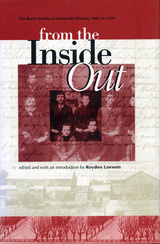 From the Inside Out: The Rural Worlds of Mennonite Diarists
Royden Loewen
University of Manitoba Press, 1999 Historian Royden Loewen has brought together selections from diaries kept by 21 Mennonites in Canada between 1863 and 1929, some translated from German for the first time. By skillfully comparing and contrasting a wide cross-section of lives, Loewen shows how these diaries often turn the hidden contours of household and community "inside out." The writers featured were ordinary rural people: young women and grandmothers, rural preachers and landless householders. They include a teenaged boy who immigrated from Russia to Manitoba in 1875 as well as a successful merchant, a traveling evangelist, and a devout, conservative church elder. An elderly grandfather recounted the daily circuit of his children's homes, while 19-year-old Marie Schoeder wrote of her literary aspirations, her "secret hope" that some day she would "write things that have a real worth, things that are worth printing, and things that other folks would love to read and pay for." From the Inside Out also contrasts diaries from two distinct Mennonite communities in Canada. The Swiss-American Mennonites in Waterloo County, Ontario, faced rapid urbanization, while the Dutch-Russian Mennonites in southern Manitoba maintained their more rural environment. The diaries mirror their writers' preoccupations with work and weather, but they also reveal a communityís social structure and round of activities such as weddings, funerals, and worship services. In the process of diary-keeping, the writers sought to make sense of a dynamic and often unpredictable world. Reading what they chose to record is to learn much about their culture. Their writings provide glimpses of their lives, their collective mindset, and their history as a people.
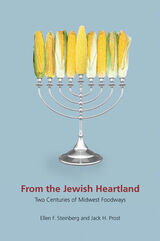 From the Jewish Heartland: Two Centuries of Midwest Foodways
Ellen F. Steinberg and Jack H. Prost
University of Illinois Press, 2013 From the Jewish Heartland: Two Centuries of Midwest Foodways reveals the distinctive flavor of Jewish foods in the Midwest and tracks regional culinary changes through time. Exploring Jewish culinary innovation in America's heartland from the 1800s to today, Ellen F. Steinberg and Jack H. Prost examine recipes from numerous midwestern sources, both kosher and nonkosher, including Jewish homemakers' handwritten manuscripts and notebooks, published journals and newspaper columns, and interviews with Jewish cooks, bakers, and delicatessen owners. With the influx of hundreds of thousands of Jews during the late nineteenth and early twentieth centuries came new recipes and foodways that transformed the culture of the region. Settling into the cities, towns, and farm communities of Ohio, Indiana, Wisconsin, Michigan, Illinois, Missouri, Iowa, and Minnesota, Jewish immigrants incorporated local fruits, vegetables, and other comestibles into traditional recipes. Such incomparable gustatory delights include Tzizel bagels and rye breads coated in midwestern cornmeal, baklava studded with locally grown cranberries, dark pumpernickel bread sprinkled with almonds and crunchy Iowa sunflower seeds, tangy ketchup concocted from wild sour grapes, Sephardic borekas (turnovers) made with sweet cherries from Michigan, rich Chicago cheesecakes, native huckleberry pie from St. Paul, and savory gefilte fish from Minnesota northern pike. Steinberg and Prost also consider the effect of improved preservation and transportation on rural and urban Jewish foodways, as reported in contemporary newspapers, magazines, and published accounts. They give special attention to the impact on these foodways of large-scale immigration, relocation, and Americanization processes during the nineteenth century and the efforts of social and culinary reformers to modify traditional Jewish food preparation and ingredients. Including dozens of sample recipes, From the Jewish Heartland: Two Centuries of Midwest Foodways takes readers on a memorable and unique tour of midwestern Jewish cooking and culture.
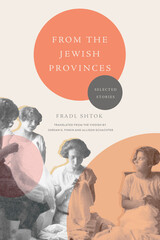 From the Jewish Provinces: Selected Stories
Fradl Shtok; Translated from the Yiddish by Jordan D. Finkin and Allison Schachter
Northwestern University Press, 2022 Winner, 2022 MLA Fenia and Yaakov Leviant Memorial Prize in Yiddish Studies
From the Jewish Provinces showcases a brilliant and nearly forgotten voice in Yiddish letters. An insistently original writer whose abrupt departure from the literary scene is the stuff of legend, Fradl Shtok composed stories that describe the travails of young women looking for love and desire in a world that spurns them. These women struggle with disability, sexual violence, and unwanted marriage, striving to imagine themselves as artists or losing themselves in fantasy worlds. The men around them grapple with their own frustrations and failures to live up to stifling social expectations. Through deft portraits of her characters’ inner worlds Shtok grants us access to unnoticed corners of the Jewish imagination.
Set alternately in the Austro‑Hungarian borderlands and in New York City, Shtok’s stories interpret the provincial worlds of the Galician shtetl and the Lower East Side with literary sophistication, experimenting with narrative techniques that make her stories expertly alive to women’s aesthetic experiences.
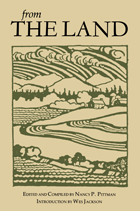 From The Land: Articles Compiled From The Land 1941-1954
Edited by Nancy P. Pittman; Introduction by Wes Jackson
Island Press, 1988 Begun in 1941 as an outgrowth of Friends of the Land, the journal The Land was an attempt by editor Russell Lord to counteract -- through education, information, and inspiration -- the rampant abuse of soil, water, trees and rivers. But for all its seriousness of mission, The Land was a stimulating mix of fact and charm. It included literature, philosophy, art, and the practical observations of farmers and conservation workers, to encourage small farmers to understand and apply conservation principles to their lands. This anthology, a fascinating mosaic, compiled from the 13 years of The Land tells in fiction, non-fiction, poetry, and philosophy the story of how we changed from a nation of small farms to the agribusiness we have today. Among the 40 authors included are conservation and literary giants such as Aldo Leopold, E. B.White, Louis Bromfield, Paul Sears, Allan Patton and Wallace Stegner.
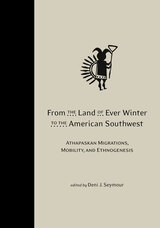 From the Land of Ever Winter to the American Southwest: Athapaskan Migrations, Mobility, and Ethnogenesis
Deni J. Seymour
University of Utah Press, 2012 The Athapaskan departure from the Canadian Subarctic centuries ago and their subsequent arrival in the American Southwest has remained the subject of continuous debate in anthropological research. This book examines archaeological, genetic, linguistic, and traditional oral history data and brings them together in fresh ways, in many cases for the first time. With a backdrop of these new and interrelated lines of evidence, each subfield must now reevaluate its approach and the forms of evidence it uses to construct arguments.
The contributors here include the most knowledgeable scholars in each of the above fields, collectively providing the most up-to-date research on early Athapaskans and their movements and migrations. Each chapter approaches Athapaskan migration with data obtained from different regions, providing clarity as to the basis for individual arguments. Often, entrenched regional visualizations and localized conventions are clarified only when placed in juxtaposition to those of other regions. Because of this, conclusions rest on sometimes widely divergent theoretical and methodological underpinnings, thus expressing preference for and conveying weight to certain types of evidence and lines of reasoning. The goal of this volume is to expose these arguments in order to clarify appropriate directions for future research, making advances possible.
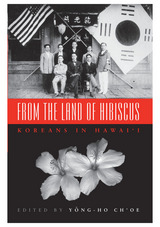 From the Land of Hibiscus: Koreans in Hawai‘i, 1903–1950
edited by Yong-ho Ch'oe
University of Hawaii Press, 2007 In 1903, 102 Koreans migrated to Hawai‘i in search of wealth and fortune—the first in their country’s history to live in the Western world. Thousands followed. Most of them, however, found only hardship while working as sugar plantation laborers. Soon after their departure, Korea was colonized by Japan, and overnight they became "international orphans" with no government to protect them. Setting aside their original goal of bettering their own lives, these Korean immigrants redirected their energies to restoring their country’s sovereignty, turning Hawai‘i into a crucially important base of Korean nationalism.
From the Land of Hibiscus traces the story of Koreans in Hawai‘i from their first arrival to the eve of Korea’s liberation in 1945. Using newly uncovered evidence, it challenges previously held ideas on the social origins of immigrants. It also examines their political background, the role of Christian churches in immigration, the image of Koreans as depicted in the media, and, above all, nationalist activities. Different approaches to waging the nationalist struggle uncover the causes of feuds that often bitterly divided the Korean community. Finally, the book provides the first in-depth studies of the nationalist activities of Syngman Rhee, the Korean National Association, and the United Korea Committee.
From the Local to the Global, Third Edition: Key Issues in Development Studies
Edited by Gerard McCann and Stephen McCloskey
Pluto Press, 2015 In recent years, the international development sector has found itself confronting new and persistent challenges to poverty eradication and the promotion of human rights. From The Local to the Global highlights the extent to which the local and global are interconnected in today’s world economy and questions the legitimacy of the neo-liberal model of development that they argue has propelled us into the crisis.
This completely revised third edition takes stock of the international development environment as it embarks on new policy frameworks to confront new challenges, ensuring that From the Local to the Global will continue to serve as an indispensable introduction to key development issues such as aid, debt, trade, migration, security, gender, and climate change.
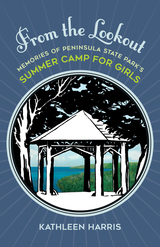 From the Lookout: Memories of Peninsula State Park’s Summer Camp for Girls
Kathleen Harris
Wisconsin Historical Society Press, 2020 For every summer from 1916 to 1948, Camp Meenahga, on the picturesque shoreline of Lake Michigan in Door County’s Peninsula State Park, hosted young girls and women from across the United States and Canada. From July to September each year, campers slept in canvas tents, told stories beside a massive stone fireplace, swam, canoed, sailed, hiked, rode horses, and watched the sunset from the Lookout, a gazebo with a spectacular view of the waters of Green Bay.
With big ideas, little money, and no experience, Alice Orr Clark and Frances Louise “Kidy” Mabley founded Meenahga as a place for young women to refine their manners, enjoy outdoor leisure activities, and learn woodcraft. From the Lookout is an account of these experiences, a history of Camp Meenahga informed by what campers, counselors, and others left behind, including letters home, notes from Clark and Mabley, and many pages from the camp yearbook and newsletter Pack and Paddle.
Brimming with nostalgia, From the Lookout brings to life the sights, sounds, and smells of an idyllic summer retreat, one that long after it closed lived on as a place of respite in the memories of those who knew and loved it best.
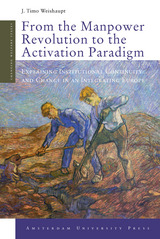 From the Manpower Revolution to the Activation Paradigm: Explaining Institutional Continuity and Change in an Integrating Europe
J. Timo Weishaupt
Amsterdam University Press, 2011
This illuminating book examines the origins and evolution of labor market policy in Western Europe in three phases: a manpower revolution during the 1960s and 1970s; a phase of international disagreement about the causes of and remedies for unemployment, which triggered a variety of policy responses in the late 1970s and 1980s; and, finally, the emergence of an activation paradigm in the late 1990s, the influence of which continues to reverberate today. J. Timo Weishaupt contends that the evolution of labor market policy is determined not only by historical trajectories or coalitional struggles, but also by policy makers’ changing normative and cognitive beliefs. Including case studies of Austria, Denmark, Germany, Ireland, Sweden, and the United Kingdom, this study will be of value to anyone interested in labor market policy and its governance.
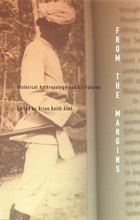 From the Margins: Historical Anthropology and Its Futures
Brian Keith Axel, ed.
Duke University Press, 2002 Historical anthropology: critical exchange between two decidedly distinct disciplines or innovative mode of knowledge production? As this volume’s title suggests, the essays Brian Keith Axel has gathered in From the Margins seek to challenge the limits of discrete disciplinary epistemologies and conventions, gesturing instead toward a transdisciplinary understanding of the emerging relations between archive and field.
In original articles encompassing a wide range of geographic and temporal locations, eminent scholars contest some of the primary preconceptions of their fields. The contributors tackle such topics as the paradoxical nature of American Civil War monuments, the figure of the “New Christian” in early seventeenth-century Peru, the implications of statistics for ethnography, and contemporary South Africa's “occult economies.” That anthropology and history have their provenance in—and have been complicit with—colonial formations is perhaps commonplace knowledge. But what is rarely examined is the specific manner in which colonial processes imbue and threaten the celebratory ideals of postcolonial reason or the enlightenment of today’s liberal practices in the social sciences and humanities.
By elaborating this critique, From the Margins offers diverse and powerful models that explore the intersections of historically specific local practices with processes of a world historical order. As such, the collection will not only prove valuable reading for anthropologists and historians, but also for scholars in colonial, postcolonial, and globalization studies.
Contributors. Talal Asad, Brian Keith Axel, Bernard S. Cohn, Jean Comaroff, John L. Comaroff, Nicholas B. Dirks, Irene Silverblatt, Paul A. Silverstein, Teri Silvio, Ann Laura Stoler, Michel-Rolph Trouillot
From the Meadow: Selected and New Poems
Peter Everwine
University of Pittsburgh Press, 2004 "His poems are timeless, lyrical songs that transcend the dark forces of our society and call for a deeper understanding of our values. Becoming familiar again with old poems by a gifted master is like reliving the days when poetry truly came from the heart to ravish and define who we are."
--Bloomsbury Review
"These exquisite poems are so well paced that nothing ever seems forced or misplaced."
--Library Journal
"[Everwine] presents us with poetry in which each moment is recorded, laid bare, and sanctified, which is to say the poems posses a quality one finds only in the greatest poetry."
--Ploughshares
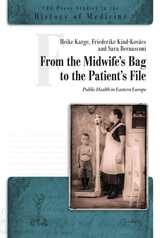 From the Midwife's Bag to the Patient's File: Public Health in Eastern and Southeastern Europe
Sara Bernasconi
Central European University Press, 2018 This volume offers an analysis of the intertwined relationship between public health and the biopolitical dimensions of state- and nation building in Central, Eastern and Southeastern Europe. It challenges the idea of diverging paths towards modernity of Europe’s western and eastern countries by not only identifying ideas, discourses and practices of “solving” public health issues that were shared among political regimes in the region; it also uncovers the ways in which, since the late nineteenth century, the biopolitical organization of the state both originated from and shaped an emerging common European framework. The broad range of local case studies stretches from Bosnia and Herzegovina, Czechoslovakia, the GDR, Greece and Hungary, to Poland, Serbia, the Soviet Union, and Yugoslavia. Taking a time span that begins in the late nineteenth century and ends in the post-socialist era, the book makes an original contribution to scholarship examining the relationship between public health, medicine, and state- and nation building in Europe’s long twentieth century. Close readings and dense descriptions of local discourses and practices of “public” health help to reflect on the transnational and global entanglements in the sphere of public health. In doing so, this volume facilitates comparisons on the regional, European, and global level.
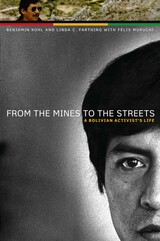 From the Mines to the Streets: A Bolivian Activist’s Life
By Benjamin Kohl and Linda C. Farthing, with Félix Muruchi
University of Texas Press, 2011 From the Mines to the Streets draws on the life of Félix Muruchi to depict the greater forces at play in Bolivia and elsewhere in South America during the last half of the twentieth century. It traces Félix from his birth in an indigenous family in 1946, just after the abolition of bonded labor, through the next sixty years of Bolivia's turbulent history. As a teenager, Félix followed his father into the tin mines before serving a compulsory year in the military, during which he witnessed the 1964 coup d'état that plunged the country into eighteen years of military rule. He returned to work in the mines, where he quickly rose to become a union leader. The reward for his activism was imprisonment, torture, and exile. After he came home, he participated actively in the struggles against neoliberal governments, which led in 2006—the year of his sixtieth birthday—to the inauguration of Evo Morales as Bolivia's first indigenous president. The authors weave Muruchi's compelling recollections with contextual commentary that elucidates Bolivian history. The combination of an unforgettable life story and in-depth text boxes makes this a gripping, effective account, destined to become a classic sourcebook.
From the Modernist Annex: American Women Writers in Museums and Libraries
Karin Roffman
University of Alabama Press, 2010 In the 19th and early 20th centuries, the majority of women were forced to seek their education outside the walls of American universities. Many turned to museums and libraries, for their own enlightenment, for formal education, and also for their careers. In Roffman’s close readings of four modernist writers—Edith Wharton, Nella Larsen, Marianne Moore, and Ruth Benedict—she studied the that modernist women writers were simultaneously critical of and shaped by these institutions. From the Modernist Annex offers new and critically significant ways of understanding these writers and their texts, the distribution of knowledge, and the complicated place of women in modernist institutions.
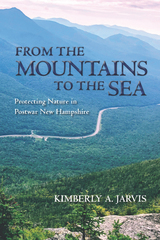 From the Mountains to the Sea: Protecting Nature in Postwar New Hampshire
Kimberly A. Jarvis
University of Massachusetts Press, 2020 In the face of increasing pressures from business and government in the decades following World War II, New Hampshire residents banded together to preserve their most prized natural areas and defining geological features. From the Mountains to the Sea explores how history, memory, and tradition created a strong sense of place in the state that led citizen activists to protect Franconia Notch, Sandwich Notch, and the town of Durham on New Hampshire's seacoast from development in the last half of the twentieth century. These efforts led to the construction of a parkway instead of an interstate highway, prevented the building of an oil refinery, and saved Sandwich Notch from becoming a vacation community.
Shaped by New Hampshire's unique conservation focus on both resource use and preservation that developed during the first years of the twentieth century, as well as on the tradition of home rule in the state, the outcome of each campaign relied on the insight into, appreciation for, and dedication to protecting the historic and aesthetic values of these three places.
From the Nation-Building Debate to the Bolsa Família Program: Whiteness, Gender, and Poverty in Brazil
Beatriz Junqueira Lage Carbone
Campus Verlag, 2023 An examination of struggles over race and gender in contemporary Brazil, as reflected in conflicts over a national social welfare program.
Bolsa Familia was a social welfare program launched in Brazil in 2003 that made cash payments to poor families, provided they kept their children in school and got them vaccinated. Over time, the program became controversial, intertwined with struggles over race and gender, and President Jair Bolsonaro canceled it in 2021. This book examines the discourse around the program and its effects, illuminating conflicts over national identity and the roles of sexism and racism in Brazil.
From the New Criticism to Deconstruction: The Reception of Structuralism and Post-Structuralism
Art Berman
University of Illinois Press, 1988 From the New Criticism to Deconstruction
traces the transitions in American critical theory and practice from the 1950s
to the 1980s. It focuses on the influence of French structuralism and post-structuralism
on American deconstruction within a wide-ranging context that includes literary
criticism, philosophy, psychology, technology, and politics.
 From the Old Marketplace
Joseph Buloff
Harvard University Press, 1991 A young Jewish boy—the old, much-fought-over city of Vilnius—the rumblings and then the reality of World War I—all combine in this book to create a striking historical document of a period during which Europe and the Western world were changed forever. In the streets and alleys of Vilnius actor Joseph Buloff came of age, learning the arts of shape-altering necessary for survival during successive occupations by Cossacks, Germans, Bolsheviks, and Poles; it is this fascinating vanished milieu that he brings to life in From the Old Marketplace.
For a little boy, the old marketplace was full of enchantment, a world in itself, and Buloff brilliantly describes the eccentric inhabitants who peopled his childhood: Berchick the orphan, Barve's son the intellectual and historian, the starveling Matzek, Arkashka the Cossack, Joseph's mother, the saintly yet practical Sarah, and his father, Benjamin, who made a fortune in America and lost it again in Europe.
The boy came to realize his own Jewishness when Russian persecution forced the Jews to make the synagogue the center of their world. He was driven by brutality, hunger, and ostracism to transform himself in spirit into the imaginary Chantille Jeantaigne Delacroix, scourge of evil, avenger of his people, Conqueror of Death. Joseph's accounts of daily life under unbelievably hard circumstances range from down-to-earth facts to soaring flights of fantasy—and his desperate acting in order to stay alive brought him his true vocation, first on the scrounging amateur stage and then in the professional theatre.
 From the Other Shore: Russian Social Democracy after 1921
André Liebich
Harvard University Press, 1997 This book is an inquiry into the possibilities of politics in exile. Russian Mensheviks, driven out of Soviet Russia and their party stripped of legal existence, functioned abroad in the West—in Berlin, Paris, and New York—for an entire generation. For several years they also continued to operate underground in Soviet Russia. Bereft of the usual advantages of political actors, the Mensheviks succeeded in impressing their views upon social democratic parties and Western thinking about the Soviet Union.
The Soviet experience through the eyes of its first socialist victims is recreated here for the first time from the vast storehouse of archival materials and eyewitness interviews. The exiled Mensheviks were the best informed and most perceptive observers of the Soviet scene through the 1920s and 1930s. From today’s perspective the Mensheviks’ analyses and reflections strikingly illuminate the causes of the failure of the Soviet experiment.
This book also probes the fate of Marxism and democratic socialism as it tracks the activities and writings of a remarkable group of men and women—including Raphael Abramovitch, Fedor and Lidia Dan, David Dallin, Boris Nicolaevsky, Solomon Schwarz, and Vladimir Woytinsky—entangled in the most momentous events of this century. Their contribution to politics and ideas in the age of totalitarianism merits scrutiny, and their story deserves to be told.
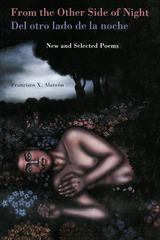 From the Other Side of Night/Del otro lado de la noche: New and Selected Poems
Francisco X. Alarcón
University of Arizona Press, 2002 On the other side of night, Francisco Alarcón is waiting.
One of Chicano literature's premier poets, Alarcón has brought his luminous images to the page in such acclaimed volumes as Sonnets to Madness and Other Misfortunes and Snake Poems. Now he has assembled the best of his work from fifteen years, along with fourteen new poems, in a book that distills his magical sense of reality into a cup brimming with passion.
Raised in Guadalajara and now living in the San Francisco Bay area, Alarcón sees that " 'Mexican' / is not / a noun / or an / adjective / 'Mexican' / is a life / long / low-paying / job." Participating in a poetic tradition that goes back to the mystic Spanish poets of the sixteenth century, he brings us sonnets infused with romance and tenderness—and shorter poems that are direct and hard-hitting commentaries on American society, as he cries out for "a more godlike god," one "who spends nights / in houses / of ill repute / and gets up late / on Saturdays."
Alarcón invokes both the mysteries of Mesoamerica and the "otherness" of his gay identity. "My skin is dark / as the night / in this country / of noontime," he writes, "but my soul / is even darker / from all the light / I carry inside." In lyrical poems open to wide interpretation, he transcends ethnic concerns to address social, sexual, and historical issues of concern to all Americans. The fourteen new poems in From the Other Side of Night offer startling new commentaries on life and love, sex and AIDS.
Shifting effortlessly between English and Spanish—and even Nahuatl—Alarcón demonstrates the gift of language that has earned him both a wide readership and the admiration of fellow poets. With this book, he invites new readers to meet him where the darkness is palpable and the soul burns bright.
 From the Outer World
Oscar Handlin
Harvard University Press, 1997 Oscar and Lilian Handlin show us how the new voyagers in the twentieth century--from Asia, Africa, Australia, and Latin America--record their experiences in the United States. The narratives of the non-Europeans, they find, clearly reflect the circumstances of their composition, as well as the political prejudices of their authors. These literary products have earned far less attention than those of the English, French, Germans, and Russians, and this volume proposes to redress the balance.
The earliest of the thirty-one travel accounts was written by Rabindranath Tagore in 1924, and the most recent by V. S. Naipaul in 1989. Many accounts are newly translated from Arabic, Persian, Hebrew, and Spanish. Some authors are well known, but the less famous are equally insightful. Some insights are weighty, many are amusing. Octavio Paz, a sympathetic observer who admired his country's neighbor, was uneasy that the most powerful country in the world sustained "a global ideology…as outdated as the doctrine of free enterprise, the steam boat, and other relics of the nineteenth century." The Israeli journalist Hanoch Bartov observed that "God conceived the car first, with man an afterthought, created for the car's use (a Southern California legend)." In coming to a truer understanding of the United States, these writers noted the frightening repercussions of unsettled lives, perceived class differentiation, contentions regarding the status of women, the sense of national unity amid diversity, and countless other issues of concern to those who try to find meaning in the contemporary world.
 From the Puritans to the Projects: Public Housing and Public Neighbors
Lawrence J. Vale
Harvard University Press, 2000 From the almshouses of seventeenth-century Puritans to the massive housing projects of the mid-twentieth century, the struggle over housing assistance in the United States has exposed a deep-seated ambivalence about the place of the urban poor. Lawrence J. Vale's groundbreaking book is both a comprehensive institutional history of public housing in Boston and a broader examination of the nature and extent of public obligation to house socially and economically marginal Americans during the past 350 years.
First, Vale highlights startling continuities both in the way housing assistance has been delivered to the American poor and in the policies used to reward the nonpoor. He traces the stormy history of the Boston Housing Authority, a saga of entrenched patronage and virulent racism tempered, and partially overcome, by the efforts of unyielding reformers. He explores the birth of public housing as a program intended to reward the upwardly mobile working poor, details its painful transformation into a system designed to cope with society's least advantaged, and questions current policy efforts aimed at returning to a system of rewards for responsible members of the working class. The troubled story of Boston public housing exposes the mixed motives and ideological complexity that have long characterized housing in America, from the Puritans to the projects.
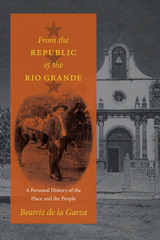 From the Republic of the Rio Grande: A Personal History of the Place and the People
By Beatriz de la Garza
University of Texas Press, 2013 The Republic of the Rio Grande had a brief and tenuous existence (1838–1840) before most of it was reabsorbed by Mexico and the remainder annexed by the United States, yet this region that straddles the Rio Grande has retained its distinctive cultural identity to the present day. Born on one side of the Rio Grande and raised on the other, Beatriz de la Garza is a product of this region. Her birthplace and its people are the subjects of this work, which fuses family memoir and borderlands history. From the Republic of the Rio Grande brings new insights and information to the study of transnational cultures by drawing from family papers supplemented by other original sources, local chronicles, and scholarly works. De la Garza has fashioned a history of this area from the perspective of individuals involved in the events recounted. The book is composed of nine sections spanning some two hundred years, beginning in the mid-1700s. Each section covers not only a chronological period but also a particular theme relating to the history of the region. De la Garza takes a personal approach, opening most sections with an individual observation or experience that leads to the central motif, whether this is the shared identity of the inhabitants, their pride in their biculturalism and bilingualism, or their deep attachment to the land of their ancestors.
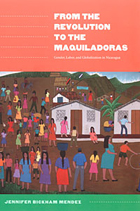 From the Revolution to the Maquiladoras: Gender, Labor, and Globalization in Nicaragua
Jennifer Bickham Mendez
Duke University Press, 2005 From the Revolution to the Maquiladoras is a major contribution to the study of globalization, labor, and women’s movements. Jennifer Bickham Mendez presents a detailed ethnographic account of the Nicaraguan Working and Unemployed Women’s Movement, “María Elena Cuadra” (mec), which emerged as an autonomous organization in 1994. Most of its efforts revolve around organizing women workers in Nicaragua’s free trade zones and working to improve conditions in maquiladora factories. Mendez examines the structural and cultural elements of mec in order to demonstrate how globalization affects grassroots advocacy for social and economic justice. She argues that globalization has created opportunities for new forms of organizing among those local populations that suffer its effects and that mec, which has forged vital links with transnational feminist and labor groups, exemplifies the possibilities—and pitfalls—of this new type of organizing. Mendez draws on interviews with leaders and program participants, including maquiladora workers; her participant observation while she worked as a volunteer within the organization; and analysis of the public statements, speeches, and texts written by mec members. She provides a sense of the day-to-day operations of the group as well as its strategies. By exploring the tension between mec and transnational feminist, labor, and solidarity networks, she illustrates how mec women’s outlooks are shaped by both their revolutionary roots within the Sandinista regime and their exposure to global discourses of human rights and citizenship. The complexities of the women’s labor movement analyzed in From the Revolution to the Maquiladoras speak to social and economic justice movements in the many locales around the world.
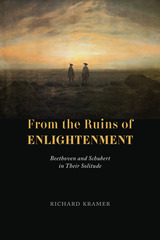 From the Ruins of Enlightenment: Beethoven and Schubert in Their Solitude
Richard Kramer
University of Chicago Press, 2023 Richard Kramer follows the work of Beethoven and Schubert from 1815 through to the final months of their lives, when each were increasingly absorbed in iconic projects that would soon enough inspire notions of “late style.”
Here is Vienna, hosting a congress in 1815 that would redraw national boundaries and reconfigure the European community for a full century. A snapshot captures two of its citizens, each seemingly oblivious to this momentous political environment: Franz Schubert, not yet twenty years old and in the midst of his most prolific year—some 140 songs, four operas, and much else; and Ludwig van Beethoven, struggling through a midlife crisis that would yield the song cycle An die ferne Geliebte, two strikingly original cello sonatas, and the two formidable sonatas for the “Hammerklavier,” opp. 101 and 106. In Richard Kramer’s compelling reading, each seemed to be composing “against”—Beethoven, against the Enlightenment; Schubert, against the looming presence of the older composer even as his own musical imagination took full flight.
From the Ruins of Enlightenment begins in 1815, with the discovery of two unique projects: Schubert’s settings of the poems of Ludwig Hölty in a fragmentary cycle and Beethoven’s engagement with a half dozen poems by Johann Gottfried Herder. From there, Kramer unearths previously undetected resonances and associations, illuminating the two composers in their “lonely and singular journeys” through the “rich solitude of their music.”
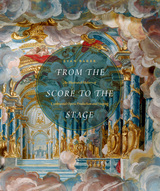 From the Score to the Stage: An Illustrated History of Continental Opera Production and Staging
Evan Baker
University of Chicago Press, 2013 Without scenery, costumes, and stage action, an opera would be little more than a concert. But in the audience, we know little (and think less) about the enormous efforts of those involved in bringing an opera to life—by the stagehands who shift scenery, the scenic artists who create beautiful backdrops, the electricians who focus the spotlights, and the stage manager who calls them and the singers to their places during the performance. The first comprehensive history of the behind-the-scenes world of opera production and staging, From the Score to the Stage follows the evolution of visual style and set design in continental Europe from its birth in the seventeenth century up to today. In clear, witty prose, Evan Baker covers all the major players and pieces involved in getting an opera onto the stage, from the stage director who creates the artistic concept for the production and guides the singers’ interpretation of their roles to the blocking of singers and placement of scenery. He concentrates on the people—composers, librettists, designers, and technicians—as well as the theaters and events that generated developments in opera production. Additional topics include the many difficulties in performing an opera, the functions of impresarios, and the business of music publishing. Delving into the absorbing and often neglected history of stage directing, theater architecture and technology, and scenic and lighting design, Baker nimbly links these technical aspects of opera to actual performances and performers, and the social context in which they appeared. Out of these details arise illuminating discussions of individual productions that cast new light on the operas of Wagner, Verdi, and others. Packed with nearly two hundred color illustrations, From the Score to the Stage is a revealing, always entertaining look at what happens before the curtain goes up on opening night at the opera house.
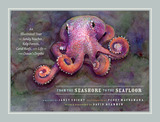 From the Seashore to the Seafloor: An Illustrated Tour of Sandy Beaches, Kelp Forests, Coral Reefs, and Life in the Ocean's Depths
Janet Voight and Peggy Macnamara
University of Chicago Press, 2022 An octopus expert and celebrated artist offer a deep dive to meet the enchanting inhabitants of the world’s marine ecosystems.
Have you ever walked along the beach and wondered what kind of creatures can be found beneath the waves? Have you pictured what it would be like to see the ocean not from the shore but from its depths? These questions drive Janet Voight, an expert on mollusks who has explored the seas in the submersible Alvin that can dive some 14,000 feet below the water’s surface. In this book, she partners with artist Peggy Macnamara to invite readers to share her undersea journeys of discovery.
With accessible scientific descriptions, Voight introduces the animals that inhabit rocky and sandy shores, explains the fragility of coral reefs, and honors the extraordinary creatures that must search for food in the ocean’s depths, where light and heat are rare. These fascinating insights are accompanied by Macnamara’s stunning watercolors, which illuminate these ecosystems and other scenes from Voight’s research. Together, they show connections between life at every depth—and warn of the threats these beguiling places and their eccentric denizens face.
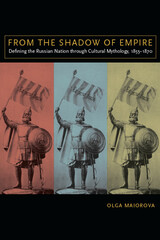 From the Shadow of Empire: Defining the Russian Nation through Cultural Mythology, 1855–1870
Olga Maiorova
University of Wisconsin Press, 2010 As nationalism spread across nineteenth-century Europe, Russia’s national identity remained murky: there was no clear distinction between the Russian nation and the expanding multiethnic empire that called itself “Russian.” When Tsar Alexander II’s Great Reforms (1855–1870s) allowed some freedom for public debate, Russian nationalist intellectuals embarked on a major project—which they undertook in daily press, popular historiography, and works of fiction—of finding the Russian nation within the empire and rendering the empire in nationalistic terms.
From the Shadow of Empire traces how these nationalist writers refashioned key historical myths—the legend of the nation’s spiritual birth, the tale of the founding of Russia, stories of Cossack independence—to portray the Russian people as the ruling nationality, whose character would define the empire. In an effort to press the government to alter its traditional imperial policies, writers from across the political spectrum made the cult of military victories into the dominant form of national myth-making: in the absence of popular political participation, wars allowed for the people’s involvement in public affairs and conjured an image of unity between ruler and nation. With their increasing reliance on the war metaphor, Reform-era thinkers prepared the ground for the brutal Russification policies of the late nineteenth century and contributed to the aggressive character of twentieth-century Russian nationalism.
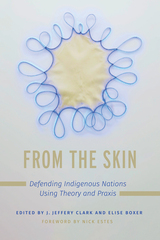 From the Skin: Defending Indigenous Nations Using Theory and Praxis
Edited by J. Jeffery Clark and Elise Boxer; Foreword by Nick Estes
University of Arizona Press, 2023 In this volume, contributors demonstrate the real-world application of Indigenous theory to the work they do in their own communities and how this work is driven by urgency, responsibility, and justice—work that is from the skin.
In From the Skin, contributors reflect on and describe how they apply the theories and concepts of Indigenous studies to their communities, programs, and organizations, and the ways the discipline has informed and influenced the same. They show the ways these efforts advance disciplinary theories, methodologies, and praxes. Chapters cover topics including librarianship, health programs, community organizing, knowledge recovery, youth programming, and gendered violence. Through their examples, the contributors show how they negotiate their peoples’ knowledge systems with knowledge produced in Indigenous studies programs, demonstrating how they understand the relationship between their people, their nations, and academia.
Editors J. Jeffery Clark and Elise Boxer propose and develop the term practitioner-theorist to describe how the contributors theorize and practice knowledge within and between their nations and academia. Because they live and exist in their community, these practitioner-theorists always consider how their thinking and actions benefit their people and nations. The practitioner-theorists of this volume envision and labor toward decolonial futures where Indigenous peoples and nations exist on their own terms.
Contributors
Randi Lynn Boucher-Giago
Elise Boxer
Shawn Brigman
J. Jeffery Clark
Nick Estes
Eric Hardy
Shalene Joseph
Jennifer Marley
Brittani R. Orona
Alexander Soto
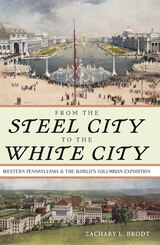 From the Steel City to the White City: Western Pennsylvania and the World's Columbian Exposition
Zachary L. Brodt
University of Pittsburgh Press, 2024 How Pittsburgh Positioned Itself as a Center of Culture and Innovation at the Turn of the Century
In From the Steel City to the White City, Zachary Brodt explores Western Pennsylvania’s representation at Chicago’s Columbian Exposition, the first major step in demonstrating that Pittsburgh was more than simply America’s crucible—it was also a region of developing culture and innovation. The 1893 Columbian Exposition presented a chance for the United States to prove to the world that it was an industrial giant ready to become a global superpower. At the same time, Pittsburgh, a commercial center that formerly served as a starting point for western expansion, found itself serving as a major transportation, and increasingly industrial, hub during this period of extensive growth. Natural resources like petroleum and coal allowed Western Pennsylvania to become one of the largest iron- and steel-producing regions in the world. The Chicago fairgrounds provided a lucrative opportunity for area companies not only to provide construction materials but to display the region’s many products. While Pittsburgh’s most famous contributions to the 1893 World’s Fair—alternating current electricity and the Ferris wheel—had a lasting impact on the United States and the world, other exhibits provided a snapshot of the area’s industries, natural resources, and inventions. The success of these exhibits, Brodt reveals, launched local companies into the twentieth century, ensuring a steady flow of work, money, and prestige
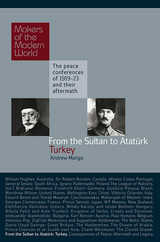 From the Sultan to Atatürk: Turkey
Andrew Mango
Haus Publishing, 2009 World War I sounded the death knell of empires. The forces of disintegration affected several empires simultaneously. To that extent they were impersonal. But prudent statesmen could delay the death of empires, rulers such as Emperor Franz Josef II of Austria-Hungary and the Ottoman Sultan Abdülhamid II. Adventurous rulers - Kaiser Wilhelm of Germany and Enver Pasha in the Ottoman Empire - hastened it. Enver's decision to enter the war on the side of Germany destroyed the Ottoman state. It may have been doomed in any case, but he was the agent of its doom. The last Sultan Mehmet VI Vahdettin thought he could salvage the Ottoman state in something like its old form. But Vahdettin and his ministers could not succeed because the victorious Allies had decided on the final partition of the Ottoman state. The chief proponent of partition was Lloyd George, heir to the Turcophobe tradition of British liberals, who fell under the spell of the Greek irredentist politician Venizelos. With these two in the lead, the Allies sought to impose partition on the Sultan's state. When the Sultan sent his emissaries to the Paris peace conference they could not win a reprieve. The Treaty of Sèvres which the Sultan's government signed put an end to Ottoman independence. The Treaty of Sèvres was not ratified. Turkish nationalists, with military officers in the lead, defied the Allies, who promptly broke ranks, each one trying to win concessions for himself at the expense of the others. Mustafa Kemal emerged as the leader of the military resistance. Diplomacy allowed Mustafa Kemal to isolate his people's enemies: Greek and Armenian irredentists. Having done so, he defeated them by force of arms. In effect, the defeat of the Ottoman empire in the First World War was followed by the Turks' victory in two separate wars: a brief military campaign against the Armenians and a long one against the Greeks. Lausanne - where General Ismet succeeded in securing peace on Turkey's terms - was the founding charter of the modern Turkish nation state. But more than that it showed that empires could no longer rule peoples against their wishes. This need not be disastrous: Mustafa Kemal demonstrated that the interests of developed countries were compatible with those of developing ones. He fought the West in order to become like it. Where his domestic critics wanted to go on defying the West, Mustafa Kemal saw that his country could fare best in cooperation with the West.
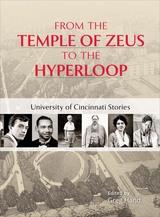 From the Temple of Zeus to the Hyperloop: University of Cincinnati Stories
Edited by Greg Hand
University of Minnesota Press, 2018 As the University of Cincinnati celebrates its bicentennial, students, faculty, staff, and alumni look back on the university’s remarkable past and its progression as a pioneer in higher education. From the Temple of Zeus to the Hyperloop: University of Cincinnati Stories reflects the breadth and diversity of the University of Cincinnati over its rich and eventful history, emphasizing just what makes UC’s history so special and inspiring—its stories.
Former Ohio Governor Bob Taft remembers his law school days in a building named for his great-grandfather. Broadway star Faith Prince recalls her musical theater start at UC’s College-Conservatory of Music. More than thirty-five contributors provide their own unique perceptions of this extraordinary urban university. Some are well-known names like Taft and Prince, while others are current students and alumni whose education and futures were profoundly shaped by memorable experiences connected to UC. Clark Beck recounts the struggles he initially faced upon coming to UC and offers readers an inspiring story of perseverance and tenacity. Sid Thatham gives a captivating tale of his move from India and the home base he made in Cincinnati with UC graduate students. Other contributors celebrate the relationships, such as that between the strong-willed duo of Jack Rouse and Helen Laird, that give UC its storied past.
In From the Temple of Zeus to the Hyperloop, anyone can find a person, whether it be the trailblazing Lucy Braun or the celebrated Carl Blegen, or a place, be it the changing landscape of Ludlow Avenue or the new frontier for the DAAP College, to which he or she can relate. Such figures, places, and stories present a sampling of the UC experience. From the Temple of Zeus to the Hyperloop offers readers an inside look at the many lives that have influenced UC and the opportunity to envision how their own stories can be a part of its future.
Just as Hand titles his introduction, “a dedicated crew of bearcats assembled this book,” the University of Cincinnati and its story continue to be a community effort, deeply intertwined with the lives of the people who have made up the university and its two-hundred years.
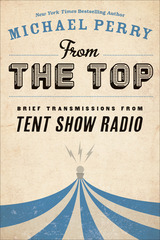 From the Top: Brief Transmissions from Tent Show Radio
Michael Perry
Wisconsin Historical Society Press, 2013 “Bottom line is, I’m the kind of guy who’s happy to go to the opera, but I should like to be allowed to wear steel-toed boots with my evening suit. I like to read Harper’s with a chaser of Varmint Hunter Magazine. Maybe that’s why I enjoy a good show under canvas. Here we sit, brain-deep in arts and culture, but we’re also just people hanging out in a tent, some of us wearing boots, a few of us wearing Birkenstocks, but best of all we’re breathing free fresh air filled with music.” From Scandihoovian Spanglish to snickering chickens, New York Times bestselling author and humorist Michael Perry navigates a wide range of topics in this collection of brief essays drawn from his weekly appearances on the nationally syndicated Tent Show Radio program. Fatherhood, dumpster therapy, dangerous wedding rings, Christmas trees, used cars, why you should have bacon in your stock portfolio, loggers in clogs—whatever the subject, Perry has a rare ability to touch both the funny bone and the heart.
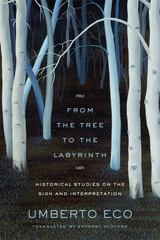 From the Tree to the Labyrinth: Historical Studies on the Sign and Interpretation
Umberto Eco
Harvard University Press, 2014 The way we create and organize knowledge is the theme of From the Tree to the Labyrinth, a major achievement by one of the world’s foremost thinkers on language and interpretation. Umberto Eco begins by arguing that our familiar system of classification by genus and species derives from the Neo-Platonist idea of a “tree of knowledge.” He then moves to the idea of the dictionary, which—like a tree whose trunk anchors a great hierarchy of branching categories—orders knowledge into a matrix of definitions. In Eco’s view, though, the dictionary is too rigid: it turns knowledge into a closed system. A more flexible organizational scheme is the encyclopedia, which—instead of resembling a tree with finite branches—offers a labyrinth of never-ending pathways. Presenting knowledge as a network of interlinked relationships, the encyclopedia sacrifices humankind’s dream of possessing absolute knowledge, but in compensation we gain the freedom to pursue an infinity of new connections and meanings.
Moving effortlessly from analyses of Aristotle and James Joyce to the philosophical difficulties of telling dogs from cats, Eco demonstrates time and again his inimitable ability to bridge ancient, medieval, and modern modes of thought. From the Tree to the Labyrinth is a brilliant illustration of Eco’s longstanding argument that problems of interpretation can be solved only in historical context.
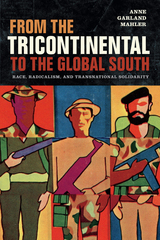 From the Tricontinental to the Global South: Race, Radicalism, and Transnational Solidarity
Anne Garland Mahler
Duke University Press, 2018 In From the Tricontinental to the Global South Anne Garland Mahler traces the history and intellectual legacy of the understudied global justice movement called the Tricontinental—an alliance of liberation struggles from eighty-two countries, founded in Havana in 1966. Focusing on racial violence and inequality, the Tricontinental's critique of global capitalist exploitation has influenced historical radical thought, contemporary social movements such as the World Social Forum and Black Lives Matter, and a Global South political imaginary. The movement's discourse, which circulated in four languages, also found its way into radical artistic practices, like Cuban revolutionary film and Nuyorican literature. While recent social movements have revived Tricontinentalism's ideologies and aesthetics, they have largely abandoned its roots in black internationalism and its contribution to a global struggle for racial justice. In response to this fractured appropriation of Tricontinentalism, Mahler ultimately argues that a renewed engagement with black internationalist thought could be vital to the future of transnational political resistance.
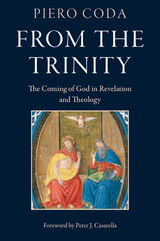 From the Trinity : The Coming of God in Revelation and Theology
Piero Coda
Catholic University of America Press, 2020 From the Trinity provides an overall view of the history and the philosophical and theological significance of God the Trinity, not only from a religious point of view but from an anthropological and socio-cultural view as well. The perspective is that of Christian doctrine, specifically Catholic, in dialogue with the cultural sensitivity of our times and with the religious pluralism that characterizes it.
Following the generative-progressive method proposed by Vatican II, the book begins with a phenomenological reading of the signs of the times, with special focus upon the performative aspect of the announcement and the doctrine of faith. In particular, constant attention to the contribution made by the mystics and great charisms (from Augustine of Hippo to Francis of Assisi and Theresa of Avila up until Therese of Lisieux, Edith Stein and Chaira Lubich) toward a deeper understanding of the Trinitarian truth.
From the Trinity is unique in what it offers not only for Trinitarian theology, but also for other theological disciplines (Christology, Pneumatology, Anthropology, Ecclesiology, etc.) – in which the Trinity shines forth as the central and enlightening truth – as well as for philosophy, the humanities and the natural sciences. This perspective is especially developed in terms of a Trinitarian ontology (see Part V) by which reality is understood in light of the revelation of the Trinity. The implications of the incarnation of the Son of God and the gift of the Holy Spirit are taken seriously in studying the truth of all things as they are perceived in the space created by living and thinking “in” Jesus, united to the Father in the Spirit, as suggested by the title of the book, looking upon reality “From the Trinity.”
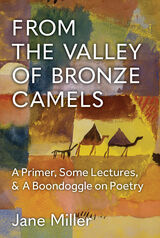 From the Valley of Bronze Camels: A Primer, Some Lectures, & A Boondoggle on Poetry
Jane Miller
University of Michigan Press, 2022 Jane Miller loves poetry. In these provocative and deeply insightful essays, she unpacks the work of giants like Adrienne Rich, Paul Celan, Marina Tsvetaeva, Osip Mandelstam, and Federico García Lorca alongside painters such as Caravaggio and Paul Klee, as well as ancient Chinese music and techniques of the contemporary poem. Miller explores the use of the question mark in the history of poetry and its function as a revelation of poetic voice. She considers the positive and negative aspects of surrealism on the contemporary poem, its anti-feminist origins in France, its contemporary usage, and the benefits of super-real images. Miller examines how identity politics might affect the imagination. She describes ancient Chinese musical instruments to show how their sounds resonate off/in American poems and on the aural integrity of the lyric poem. She interrogates the political implications of language and the degeneration and regeneration of words. Finally, in an essay about what she dares not say about poetry, she comes out against forms of surrealism, narrative, jargon, rhetoric, irony, and appropriation. This masterful work can be read as advice to a young writer, but it also invites us into the mind of a writer who has developed her craft through the course of a lifetime of writing, reading, and exploring the world, showing not only the ideas that influenced her—feminist, lesbian, and international works—but also how Miller has, in turn, influenced ideas.
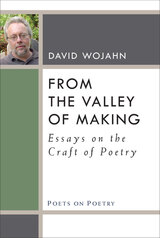 From the Valley of Making: Essays on the Craft of Poetry
David Wojahn
University of Michigan Press, 2015 David Wojahn examines the state of American verse as it enters the first decades of a new millennium, focusing on both the challenges and opportunities of an ancient art as it tries to adapt to the cultural, technological, and political transformations of our turbulent era. Each of these nine essays makes an impassioned and nuanced argument against the so-called marginalization of poetry in contemporary American culture. Among the work included is a penetrating essay on the role of politics in contemporary verse, a querulous examination of the rise of what Wojahn terms “the Google poem,” and a meditation on poetry and “self-doubt.” Among the figures he considers are American poets such as Hayden Carruth, John Berryman, Linda Bierds, and Tom Sleigh, as well as crucial modern international poets, among them Nazim Hikmet, Zbigniew Herbert, C.P. Cavafy, and Tomas Transtromer. These are personable, opinionated, and, above all, readable essays by a widely admired poet-critic.
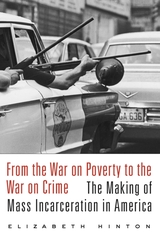 From the War on Poverty to the War on Crime: The Making of Mass Incarceration in America
Elizabeth Hinton
Harvard University Press, 2016 Co-Winner of the Thomas J. Wilson Memorial Prize
A New York Times Notable Book of the Year
A New York Times Book Review Editors’ Choice
A Wall Street Journal Favorite Book of the Year
A Choice Outstanding Academic Title of the Year
A Publishers Weekly Favorite Book of the Year
In the United States today, one in every thirty-one adults is under some form of penal control, including one in eleven African American men. How did the “land of the free” become the home of the world’s largest prison system? Challenging the belief that America’s prison problem originated with the Reagan administration’s War on Drugs, Elizabeth Hinton traces the rise of mass incarceration to an ironic source: the social welfare programs of Lyndon Johnson’s Great Society at the height of the civil rights era.
“An extraordinary and important new book.”
—Jill Lepore, New Yorker
“Hinton’s book is more than an argument; it is a revelation…There are moments that will make your skin crawl…This is history, but the implications for today are striking. Readers will learn how the militarization of the police that we’ve witnessed in Ferguson and elsewhere had roots in the 1960s.”
—Imani Perry, New York Times Book Review
 From the Womb to the Body Politic: Raising the Nation in Enlightenment Russia
Anna Kuxhausen
University of Wisconsin Press, 2012 In Russia during the second half of the eighteenth century, a public conversation emerged that altered perceptions of pregnancy, birth, and early childhood. Children began to be viewed as a national resource, and childbirth heralded new members of the body politic. The exclusively female world of mothers, midwives, and nannies came under the scrutiny of male physicians, state institutions, a host of zealous reformers, and even Empress Catherine the Great.
Making innovative use of obstetrical manuals, belles lettres, children’s primers, and other primary documents from the era, Anna Kuxhausen draws together many discourses—medical, pedagogical, and political—to show the scope and audacity of new notions about childrearing. Reformers aimed to teach women to care for the bodies of pregnant mothers, infants, and children according to medical standards of the Enlightenment. Kuxhausen reveals both their optimism and their sometimes fatal blind spots in matters of implementation. In examining the implication of women in public, even political, roles as agents of state-building and the civilizing process, From the Womb to the Body Politic offers a nuanced, expanded view of the Enlightenment in Russia and the ways in which Russians imagined their nation while constructing notions of childhood.
From Theory to Practice: How to Assess and Apply Impartiality in News and Current Affairs
Edited by Leon Barkho
Intellect Books, 2013 From Theory to Practice is the first scholarly look at the possibilities and challenges of impartial and objective journalism in our digitized media world. This volume brings together contributions from editors at premiere news outlets like Reuters and the BBC to discuss how to assess, measure, and apply impartiality in news and current affairs in a world where the impact of digital technologies is constantly changing how news is covered, presented, and received. In this changing media environment, impartial journalism is as crucial as it ever was in traditional media, and this book offers an essential analysis of how to navigate a media milieu in which technology has sharply reduced the gatekeeping role news gatherers and producers used to have in controlling content flow to audiences.
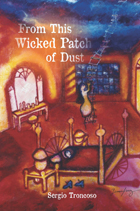 From This Wicked Patch of Dust
Sergio Troncoso
University of Arizona Press, 2011 In the border shantytown of Ysleta, Mexican immigrants Pilar and Cuauhtémoc Martínez strive to teach their four children to forsake the drugs and gangs of their neighborhood. The family’s hardscrabble origins are just the beginning of this sweeping new novel from Sergio Troncoso.
Spanning four decades, this is a story of a family’s struggle to become American and yet not be pulled apart by a maelstrom of cultural forces. As a young adult, daughter Julieta is disenchanted with Catholicism and converts to Islam. Youngest son Ismael, always the bookworm, is accepted to Harvard but feels out of place in the Northeast where he meets and marries a Jewish woman. The other boys—Marcos and Francisco—toil in their father’s old apartment buildings, serving as the cheap labor to fuel the family’s rise to the middle class. Over time, Francisco isolates himself in El Paso while Marcos eventually leaves to become a teacher, but then returns, struggling with a deep bitterness about his work and marriage. Through it all, Pilar clings to the idea of her family and tries to hold it together as her husband’s health begins to fail.
This backdrop is then shaken to its core by the historic events of 2001 in New York City. The aftermath sends shockwaves through this newly American family. Bitter conflicts erupt between siblings and the physical and cultural spaces between them threaten to tear them apart. Will their shared history and once-common dreams be enough to hold together a family from Ysleta, this wicked patch of dust?
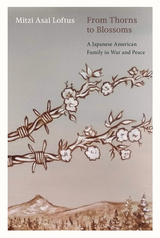 From Thorns to Blossoms: A Japanese American Family in War and Peace
Mitzi Asai Loftus
Oregon State University Press, 2024 Mitsuko “Mitzi” Asai was not yet ten years old in the spring of 1942 when President Roosevelt’s Executive Order 9066 sent 120,000 people of Japanese ancestry—about two-thirds of them US citizens—from their homes on the West Coast to inland prison camps. They included Mitzi and most of her family, who owned a fruit orchard in Hood River, Oregon. The Asais spent much of World War II in the camps while two of the older sons served in the Pacific in the US Army. Three years later, when the camps began to close, the family returned to Hood River to find an altered community. Shop owners refused to serve neighbors they had known for decades; racism and hostility were open and largely unchecked. Humiliation and shame drove teenaged Mitzi to reject her Japanese heritage, including her birth name. More than a decade later, her life took another turn when a Fulbright grant sent her to teach in Japan, where she reconnected with her roots. In From Thorns to Blossoms, Mitzi recounts her rich and varied life, from a childhood surrounded by barbed wire and hatred to a successful career as a high school English teacher and college instructor in English as a Second Language. Today, Asai descendants continue to tend the Hood River farm while the town confronts its shameful history. Originally published in 1990 as Made in Japan and Settled in Oregon, this revised and expanded edition describes the positive influence Mitzi’s immigrant parents had on their children, provides additional context for her story, and illuminates the personal side of a dark chapter in US history. It’s the remarkable story of a transformation from thorns into blossoms, pain into healing.
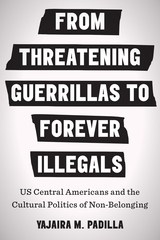 From Threatening Guerrillas to Forever Illegals: US Central Americans and the Cultural Politics of Non-Belonging
Yajaira M. Padilla
University of Texas Press, 2022 The experience of Central Americans in the United States is marked by a vicious contradiction. In entertainment and information media, Salvadorans, Guatemalans, Nicaraguans, and Hondurans are hypervisible as threatening guerrillas, MS-13 gangsters, maids, and “forever illegals.” Central Americans are unseen within the broader conception of Latinx community, foreclosing avenues to recognition. Yajaira M. Padilla explores how this regime of visibility and invisibility emerged over the past forty years—bookended by the right-wing presidencies of Ronald Reagan and Donald Trump—and how Central American immigrants and subsequent generations have contested their rhetorical disfiguration. Drawing from popular films and TV, news reporting, and social media, Padilla shows how Central Americans in the United States have been constituted as belonging nowhere, imagined as permanent refugees outside the boundaries of even minority representation. Yet in documentaries about cross-border transit through Mexico, street murals, and other media, US Central Americans have counteracted their exclusion in ways that defy dominant paradigms of citizenship and integration.
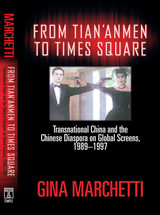 From Tian'anmen to Times Square: Transnational China and the Chinese Diaspora on Global Screens, 1989-1997
Gina Marchetti
Temple University Press, 2006 Global perceptions of China have changed dramatically since the massive student protests that took place in Tian'anmen Square in April 1989. The media spotlight trained on Beijing, and the international uproar over the events of that spring still shape the world's perceptions of the People's Republic and the ways that Chinese people, within and beyond China, see and portray themselves.
In From Tian'anmen to Times Square, leading film scholar Gina Marchetti considers the complex changes in the ways that China and the Chinese have been portrayed in cinema and media arts since the Tian'anmen revolt. Drawing on her interviews with leading contemporary Chinese filmmakers, Marchetti looks at a wide range of work by Chinese and non-Chinese media artists working in China, Hong Kong, Taiwan, and Singapore and on transnational co-productions involving those places. Focusing on the intersections of race, ethnicity, gender, and sexuality on global screens, Marchetti traces the momentous political, cultural, social, and economic forces confronting contemporary media artists and filmmakers working within "Greater China."
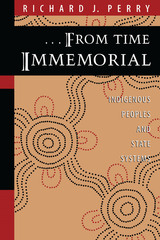 From Time Immemorial: Indigenous Peoples and State Systems
By Richard J. Perry
University of Texas Press, 1996 Around the globe, people who have lived in a place "from time immemorial" have found themselves confronted by and ultimately incorporated within larger state systems. During more than three decades of anthropological study of groups ranging from the Apache to the indigenous peoples of Kenya, Richard J. Perry has sought to understand this incorporation process and, more importantly, to identify the factors that drive it. This broadly synthetic and highly readable book chronicles his findings. Perry delves into the relations between state systems and indigenous peoples in Canada, the United States, Mexico, and Australia. His explorations show how, despite differing historical circumstances, encounters between these state systems and native peoples generally followed a similar pattern: invasion, genocide, displacement, assimilation, and finally some measure of apparent self-determination for the indigenous people—which may, however, have its own pitfalls. After establishing this common pattern, Perry tackles the harder question—why does it happen this way? Defining the state as a nexus of competing interest groups, Perry offers persuasive evidence that competition for resources is the crucial factor in conflicts between indigenous peoples and the powerful constituencies that drive state policies. These findings shed new light on a historical phenomenon that is too often studied in isolated instances. This book will thus be important reading for everyone seeking to understand the new contours of our postcolonial world.
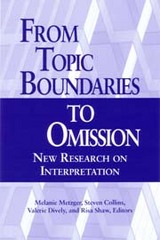 From Topic Boundaries to Omission: New Research on Interpretation
Melanie Metzger
Gallaudet University Press, 2003 This new collection examines several facets of signed language interpreting. Claudia Angelelli’s study confirms that conference, courtroom, and medical interpretation can no longer be seen as a two-party conversation with an “invisible” interpreter, but as a three-party conversation in which the interpreter plays an active role. Laura M. Sanheim defines different turn-taking elements in a medical setting as two overlapping conversations, one between the patient and the interpreter and the other between the interpreter and the medical professional. In her analysis of discourse at a Deaf revival service, Mary Ann Richey demonstrates how Deaf presenters and audiences interact even in formal settings, creating special challenges for interpreters. Jemina Napier shares her findings on the nature and occurrence of omissions by interpreters in Australian Sign Language and English exchanges. Elizabeth Winston and Christine Monikowski describe different strategies used by interpreters to indicate topic shifts when interpreting into American Sign Language and when transliterating. The study concludes with Bruce Sofinski’s analysis of nonmanual elements used by interpreters in sign language transliteration.
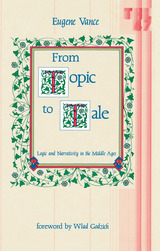 From Topic to Tale: Logic and Narrativity in the Middle Ages
Eugene VanceForeword by Wlad Godzich
University of Minnesota Press, 1987 From Topic to Tale was first published in 1987. Minnesota Archive Editions uses digital technology to make long-unavailable books once again accessible, and are published unaltered from the original University of Minnesota Press editions. The transition from the Middle Ages to the Renaissance has been discussed since the 1940s as a shift from a Latinate culture to one based on a vernacular language, and, since the 1960s, as a shift from orality to literacy. From Topic to Tale focuses on this multifaceted transition, but it poses the problem in different terms: it shows how a rhetorical tradition was transformed into a textual one, and ends ultimately in a discussion of the relationship between discourse and society. The rise of French vernacular literacy in the twelfth century coincided with the emergence of logic as a powerful instrument of the human mind. With logic come a new concern for narrative coherence and form, a concern exemplified by the work of Chretien de Troyes. Many brilliant poetic achievements crystallized in the narrative art of Chretien, establishing an enduring tradition of literary technique for all of Europe. Eugene Vance explores the intellectual context of Chretien's vernacular literacy, and in particular, the interaction between the three "arts of language" (grammar, logic, and rhetoric) compromising the trivium. Until Vance, few critics have studied the contribution of logic to Chretiens poetics, nor have they assessed the ethical bond between rationalism and the new heroic code of romance. Vance takes Chretien de Troyes' great romance, Yvain ou le chevalier au lion,as the centerpiece of the Twelfth-Century Renaissance. It is also central to his own thesis, which shows how Chretien forged a bold new vision of humans as social beings situated between beasts and angels and promulgated the symbolic powers of language, money, and heraldic art to regulate the effects of human desire. Vance's reading of the Yvain contributes not only to the intellectual history of the Middle Ages, but also to the continuing dialogue between contemporary critical theory and medieval culture. Eugene Vance is professor of French and comparative literature at Emory University and principal editor of a University of Nebraska series, Regents Studies in Medieval Culture. Wlad Godzich is director of the Center for Humanistic Studies at the University of Minnesota and co-editor of the series Theory and History of Literature.
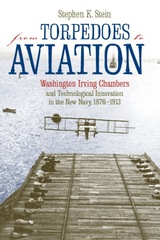 From Torpedoes to Aviation: Washington Irving Chambers & Technological Innovation in the New Navy 1876 to 1913
Stephen K. Stein
University of Alabama Press, 2007 The central figure in the modernization of the U.S. Navy.
The career of Washington Irving Chambers spans a formative period in the development of the United States Navy: He entered the Naval Academy in the doldrum years of obsolete, often rotting ships, and left after he had helped like-minded officers convince Congress and the public of the need to adopt a new naval strategy built around a fleet of technologically advanced battleships. He also laid the groundwork for naval aviation and the important role it would play in the modern navy. This work covers Chambers’s early naval career, his work at the new Office of Naval Intelligence, his participation in the Greeley Relief Expedition, and a survey for the projected isthmian canal through Nicaragua, before becoming the key advocate for naval modernization. As such, Chambers worked as a pioneering torpedo designer, supervised construction of the Maine, modernized the New York Navy Yard, and became a member of the first permanent faculty at the Naval War College.
During his long career, Chambers not only designed torpedoes, but also several warships, including a prototype Dreadnought-style battleship and a host of small devices that ranged from torpedo guidance systems to the first catapult for launching airplanes from ships. At the close of his career, Chambers purchased the navy’s first aircraft and founded its air arm. Working with Glenn Curtiss, Chambers guided a coalition of aviation enthusiasts and pioneers who popularized naval aviation and demonstrated its capabilities. Chambers arranged the first take-off and landing of an airplane from a ship and other demonstrations of naval aviation. Combined with his tireless advocacy for modernization, these contributions secured a place in naval and aviation history for the innovator.
From Tribalism to Nationalism: The Anthropological Turn in Laos – A Tribute to Grant Evans
Edited by Yves Goudineau and Vanina Bouté
National University of Singapore Press, 2022 Laos has long been considered by ethnologists as a unique place of study. To this day, diverse ethnic minorities make up over half the country’s population. In earlier times, several good ethnographies were made but usually they were narrow in scope. War and revolution then made fieldwork impossible in Laos until the 1990s, when some international researchers returned, often in difficult and precarious conditions, bringing new theoretical perspectives. This volume brings together several such studies by this new generation of researchers, their fieldwork often joint projects in collaboration with Lao researchers. Published in collaboration with the École française d’Extrême-Orient (EFEO), the book is a tribute to the late Grant Evans, whose work remains emblematic of this ‘anthropological turn’ in Lao studies.
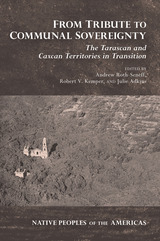 From Tribute to Communal Sovereignty: The Tarascan and Caxcan Territories in Transition
Edited by Andrew Roth-Seneff, Robert V. Kemper, and Julie Adkins
University of Arizona Press, 2015 From Tribute to Communal Sovereignty examines both continuity and change over the last five centuries for the indigenous peoples of central western Mexico, providing the first sweeping and comprehensive history of this important region in Mesoamerica.
The continuities elucidated concern ancestral territorial claims that date back centuries and reflect the stable geographic locations occupied by core populations of indigenous language–speakers in or near their pre-Columbian territories since the Postclassical period, from the thirteenth to late fifteenth centuries. A common theme of this volume is the strong cohesive forces present, not only in the colonial construction of Christian village communities in Purhépecha and Nahuatl groups in Michoacán but also in the demographically less inclusive Huichol (Wixarika), Cora, and Tepehuan groups, whose territories were more extensive.
The authors review a cluster of related themes: settlement patterns of the last five centuries in central western Mexico, language distribution, ritual representation of territoriality, processes of collective identity, and the forms of participation and resistance during different phases of Mexican state formation. From such research, the question arises: does the village community constitute a unique level of organization of the experience of the original peoples of central western Mexico? The chapters address this question in rich and complex ways by first focusing on the past configurations and changes in lifeways during the transition from pre-Columbian to Spanish rule in tributary empires, then examining the long-term postcolonial process of Mexican independence that introduced the emerging theme of the communal sovereignty.
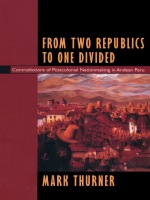 From Two Republics to One Divided: Contradictions of Postcolonial Nationmaking in Andean Peru
Mark Thurner
Duke University Press, 2001 From Two Republics to One Divided examines Peru’s troubled transition from colonial viceroyalty to postcolonial republic from the local perspective of Andean peasant politics. Thurner’s reading of the Andean peasantry’s engagement and disengagement with the postcolonial state challenges long-standing interpretations of Peruvian and modern Latin American history and casts a critical eye toward Creole and Eurocentric ideas about citizenship and nationalism.
Working within an innovative and panoramic historical and linguistic framework, Thurner examines the paradoxes of a resurgent Andean peasant republicanism during the mid-1800s and provides a critical revision of the meaning of republican Peru’s bloodiest peasant insurgency, the Atusparia Uprising of 1885. Displacing ahistorical and nationalist readings of Inka or Andean continuity, and undermining the long-held notion that the colonial legacy is the dominant historical force shaping contemporary Andean reality, Thurner suggests that in Peru, the postcolonial legacy of Latin America’s nation-founding nineteenth century transfigured, and ultimately reinvented, the colonial legacy in its own image.
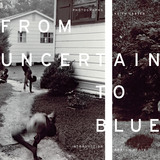 From Uncertain to Blue
By Keith Carter
University of Texas Press, 2011 "In the beginning, there was no real plan, just a road trip that became a journey." In the years 1986 and 1987, Keith Carter and his wife, Patricia, visited one hundred small Texas towns with intriguing names like Diddy Waw Diddy, Elysian Fields, and Poetry. He says, "I tried to make my working method simple and practical: one town, one photograph. I would take several rolls of film but select only one image to represent that dot on my now-tattered map. The titles of the photographs are the actual names of the small towns. . . ." Carter created a body of work that evoked the essence of small-town life for many people, including renowned playwright and fellow Texan, Horton Foote. In 1988, Carter published his one town/one picture collection in From Uncertain to Blue, a landmark book that won acclaim both nationally and internationally for the artistry, timelessness, and universal appeal of its images—and established Carter as one of America's most promising fine art photographers. Now a quarter century after the book's publication, From Uncertain to Blue has been completely re-envisioned and includes a new essay in which Carter describes how the search for photographic subjects in small towns gradually evolved into his first significant work as an artist. He also offers additional insight into his creative process by including some of his original contact sheets. And Patricia Carter gives her own perspective on their journey in her amplified notes about many of the places they visited as they discovered the world of possibilities from Uncertain to Blue.
From Unincorporated Territory [åmot]
Craig Santos Perez
Omnidawn, 2023 Winner of the National Book Award for Poetry, this collection of experimental and visual poems dives into the history and culture of the poet’s homeland, Guam.
This book is the fifth collection in Craig Santos Perez’s ongoing from unincorporated territory series about the history of his homeland, the western Pacific island of Guåhan (Guam), and the culture of his indigenous Chamoru people. “Åmot” is the Chamoru word for “medicine,” commonly referring to medicinal plants. Traditional Chamoru healers were known as yo’åmte; they gathered åmot in the jungle and recited chants and invocations of taotao’mona, or ancestral spirits, in the healing process.
Through experimental and visual poetry, Perez explores how storytelling can become a symbolic form of åmot, offering healing from the traumas of colonialism, militarism, migration, environmental injustice, and the death of elders.
from unincorporated territory [guma’]
Craig Santos Perez
Omnidawn, 2014 Craig Santos Perez, a native Chamoru from the Pacific Island of Guåhan (Guam), has lived for two decades away from his homeland. This new collection maps the emotional and geographic cartographies of his various migrations, departures, and arrivals. Through a variety of poetic forms, the poet highlights the importance of origins and customs amidst new American cultures and terrains. Furthermore, this book draws attention to, and protests, the violent currents of colonialism and militarism currently threatening Guåhan, a “strategic” US territory since 1898. The poet memorializes what his people have lost and insists that we must protect and defend what we have left of home. This collection will engage those interested in Pacific literature, multicultural, indigenous poetry, mixed-genre, multilingual experiments, ecopoetics, and those who want to explore intersections between poetry, politics, history, and culture.
from unincorporated territory [hacha]
Craig Santos Perez
Omnidawn, 2017 from unincorporated territory [hacha] is the first book of native Chamorro poet Craig Santos Perez’s ongoing series about his homeland, the Western Pacific Island of Guåhan (Guam). Perez weaves avant-garde, eco-poetic, indigenous, documentary, multilingual, and abstract expressionist modes to tell the complex story of Guam’s people, culture, history, politics, and ecologies. Since its original publication in 2008, [hacha] has received positive reviews, and it has been taught in universities throughout Asia, the Pacific, the United States, Canada, and Europe. This new and revised edition aims to bring the book to a new generation of readers.
from unincorporated territory [lukao]
Craig Santos Perez
Omnidawn, 2017 from unincorporated territory [lukao] is the fourth book in native Chamorro poet Craig Santos Perez’s ongoing series about his homeland, the Western Pacific Island of Guåhan (Guam), and his current home, Hawai?i. He utilizes eco-poetic, decolonial, diasporic, indigenous, documentary, epic, and avant-garde modes to weave stories of creation, birth, migration, food sovereignty, and parenting. This work not only protests the devastating impacts of colonialism, militarism, and environmental injustice across the Pacific, it also expresses a vision of a sustainable and hopeful future.
 from unincorporated territory [saina]
Craig Santos Perez
Omnidawn, 2010 With the Saina as his figurative vessel—a ship built in modern times as an exact replica of the swift outriggers designed and sailed by the Chamorro people until banned by their oppressors—Craig Santos Perez deftly navigates the complexities in his bracing exploration of the personal, historical, cultural, and natural elements of his native Guam and its people. As the title—from unincorporated territory [saina]—suggests, by understanding where we are from, we can best determine where we are going. Perez collages primary texts and oral histories of the colonial domination and abuse brought by the Spanish, the Japanese, the United States, and the capitalist entertainment/travel industry, with intimate stories of his childhood experiences on Guam, his family’s immigration to the US, and the evocatively fragmentary myths of his ancestors. Resonant too in Perez’s title, and throughout this work, is this poet’s evocation of the unincorporated and unfathomed elements of our natures, as he seeks the means to access an expansiveness that remains inexpressible in any language. Perez is not afraid to press language beyond the territories of ‘the known’ as he investigates both the anguish and the possibilities that horizon as one attempts to communicate the spoken and unspoken languages of one’s native people, while fully appreciating the suffering inherent in every word he will use that is pronounced in, and thus pronounces, the language of their oppressors.
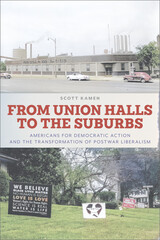 From Union Halls to the Suburbs: Americans for Democratic Action and the Transformation of Postwar Liberalism
Scott Kamen
University of Massachusetts Press, 2023 For decades, Americans for Democratic Action (ADA) exerted an outsized pull on the political stage. Formed in 1947 by anticommunist liberals such as economist John Kenneth Galbraith and historian Arthur Schlesinger Jr., the ADA established itself as the most prominent liberal organization in the United States for more than a quarter century. Shaped by the ADA, the New Politics movement upended Democratic Party politics with its challenge to the Vietnam War, demands for redistributive economic policies, and development of a far-reaching politics of race, gender, and sexuality. By bringing the ADA and its influential public intellectuals into the story of the New Politics movement, Scott Kamen reveals how American liberalism shifted away from the working-class concerns of the New Deal era and began to cater to the interests of a new, suburban professional class. By the 1980s, many Democratic politicians, activists, and voters had embraced a neoliberal ideology that coupled socially liberal attitudes with market-based solutions, eschewing an older progressive politics steeped in labor issues.
 From Utopia to Apocalypse: Science Fiction and the Politics of Catastrophe
Peter Y. Paik
University of Minnesota Press, 2010 "I read Peter Y. Paik’s lucid, graceful, ruthless book in one single astonished sitting. I scarred it all over with arrows and exclamation points, so I can read it again as soon as possible." —Bruce Sterling Revolutionary narratives in recent science fiction graphic novels and films compel audiences to reflect on the politics and societal ills of the day. Through character and story, science fiction brings theory to life, giving shape to the motivations behind the action as well as to the consequences they produce. In From Utopia to Apocalypse, Peter Y. Paik shows how science fiction generates intriguing and profound insights into politics. He reveals that the fantasy of putting annihilating omnipotence to beneficial effect underlies the revolutionary projects that have defined the collective upheavals of the modern age. Paik traces how this political theology is expressed, and indeed literalized, in popular superhero fiction, examining works including Alan Moore and Dave Gibbons’s graphic novel Watchmen, the science fiction cinema of Jang Joon-Hwan, the manga of Hayao Miyazaki, Alan Moore’s V for Vendetta, and the Matrix trilogy. Superhero fantasies are usually seen as compensations for individual feelings of weakness, victimization, and vulnerability. But Paik presents these fantasies as social constructions concerned with questions of political will and the disintegration of democracy rather than with the psychology of the personal. What is urgently at stake, Paik argues, is a critique of the limitations and deadlocks of the political imagination. The utopias dreamed of by totalitarianism, which must be imposed through torture, oppression, and mass imprisonment, nevertheless persist in liberal political systems. With this reality looming throughout, Paik demonstrates the uneasy juxtaposition of saintliness and cynically manipulative realpolitik, of torture and the assertion of human dignity, of cruelty and benevolence.
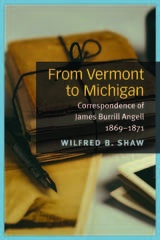 From Vermont to Michigan: Correspondence of James Burrill Angell: 1869-1871
Edited by Wilfred B. Shaw
University of Michigan Press, 1936 From Vermont to Michigan: Correspondence of James Burrill Angell 1869-1871 is a collection of letters edited by Wilfred B. Shaw and published by the University of Michigan Press in 1936. The book provides a detailed account of James Burrill Angell's decision-making process before accepting the presidency of the University of Michigan. It includes correspondence with various individuals, including insights from his son James Rowland Angell in a foreword, capturing Angell's qualities, the consideration of educational standards, and the influence of the New England perspective on the Western frontier. The letters reveal the intricate process and diverse opinions surrounding Angell's eventual acceptance, as well as the initial hesitations and the search for the right candidate. Illustrated and meticulously edited, this compilation serves as a significant historical document, shedding light on the educational landscape of the time and Angell's pivotal role in shaping the future of the University of Michigan.
 From Victimhood to Citizenship: The Path of Roma Integration
Will Guy
Central European University Press, 2013 The disappointing results of over two decades of activism in the supposedly more liberal climate of post-communist democracies prompted András Bíró, Hungarian journalist and renowned human rights activist to put down his reflections about the situation of Roma in Eastern Europe. These thoughts in turn stimulated insightful responses from two scholars of the subject: Nicolae Gheorghe, an ethnic Roma living in Romania, and Martin Kovats, among others special advisor on Roma issues to the European Commission in Brussels.These authors do not shrink from expressing forthright views, as in discussing the apparent conflict between certain human rights values and what some regard as ‘traditional’ Roma culture and in exploring difficulties and ambiguities implicit in using the term ‘Roma’. The respective merits of ethnically based Roma political parties as opposed to a civic approach are also examined.The three essays challenged other stakeholders who discussed the burning issues raised therein at a workshop, the distilled text of which constitutes the fourth chapter of the book. While no straightforward solutions are offered the pre-eminence of the main contributors and the lively ensuing conference arguments guarantee that this book will become a touchstone for future debate in a time when pro-Roma policies are facing ever-growing threats amidst the crisis in Europe.
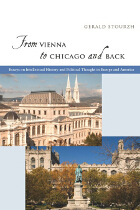 From Vienna to Chicago and Back: Essays on Intellectual History and Political Thought in Europe and America
Gerald Stourzh
University of Chicago Press, 2007 Spanning both the history of the modern West and his own five-decade journey as a historian, Gerald Stourzh’s sweeping new essay collection covers the same breadth of topics that has characterized his career—from Benjamin Franklin to Gustav Mahler, from Alexis de Tocqueville to Charles Beard, from the notion of constitution in seventeenth-century England to the concept of neutrality in twentieth-century Austria.
This storied career brought him in the 1950s from the University of Vienna to the University of Chicago—of which he draws a brilliant picture—and later took him to Berlin and eventually back to Austria. One of the few prominent scholars equally at home with U.S. history and the history of central Europe, Stourzh has informed these geographically diverse experiences and subjects with the overarching themes of his scholarly achievement: the comparative study of liberal constitutionalism and the struggle for equal rights at the core of Western notions of free government. Composed between 1953 and 2005 and including a new autobiographical essay written especially for this volume, From Vienna to Chicago and Back will delight Stourzh fans, attract new admirers, and make an important contribution to transatlantic history.
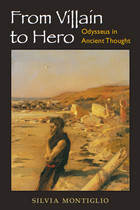 From Villain to Hero: Odysseus in Ancient Thought
Silvia Montiglio
University of Michigan Press, 2011 Praise for Silvia Montiglio "[A] brilliant and important book. . . . "
---Journal of Religion, on Silence in the Land of Logos "[A]n invigorating reevaluation of both the ancient symbolic landscape and our preconceptions of it."
---American Journal of Philology, on Wandering in Ancient Greek Culture
Best known for his adventures during his homeward journey as narrated in Homer's Odyssey, Odysseus remained a major figure and a source of inspiration in later literature, from Greek tragedy to Dante's Inferno to Joyce's Ulysses. Less commonly known, but equally interesting, are Odysseus' "wanderings" in ancient philosophy: Odysseus becomes a model of wisdom for Socrates and his followers, Cynics and Stoics, as well as for later Platonic thinkers. From Villain to Hero: Odysseus in Ancient Thought follows these wanderings in the world of ancient Greek and Roman philosophy, retracing the steps that led the cunning hero of Homeric epic and the villain of Attic tragedy to become a paradigm of the wise man. From Villain to Hero explores the reception of Odysseus in philosophy, a subject that so far has been treated only in tangential or limited ways. Diverging from previous studies, Montiglio outlines the philosophers' Odysseus across the spectrum, from the Socratics to the Middle Platonists. By the early centuries CE, Odysseus' credentials as a wise man are firmly established, and the start of Odysseus' rehabilitation by philosophers challenges current perceptions of him as a villain. More than merely a study in ancient philosophy, From Villain to Hero seeks to understand the articulations between philosophical readings of Odysseus and nonphilosophical ones, with an eye to the larger cultural contexts of both. While this book is the work of a classicist, it will also be of interest to students of philosophy, comparative literature, and reception studies.
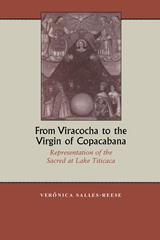 From Viracocha to the Virgin of Copacabana: Representation of the Sacred at Lake Titicaca
By Verónica Salles-Reese
University of Texas Press, 1997 Surrounded by the peaks of the Andean cordillera, the deep blue waters of Lake Titicaca have long provided refreshment and nourishment to the people who live along its shores. From prehistoric times, the Andean peoples have held Titicaca to be a sacred place, the source from which all life originated and the site where the divine manifests its presence. In this interdisciplinary study, Verónica Salles-Reese explores how Andean myths of cosmic and ethnic origins centered on Lake Titicaca evolved from pre-Inca times to the enthronement of the Virgin of Copacabana in 1583. She begins by describing the myths of the Kolla (pre-Inca) people and shows how their Inca conquerors attempted to establish legitimacy by reconciling their myths of cosmic and ethnic origin with the Kolla myths. She also shows how a similar pattern occurred when the Inca were conquered in turn by the Spanish. This research explains why Lake Titicaca continues to occupy a central place in Andean thought despite the major cultural disruptions that have characterized the region's history. This book will be a touchstone in the field of Colonial literature and an important reference for Andean religious and intellectual history.
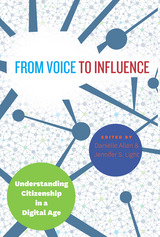 From Voice to Influence: Understanding Citizenship in a Digital Age
Edited by Danielle Allen and Jennifer S. Light
University of Chicago Press, 2015 How have online protests—like the recent outrage over the Komen Foundation’s decision to defund Planned Parenthood—changed the nature of political action? How do Facebook and other popular social media platforms shape the conversation around current political issues? The ways in which we gather information about current events and communicate it with others have been transformed by the rapid rise of digital media. The political is no longer confined to the institutional and electoral arenas, and that has profound implications for how we understand citizenship and political participation.
With From Voice to Influence, Danielle Allen and Jennifer S. Light have brought together a stellar group of political and social theorists, social scientists, and media analysts to explore this transformation. Threading through the contributions is the notion of egalitarian participatory democracy, and among the topics discussed are immigration rights activism, the participatory potential of hip hop culture, and the porous boundary between public and private space on social media. The opportunities presented for political efficacy through digital media to people who otherwise might not be easily heard also raise a host of questions about how to define “good participation:” Does the ease with which one can now participate in online petitions or conversations about current events seduce some away from serious civic activities into “slacktivism?”
Drawing on a diverse body of theory, from Hannah Arendt to Anthony Appiah, From Voice to Influence offers a range of distinctive visions for a political ethics to guide citizens in a digitally connected world.
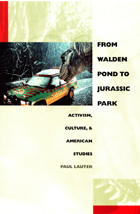 From Walden Pond to Jurassic Park: Activism, Culture, and American Studies
Paul Lauter
Duke University Press, 2001 Paul Lauter, an icon of American Studies who has been a primary agent in its transformation and its chief ambassador abroad, offers a wide-ranging collection of essays that demonstrate and reflect on this important and often highly politicized discipline. While American Studies was formerly seen as a wholly subsidiary academic program that loosely combined the study of American history, literature, and art, From Walden Pond to Jurassic Park reveals the evolution of an independent, highly interdisciplinary program with distinctive subjects, methods, and goals that are much different than the traditional academic departments that nurtured it.
With anecdote peppered discussions ranging from specific literary texts and movies to the future of higher education and the efficacy of unions, From Walden Pond to Jurassic Park entertains even as it offers a twenty-first century account of how and why Americanists at home and abroad now do what they do. Drawing on his forty-five years of teaching and research as well as his experience as a political activist and a cultural radical, Lauter shows how a multifaceted increase in the United States’ global dominion has infused a particular political urgency into American Studies. With its military and economic influence, its cultural and linguistic reach, the United States is—for better or for worse—too formidable and potent not to be understood clearly and critically.
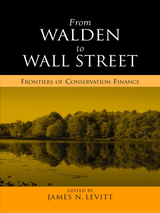 From Walden to Wall Street: Frontiers of Conservation Finance
Edited by James N. Levitt; Lincoln Institute of Land Policy
Island Press, 2005 In the absence of innovation in the field of conservation finance, a daunting funding gap faces conservationists aiming to protect America's system of landscapes that provide sustainable resources, water, wildlife habitat, and recreational amenities. Experts estimate that the average annual funding gap will be between $1.9 billion and $7.7 billion over the next forty years. Can the conservation community come up with new methods for financing that will fill this enormous gap? Which human and financial resources will allow us to fund critical land conservation needs? From Walden to Wall Street brings together the experience of more than a dozen pioneering conservation finance practitioners to address these crucial issues. Contributors present groundbreaking ideas including mainstreaming environmental markets; government ballot measures for land conservations; convertible tax-exempt financing; and private equity markets. The creativity and insight of From Walden to Wall Street offers considerable hope that, even in this era of widespread financial constraints, the American conservation community's financial resources may potentially grow dramatically in both quantity and quality in the decades to come.
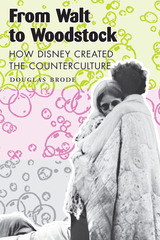 From Walt to Woodstock: How Disney Created the Counterculture
By Douglas Brode
University of Texas Press, 2004 With his thumbprint on the most ubiquitous films of childhood, Walt Disney is widely considered to be the most conventional of all major American moviemakers. The adjective "Disneyfied" has become shorthand for a creative work that has abandoned any controversial or substantial content to find commercial success. But does Disney deserve that reputation? Douglas Brode overturns the idea of Disney as a middlebrow filmmaker by detailing how Disney movies played a key role in transforming children of the Eisenhower era into the radical youth of the Age of Aquarius. Using close readings of Disney projects, Brode shows that Disney's films were frequently ahead of their time thematically. Long before the cultural tumult of the sixties, Disney films preached pacifism, introduced a generation to the notion of feminism, offered the screen's first drug-trip imagery, encouraged young people to become runaways, insisted on the need for integration, advanced the notion of a sexual revolution, created the concept of multiculturalism, called for a return to nature, nourished the cult of the righteous outlaw, justified violent radicalism in defense of individual rights, argued in favor of communal living, and encouraged antiauthoritarian attitudes. Brode argues that Disney, more than any other influence in popular culture, should be considered the primary creator of the sixties counterculture—a reality that couldn't be further from his "conventional" reputation.
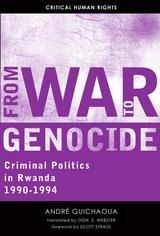 From War to Genocide: Criminal Politics in Rwanda, 1990–1994
André Guichaoua, Translated by Don E. Webster, Foreword by Scott Straus
University of Wisconsin Press, 2017 In April 1994 Rwanda exploded in violence, with political, social, and economic divisions most visible along ethnic lines of the Hutu and Tutsi factions. The ensuing killings resulted in the deaths of as much as 20 percent of Rwanda's population. André Guichaoua, who was present as the genocide began, unfolds a complex story with multiple actors, including three major political parties that each encompassed a spectrum of positions, all reacting to and influencing a rapidly evolving situation. Economic polarities, famine-fueled privation, clientelism, corruption, north-south rivalries, and events in the neighboring nations of Burundi and Uganda all deepened ethnic tensions, allowing extremists to prevail over moderates.
Guichaoua draws on years of meticulous research to describe and analyze this history. He emphasizes that the same virulent controversies that fueled the conflict have often influenced judicial, political, and diplomatic responses to it, reproducing the partisan cleavages between the former belligerents and implicating state actors, international institutions, academics, and the media. Guichaoua insists upon the imperative of absolute intellectual independence in pursuing the truth about some of the gravest human rights violations of the twentieth century.
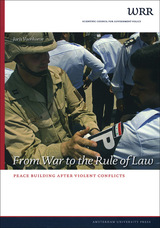 From War to the Rule of Law: Peace Building after Violent Conflicts
Joris Voorhoeve
Amsterdam University Press, 2007
As recent events in Iraq demonstrate, countries that have suffered through civil war or rule by military regime can face a long, difficult transition to peaceful democracy.
Drawing on the experiences of peacekeepers in Bosnia, Haiti, Rwanda, and Afghanistan, From War to Rule of Law demonstrates that newly emerging democracies may need much more than emergency economic support. Restoring the rule of law, Joris Voorhoeve shows, can involve the training of a new police force, for example, or the creation of an international war crimes tribunal. Any disregard for human rights or delay in civilian reconciliation can lead to serious resurgences in violence.
Voorhoeve concludes by offering specific recommendations for members of the United Nations and the European Union, as well as individual donors. Given the nature of today’s armed conflicts, From War to Rule of Law provides new hope for all those concerned about the lasting success of international peacekeeping missions.
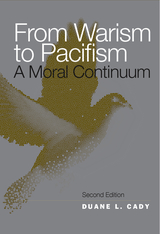 From Warism to Pacifism: A Moral Continuum
Authored by Duane Cady
Temple University Press, 2010 Duane Cady views warism and pacifism as polar extremes on a continuum that embraces a full spectrum of ethical positions on the morality of war and peace. Realizing that he could not intellectually defend the notions of just-war theory, he found that he was a reluctant pacifist. In this new edition of From Warism to Pacifism, Cady continues to expose the pervasive, subconscious warism that is the dominant ideology in modern Western culture. He explores the changes over the last twenty years—from the end of the Cold War to the ongoing “war on terror,” as well as Barack Obama winning the Nobel Prize for Peace. Like racism and sexism, the uncritical presumption that war is morally justifiable, even morally required, misguides our attitudes and institutions. In its place, Cady proposes the development of a positive concept of peace. Citing common objections to pacifist values, he describes peace as something more than the mere absence of war and demonstrates that pacifism is a defensible position.
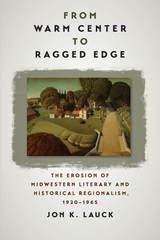 From Warm Center to Ragged Edge: The Erosion of Midwestern Literary and Historical Regionalism, 1920-1965
Jon K. Lauck
University of Iowa Press, 2017 During the half-century after the Civil War, intellectuals and politicians assumed the Midwest to be the font and heart of American culture. Despite the persistence of strong currents of midwestern regionalism during the 1920s and 1930s, the region went into eclipse during the post–World War II era. In the apt language of Minnesota’s F. Scott Fitzgerald, the Midwest slid from being the “warm center” of the republic to its “ragged edge.”
This book explains the factors that triggered the demise of the Midwest’s regionalist energies, from anti-midwestern machinations in the literary world and the inability of midwestern writers to break through the cultural politics of the era to the growing dominance of a coastal, urban culture. These developments paved the way for the proliferation of images of the Midwest as flyover country, the Rust Belt, a staid and decaying region. Yet Lauck urges readers to recognize persisting and evolving forms of midwestern identity and to resist the forces that squelch the nation’s interior voices.
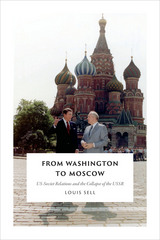 From Washington to Moscow: US-Soviet Relations and the Collapse of the USSR
Louis Sell
Duke University Press, 2016 When the United States and the Soviet Union signed the first Strategic Arms Limitation Talks accords in 1972 it was generally seen as the point at which the USSR achieved parity with the United States. Less than twenty years later the Soviet Union had collapsed, confounding experts who never expected it to happen during their lifetimes. In From Washington to Moscow veteran US Foreign Service officer Louis Sell traces the history of US–Soviet relations between 1972 and 1991 and explains why the Cold War came to an abrupt end. Drawing heavily on archival sources and memoirs—many in Russian—as well as his own experiences, Sell vividly describes events from the perspectives of American and Soviet participants. He attributes the USSR's fall not to one specific cause but to a combination of the Soviet system's inherent weaknesses, mistakes by Mikhail Gorbachev, and challenges by Ronald Reagan and other US leaders. He shows how the USSR's rapid and humiliating collapse and the inability of the West and Russia to find a way to cooperate respectfully and collegially helped set the foundation for Vladimir Putin’s rise.
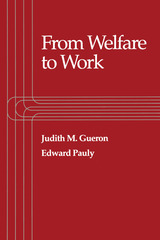 From Welfare to Work
Judith M. Gueron
Russell Sage Foundation, 1991 From Welfare to Work appears at a critical moment, when all fifty states are wrestling with tough budgetary and program choices as they implement the new federal welfare reforms. This book is a definitive analysis of the landmark social research that has directly informed those choices: the rigorous evaluation of programs designed to help welfare recipients become employed and self-sufficient. It discusses forty-five past and current studies, focusing on the series of seminal evaluations conducted by the Manpower Demonstration Research Corporation over the last fifteen years. Which of these welfare-to-work programs have worked? For whom and at what cost? In answering these key questions, the authors clearly delineate the trade-offs facing policymakers as they strive to achieve the multiple goals of alleviating poverty, helping the most disadvantaged, curtailing dependence, and effecting welfare savings. The authors present compelling evidence that the generally low-cost, primarily job search-oriented programs of the late 1980s achieved sustained earnings gains and welfare savings. However, getting people out of poverty and helping those who are most disadvantaged may require some intensive, higher-cost services such as education and training. The authors explore a range of studies now in progress that will address these and other urgent issues. They also point to encouraging results from programs that were operating in San Diego and Baltimore, which suggest the potential value of a mixed strategy: combining job search and other low-cost activities for a broad portion of the caseload with more specialized services for smaller groups. Offering both an authoritative synthesis of work already done and recommendations for future innovation, From Welfare to Work will be the standard resource and required reading for practitioners and students in the social policy, social welfare, and academic communities.
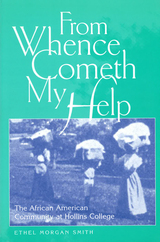 From Whence Cometh My Help: The African American Community at Hollins College
Ethel Morgan Smith
University of Missouri Press, 2000
In 1842 Charles Lewis Cocke arrived in Roanoke, Virginia, with sixteen slaves; there, he founded Hollins College, an elite woman's school. Many of the early students also brought their slaves to the college with them. Upon Emancipation some of the African Americans of the community "mostly women" stayed on as servants, forming what is now called the Hollins Community. Although the servants played an integral part in the college's success, students were strongly discouraged from acknowledging them as people. Rules forbidding any "familiarity" with the servants perpetuated a prejudicial attitude toward the African American community that would persist well into the 1940s.
Determined to give voice to the African American community that served as the silent workforce for Hollins College, Ethel Morgan Smith succeeded in finding individuals to step forward and tell their stories. From Whence Cometh My Help examines the dynamics of an institution built on the foundations of slavery and so steeped in tradition that it managed to perpetuate servitude for generations. Interviewing senior community members, Smith gives recognition to the invisible population that provided and continues to provide the labor support for Hollins College for more than 150 years.
Although African American students have been admitted to the college for roughly thirty years, to date only one person from the Hollins Community has graduated from the college. From Whence Cometh My Help explores the subtle and complex relationship between the affluent white world of Hollins College and the proud African American community that has served it since its inception. Interweaving personal observations, historical documents, and poetry throughout a revealing oral history, Smith shares her fascinating discoveries and the challenges involved in telling a story silenced for so long.
 From White Dwarfs to Black Holes: The Legacy of S. Chandrasekhar
Edited by G. Srinivasan
University of Chicago Press, 1999 From White Dwarfs to Black Holes chronicles the extraordinarily productive scientific career of Subrahmanyan Chandrasekhar, one of the twentieth century's most distinguished astrophysicists. Among Chandrasekhar's many discoveries were the critical mass that makes a star too massive to become a white dwarf and the mathematical theory of black holes. In 1983 he shared the Nobel Prize for Physics for these and other achievements.
Over the course of more than six decades of active research Chandrasekhar investigated a dizzying array of subjects. G. Srinivasan notes in the preface to this book that "the range of Chandra's contributions is so vast that no one person in the physics or astronomy community can undertake the task of commenting on his achievements." Thus, in this collection, ten eminent scientists evaluate Chandrasekhar's contributions to their own fields of specialization. Donald E. Osterbrock closes the volume with a historical discussion of Chandrasekhar's interactions with graduate students during his more than quarter century at Yerkes Observatory.
Contributors are James Binney, John L. Friedman, Norman R. Lebovitz, Donald E. Osterbrock, E. N. Parker, Roger Penrose, A. R. P. Rau, George B. Rybicki, E. E. Salpeter, Bernard F. Schutz, and G. Srinivasan.
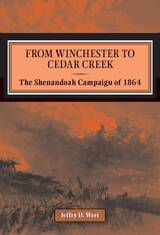 From Winchester to Cedar Creek: The Shenandoah Campaign of 1864
Jeffry D. Wert
Southern Illinois University Press, 2010 In the Shenandoah Valley campaign of 1864, U.S. Major General Philip H. Sheridan led his army to a series of decisive victories for the Union over Lieutenant General Jubal A. Early and the Confederate Army of the Valley. In From Winchester to Cedar Creek, author Jeffry D. Wert highlights Sheridan’s victories in the critical area of the Virginia Valley as defining moments of the Civil War. Sheridan’s campaign ensured Confederate defeat in Virginia and ultimately contributed to Lincoln’s reelection and the Union’s victory in the Civil War. Drawing on manuscript collections and many published sources, Wert offers vivid descriptions of the battles of Third Winchester, Fisher’s Hill, Tom’s Brook, and Cedar Creek. The book also explores how the interplay of the strengths and weaknesses of the Union and Confederate commanders, Sheridan and Early, resulted in victories for Sheridan’s Army of the Shenandoah. Grounded in detailed research, Wert’s compelling narrative portrays the military strategies these commanders employed and how their tactical decisions impacted civilian sacrifice in the Valley. First published in 1987, Wert’s chronicle remains the definitive book on Sheridan’s command and the Shenandoah Campaign of 1864. Offering a balanced treatment of both Union and Confederate experiences during the campaign, Wert emphasizes its importance as a turning point in the war from both military and civilian points of view. Supplemented with situation maps and photographs, From Winchester to Cedar Creek not only documents and dynamically recounts the events that unfolded in the summer and fall of 1864 in the Virginia Valley, but it also details the political, strategic, and tactical forces that made the Shenandoah Valley campaign so important to the outcome of the Civil War.
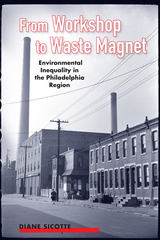 From Workshop to Waste Magnet: Environmental Inequality in the Philadelphia Region
Sicotte, Diane
Rutgers University Press, 2016 Like many industrialized regions, the Philadelphia metro area contains pockets of environmental degradation: neighborhoods littered with abandoned waste sites, polluting factories, and smoke-belching incinerators. However, other neighborhoods within and around the city are relatively pristine. This eye-opening book reveals that such environmental inequalities did not occur by chance, but were instead the result of specific policy decisions that served to exacerbate endemic classism and racism. From Workshop to Waste Magnet presents Philadelphia’s environmental history as a bracing case study in mismanagement and injustice. Sociologist Diane Sicotte digs deep into the city’s past as a titan of American manufacturing to trace how only a few communities came to host nearly all of the area’s polluting and waste disposal land uses. By examining the complex interactions among economic decline, federal regulations, local politics, and shifting ethnic demographics, she not only dissects what went wrong in Philadelphia but also identifies lessons for environmental justice activism today. Sicotte’s research tallies both the environmental and social costs of industrial pollution, exposing the devastation that occurs when mass quantities of society’s wastes mix with toxic levels of systemic racism and economic inequality. From Workshop to Waste Magnet is a compelling read for anyone concerned with the health of America’s cities and the people who live in them.
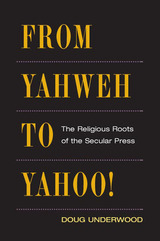 From Yahweh to Yahoo!: The Religious Roots of the Secular Press
Doug Underwood
University of Illinois Press, 2001 Presenting religion as journalism's silent partner, From Yahweh to Yahoo!provides a fresh and surprising view of the religious impulses at work in contemporary newsrooms. Focusing on how the history of religion in the United States entwines with the growth of the media, Doug Underwood argues that American journalists draw from the nation's moral and religious heritage and operate, in important ways, as personifications of the old religious virtues. Underwood traces religion's influence on mass communication from the biblical prophets to the Protestant Reformation, from the muckraker and Social Gospel campaigns of the late nineteenth and early twentieth centuries to the modern age of mass media. While forces have pushed journalists away from identifying themselves with religion, they still approach such secular topics as science, technology, and psychology in reverential ways. Underwood thoughtful analysis covers the press's formulaic coverage of spiritual experience, its failure to cover new and non-Christian religions in America, and the complicity of the mainstream media in launching the religious broadcasting movement.
The Fronde
Paul Rice Doolin
Harvard University Press Dr Doolin’s investigation of the Fronde, the civil war in France from 1648 to 1653, is based upon a great mass of unused but well-known material, the so-called Mazarinades, a series of pamphlets that appeared during the war. Although his sympathy lies with the opposition rather than with the government, he carefully avoids an apologetic tone, describes events without comment, and analyzes the statements of both parties without bias. He demonstrates that very important political principles were at stake: despotism to the ends of peace and glory (the government) against a polity of divided authority under law to the end of justice and the Christian life (the opposition).
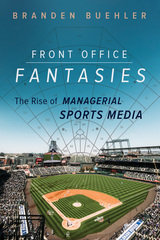 Front Office Fantasies: The Rise of Managerial Sports Media
Branden Buehler
University of Illinois Press, 2023 The new sports frontier that turns fans into would-be execs—and transforms the suits into superstars Front office executives have become high-profile commentators, movie and video game protagonists, and role models for a generation raised in the data-driven, financialized world of contemporary sports. Branden Buehler examines the media transformation of these once obscure management figures into esteemed experts and sporting idols. Moving from Moneyball and Football Manager to coverage of analytics gurus like Daryl Morey, Buehler shows how a fixation on managerial moves has taken hold across the entire sports media landscape. Buehler’s chapter-by-chapter look at specific media forms illustrates different facets of the managerial craze while analyzing the related effects on what fans see, hear, and play. Throughout, Buehler explores the unsettling implications of exalting the management class and its logics, in the process arguing that sports media’s managerial lionization serves as one of the clearest reflections of major material and ideological changes taking place across culture and society. Insightful and timely, Front Office Fantasies reveals how sports media moved the action from the field to the executive suite.
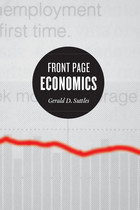 Front Page Economics
Gerald D. Suttles, with Mark D. Jacobs
University of Chicago Press, 2010 In an age when pundits constantly decry overt political bias in the media, we have naturally become skeptical of the news. But the bluntness of such critiques masks the highly sophisticated ways in which the media frame important stories. In Front Page Economics, Gerald Suttles delves deep into the archives to examine coverage of two major economic crashes—in 1929 and 1987—in order to systematically break down the way newspapers normalize crises.
Poring over the articles generated by the crashes—as well as the people in them, the writers who wrote them, and the cartoons that ran alongside them—Suttles uncovers dramatic changes between the ways the first and second crashes were reported. In the intervening half-century, an entire new economic language had arisen and the practice of business journalism had been completely altered. Both of these transformations, Suttles demonstrates, allowed journalists to describe the 1987 crash in a vocabulary that was normal and familiar to readers, rendering it routine.
A subtle and probing look at how ideologies are packaged and transmitted to the casual newspaper reader, Front Page Economics brims with important insights that shed light on our own economically tumultuous times.
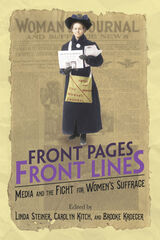 Front Pages, Front Lines: Media and the Fight for Women's Suffrage
Edited by Linda Steiner, Carolyn Kitch, and Brooke Kroeger
University of Illinois Press, 2020 Suffragists recognized that the media played an essential role in the women's suffrage movement and the public's understanding of it. From parades to going to jail for voting, activists played to the mass media of their day. They also created an energetic niche media of suffragist journalism and publications. This collection offers new research on media issues related to the women's suffrage movement. Contributors incorporate media theory, historiography, and innovative approaches to social movements while discussing the vexed relationship between the media and debates over suffrage. Aiming to correct past oversights, the essays explore overlooked topics such as coverage by African American and Mormon-oriented media, media portrayals of black women in the movement, suffragist rhetorical strategies, elites within the movement, suffrage as part of broader campaigns for social transformation, and the influence views of white masculinity had on press coverage. Contributors: Maurine H. Beasley, Sherilyn Cox Bennion, Jinx C. Broussard, Teri Finneman, Kathy Roberts Forde, Linda M. Grasso, Carolyn Kitch, Brooke Kroeger, Linda J. Lumsden, Jane Marcellus, Jane Rhodes, Linda Steiner, and Robin Sundaramoorthy
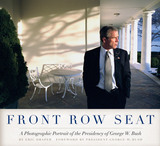 Front Row Seat: A Photographic Portrait of the Presidency of George W. Bush
By Eric Draper
University of Texas Press, 2013 America’s forty-third president, George W. Bush, presided over eight of the most dramatic years in recent history, from the 9/11 attacks early in his administration to the worldwide economic crisis of 2008. By his side, recording every event from the momentous to the intimate, was his personal White House photographer, Eric Draper. From a collection of nearly one million photographs, Draper has selected more than one hundred images of President Bush that portray both the public figure and the private man. Front Row Seat presents a compelling, behind-the-scenes view of the presidency of George W. Bush. Through Draper’s lens, we follow Bush through moments of crisis that called for strong leadership, such as 9/11; emotional meetings with troops in war zones, wounded soldiers at home, and Katrina survivors; and happy, relaxed times with his wife Laura, daughters Barbara and Jenna, and parents President George H. W. and Barbara Bush. We also see Bush at work within his inner circle of trusted advisors, including Vice President Richard Cheney, National Security Advisor and Secretary of State Condoleezza Rice, and Secretary of Defense Donald Rumsfeld. Capturing moments that reveal the essence of the man, Front Row Seat is an irreplaceable portrait of George W. Bush.
|
|
